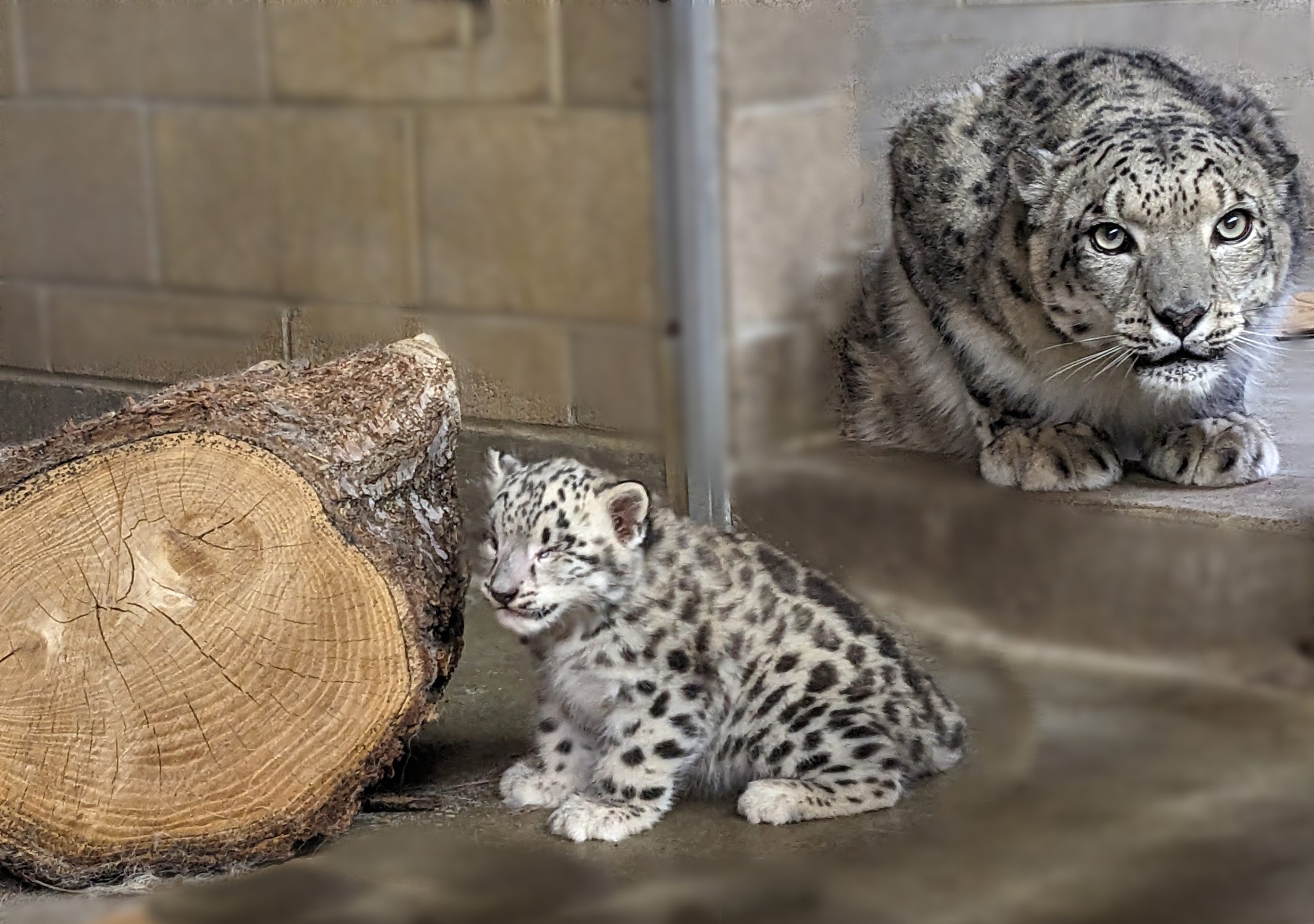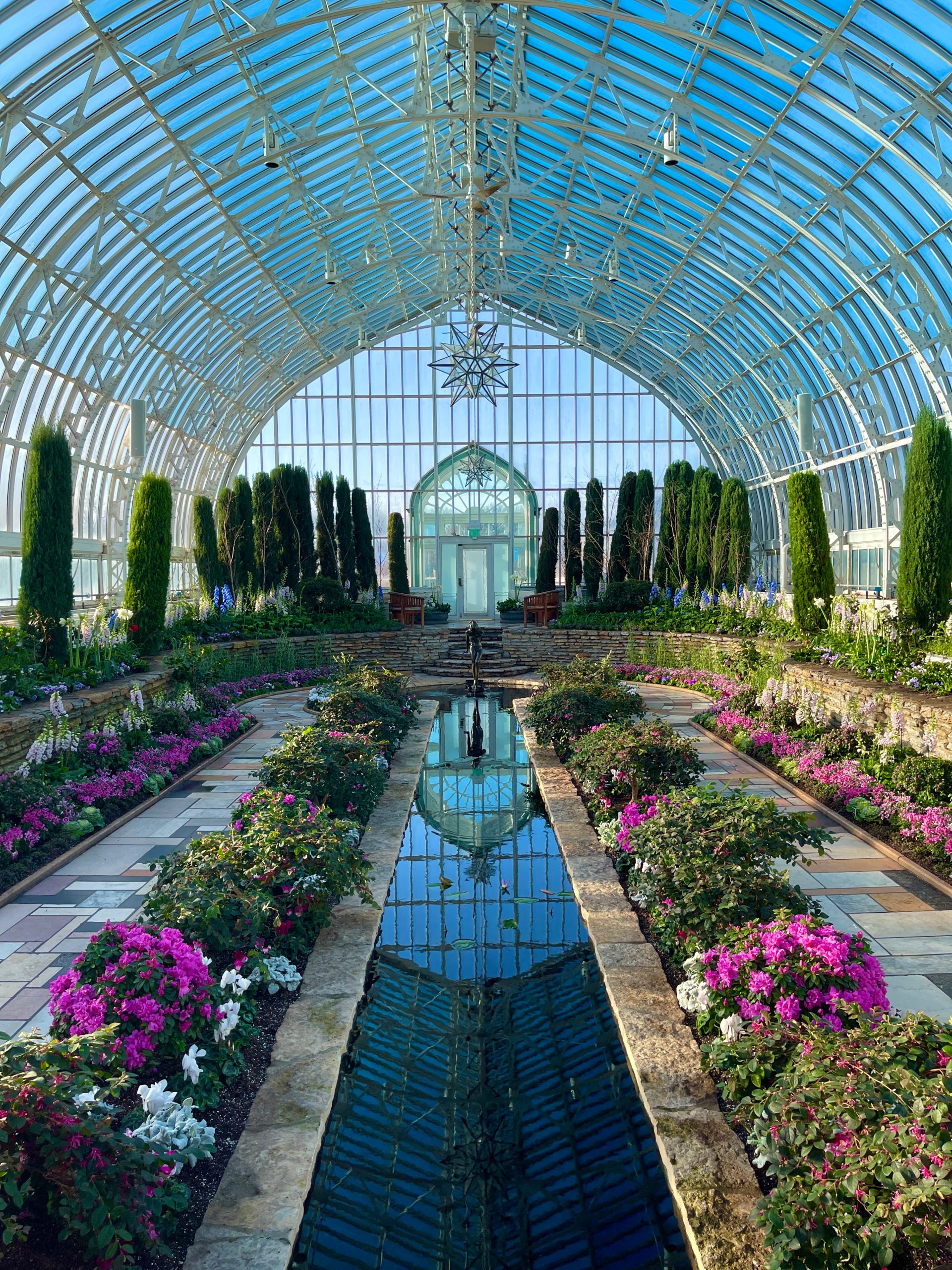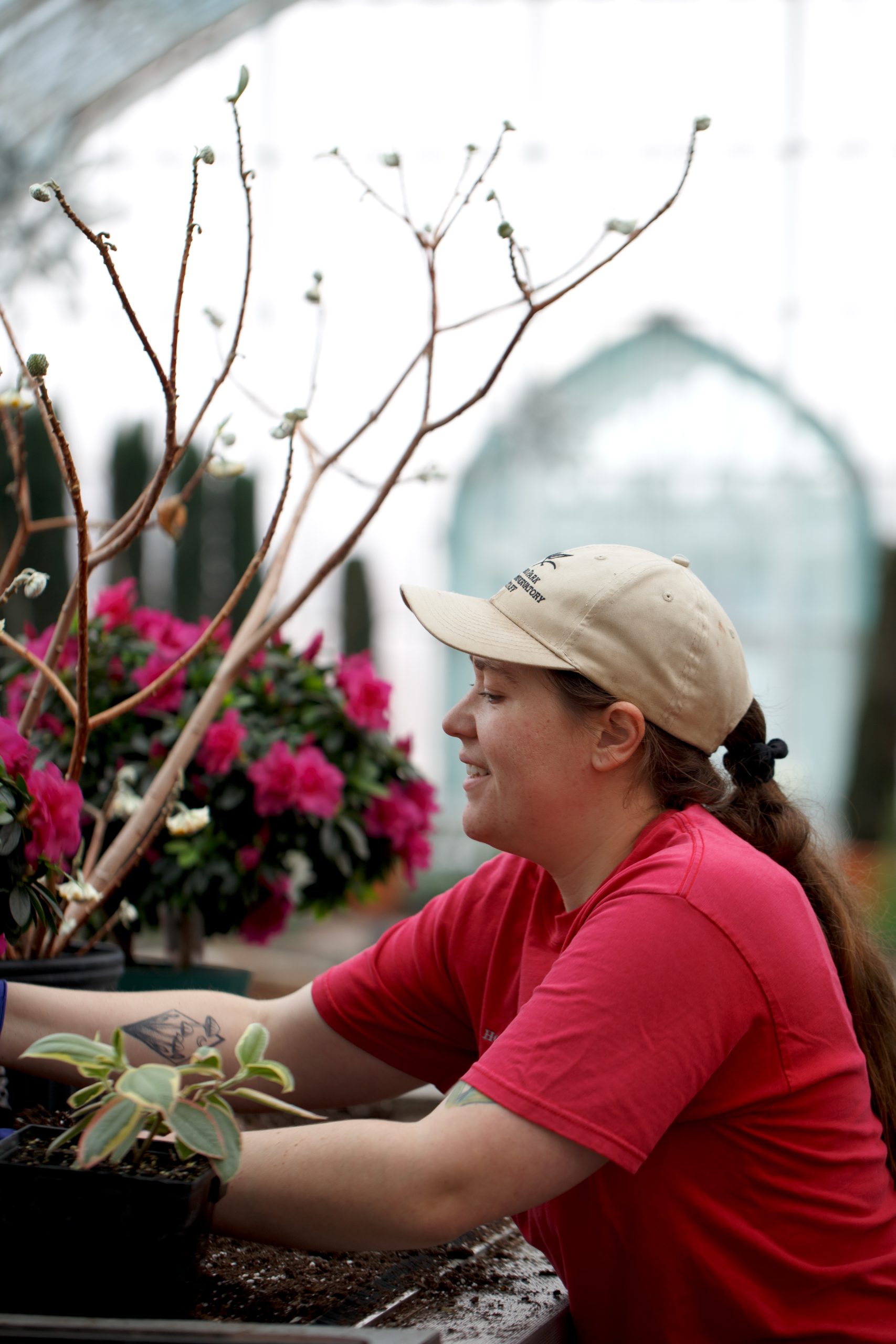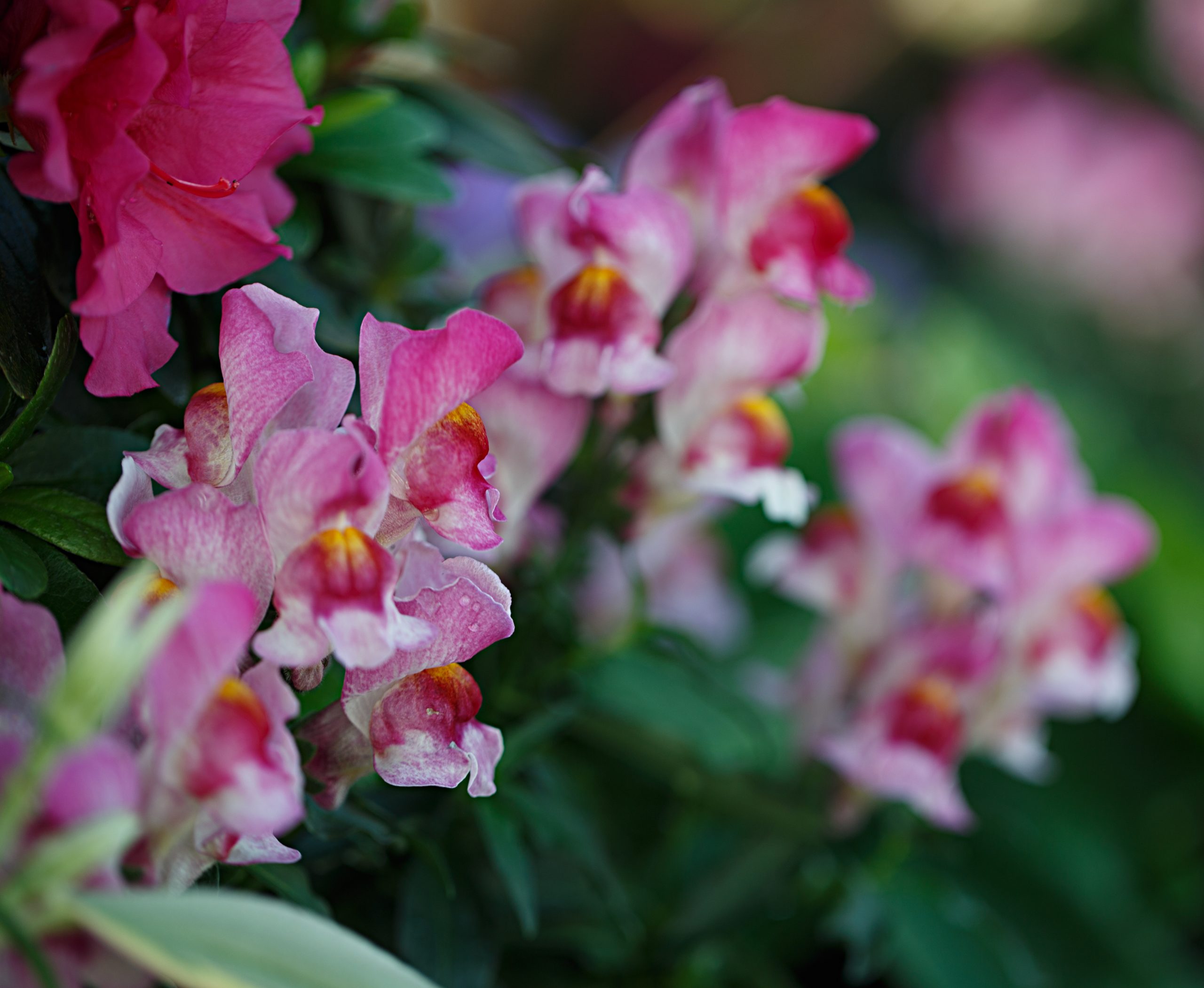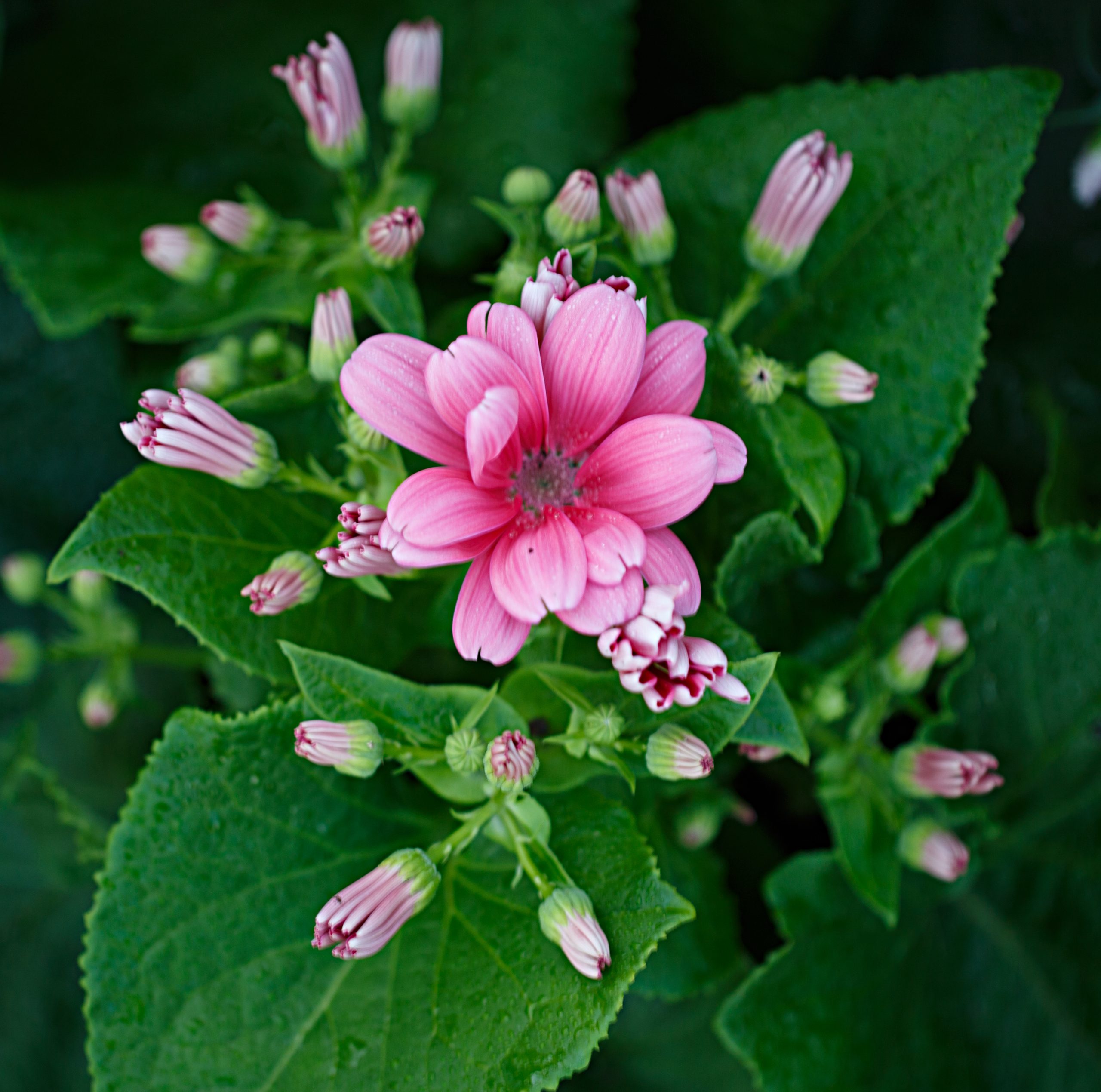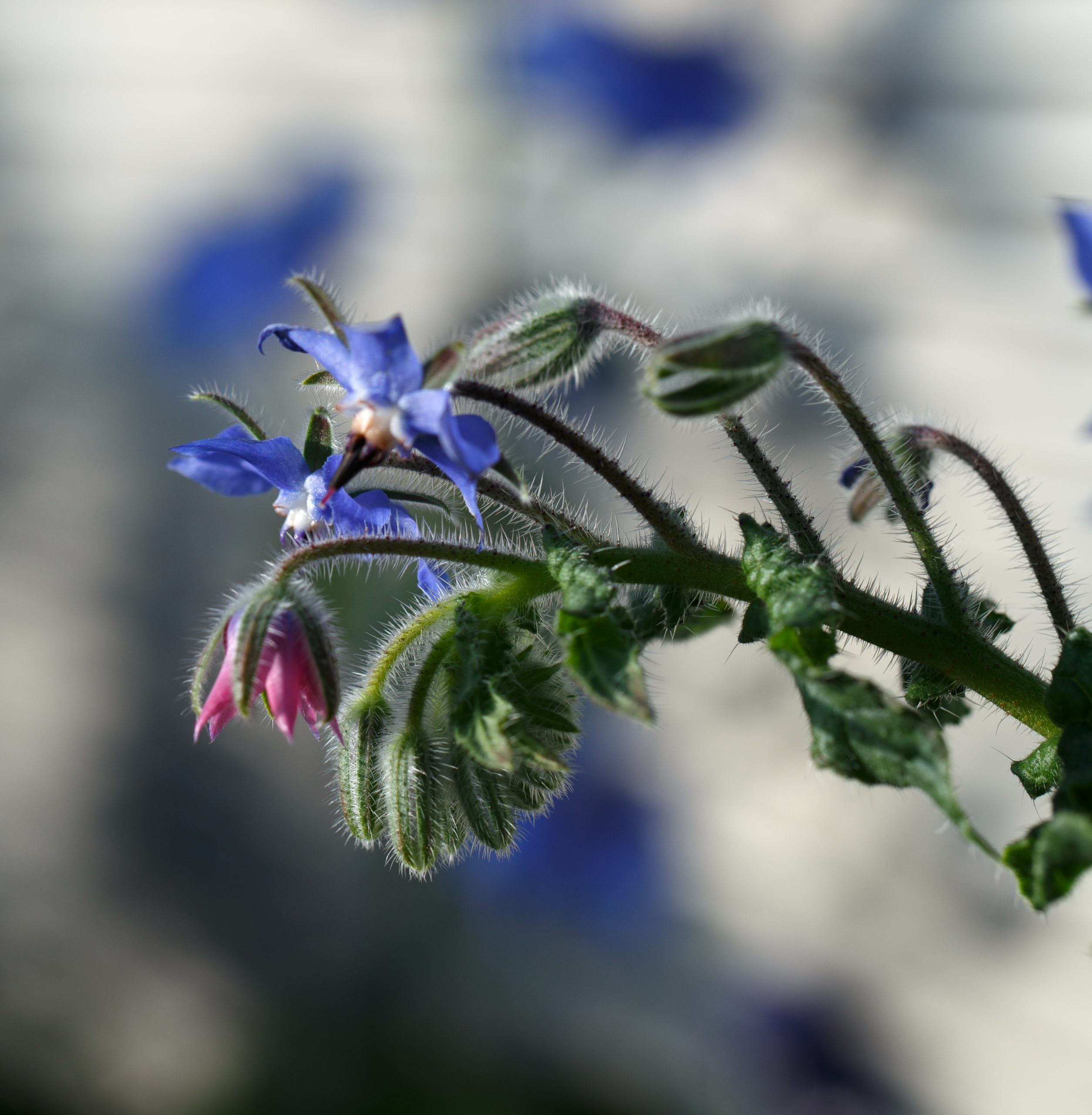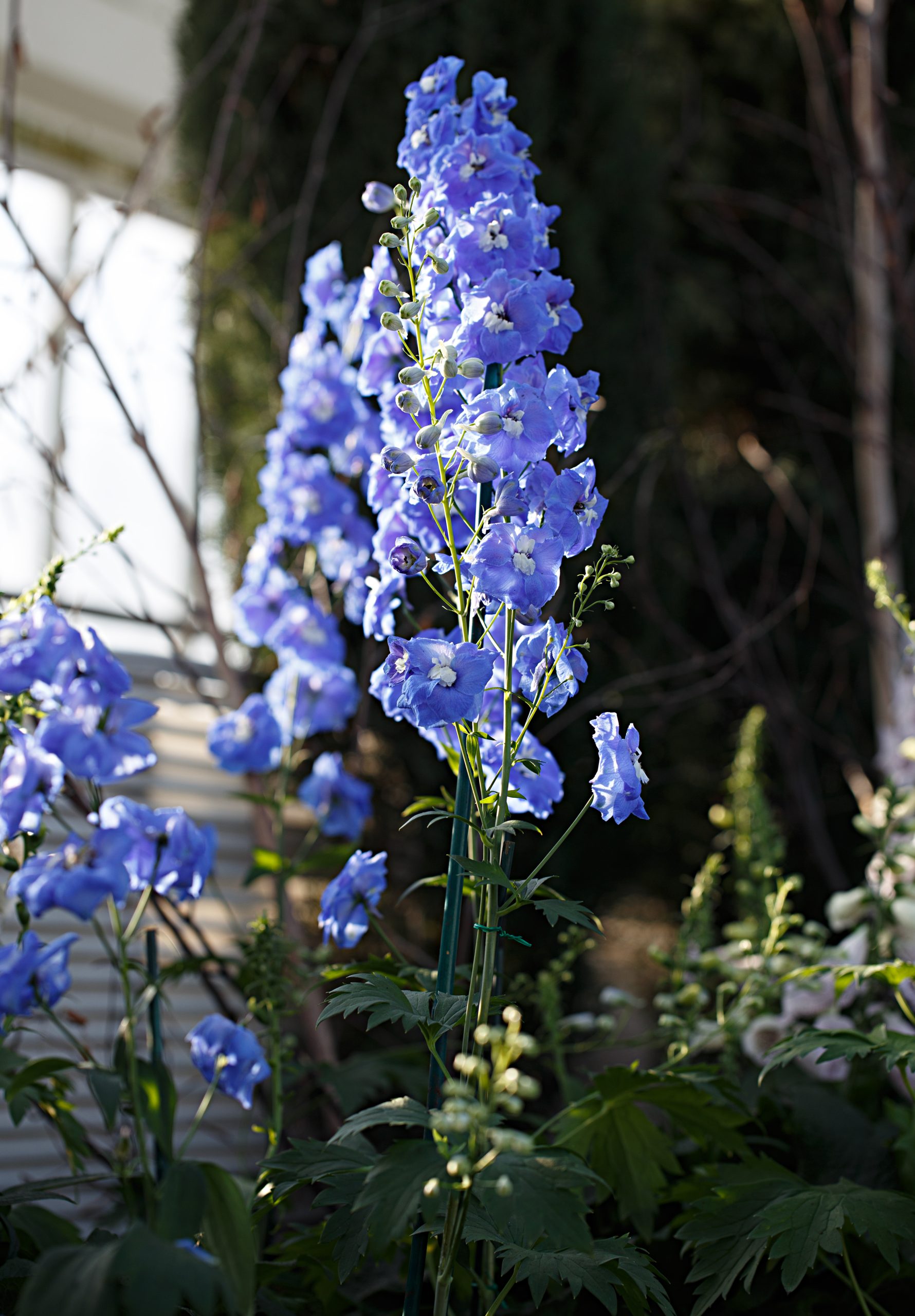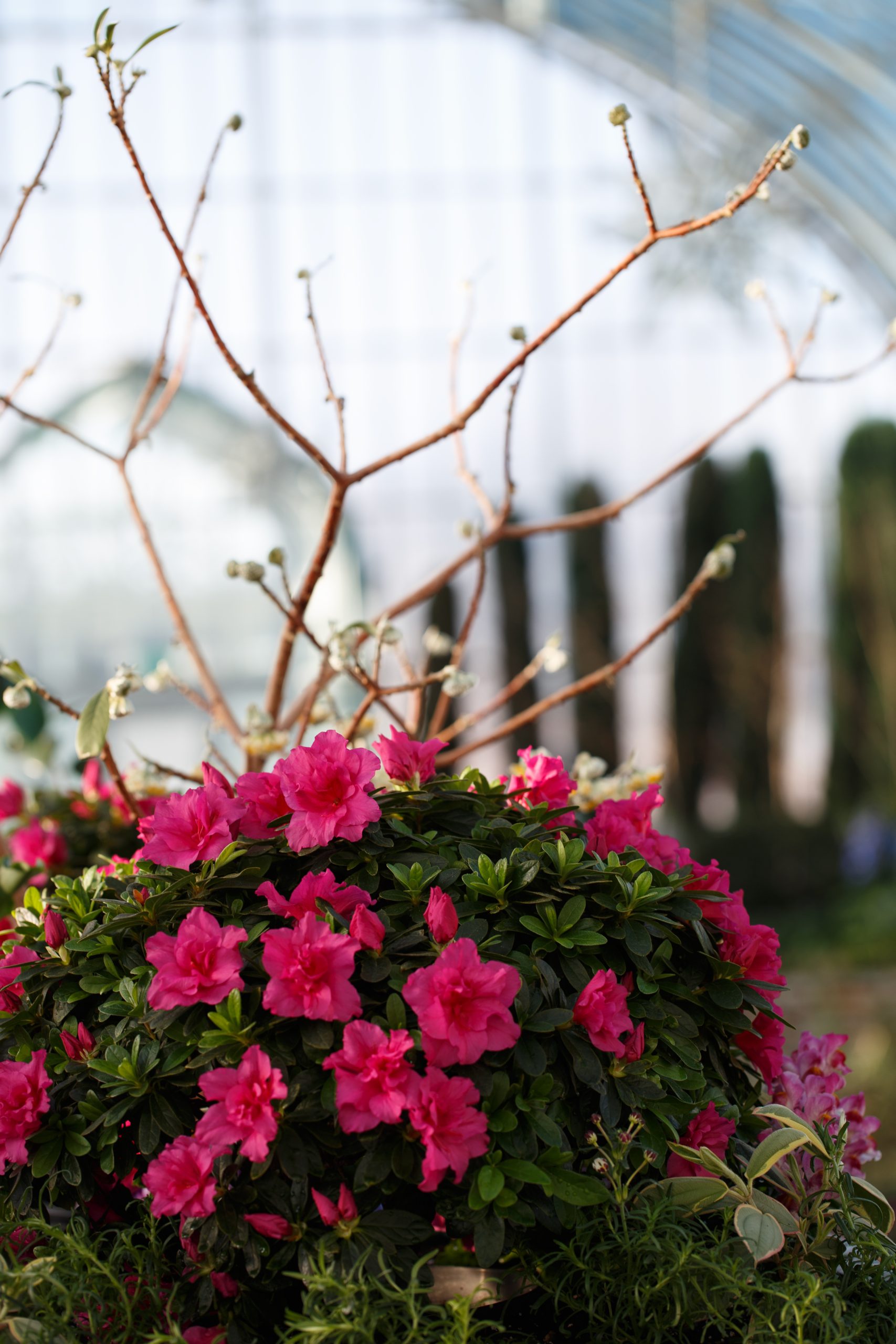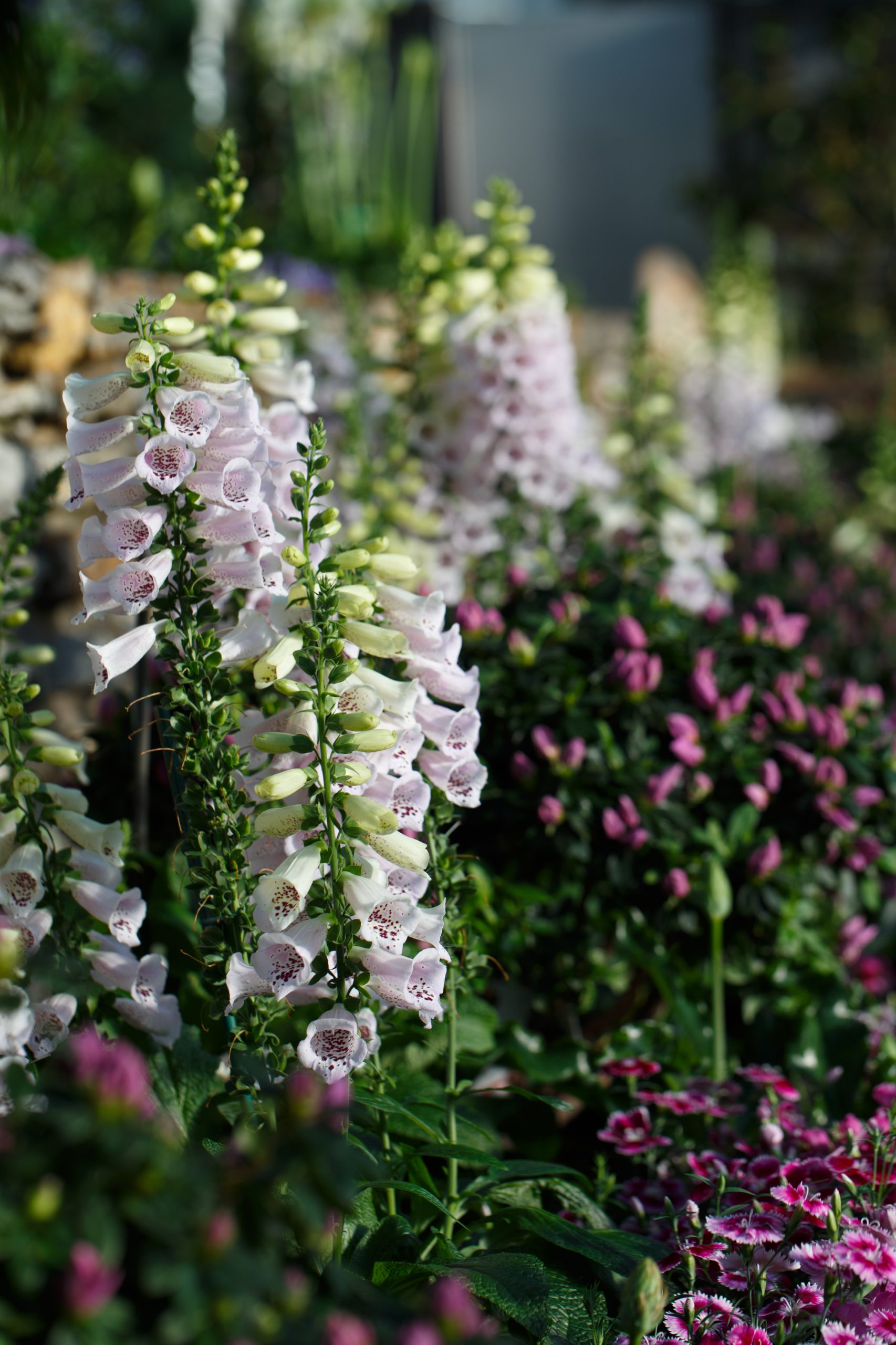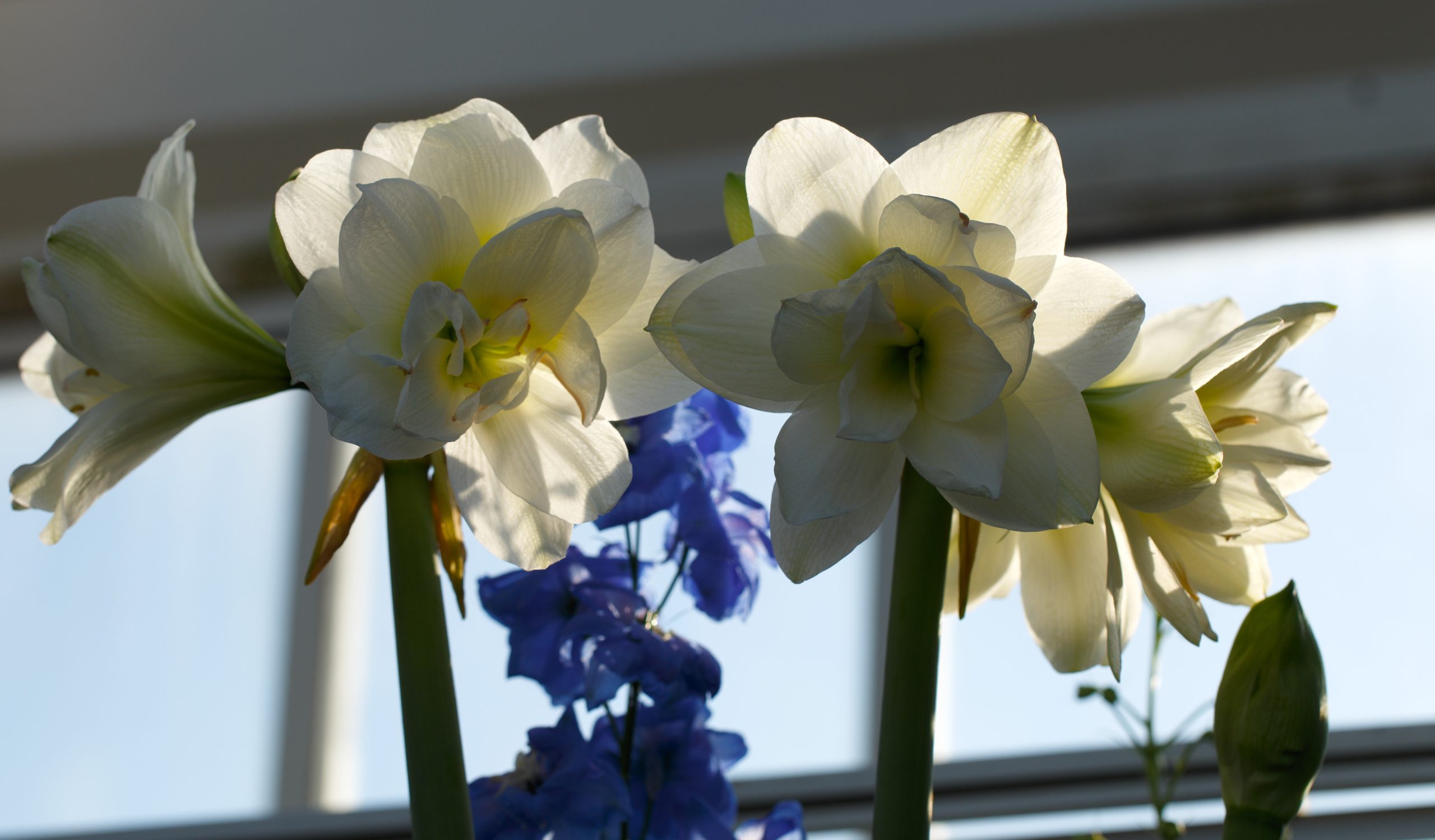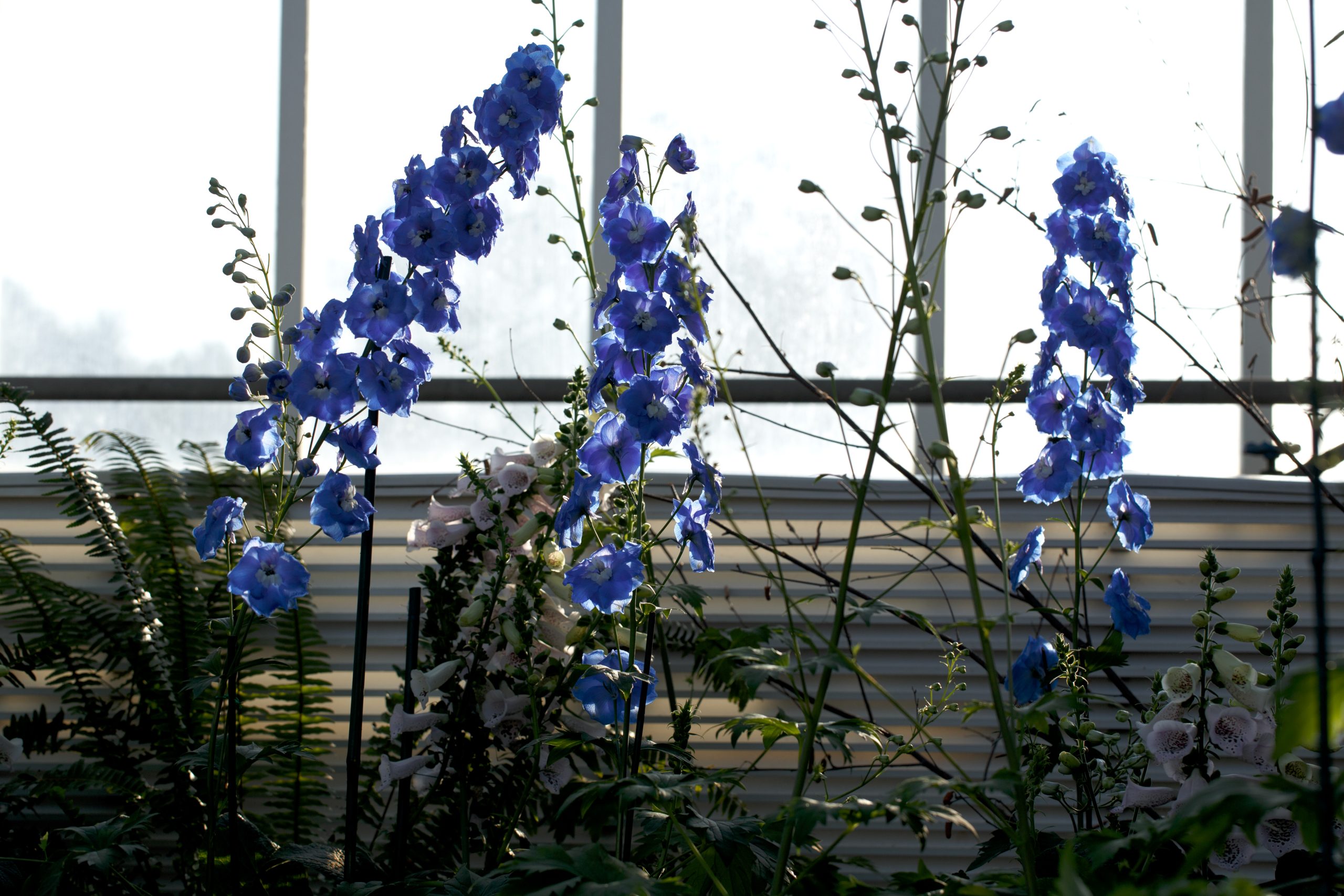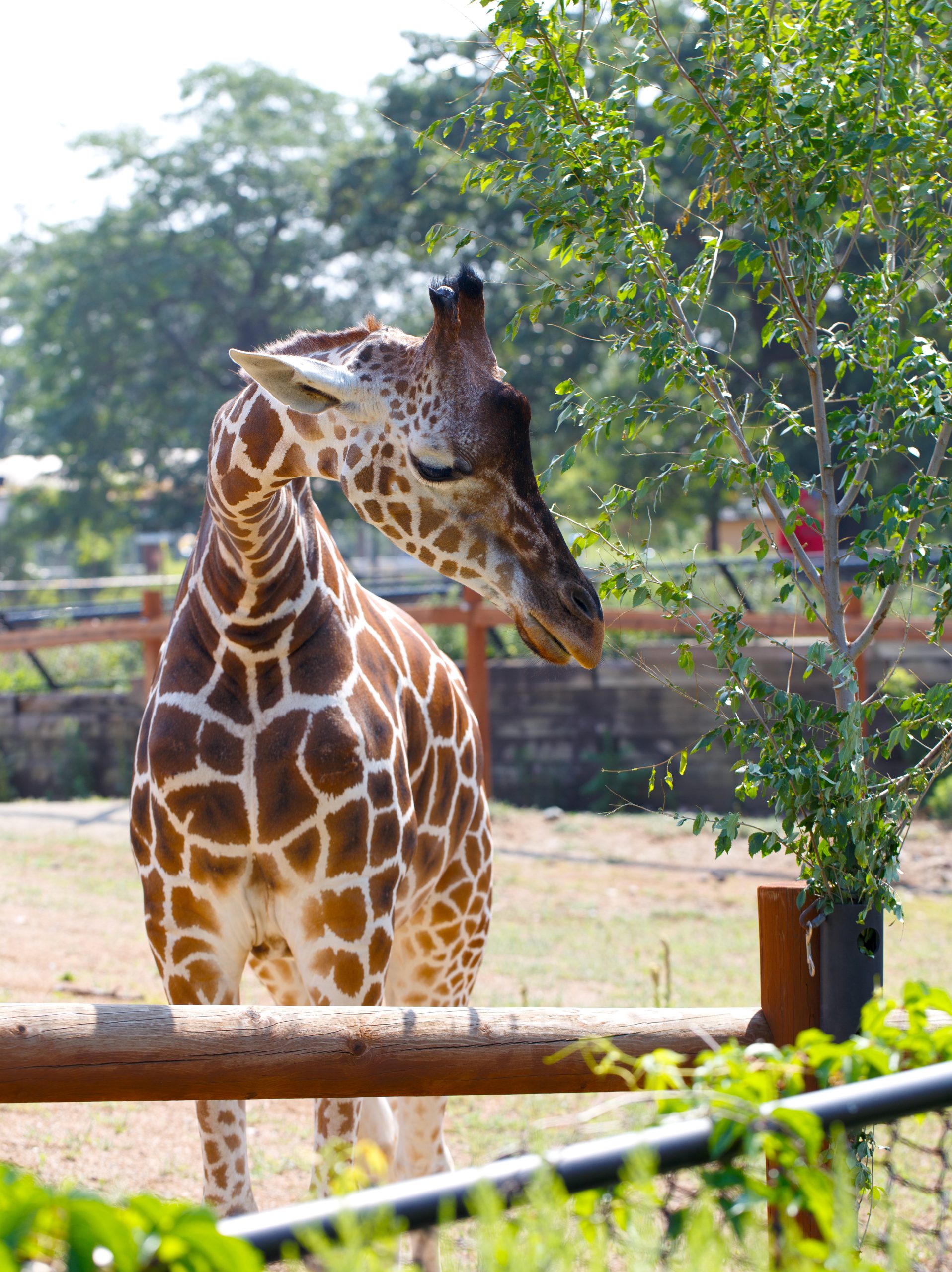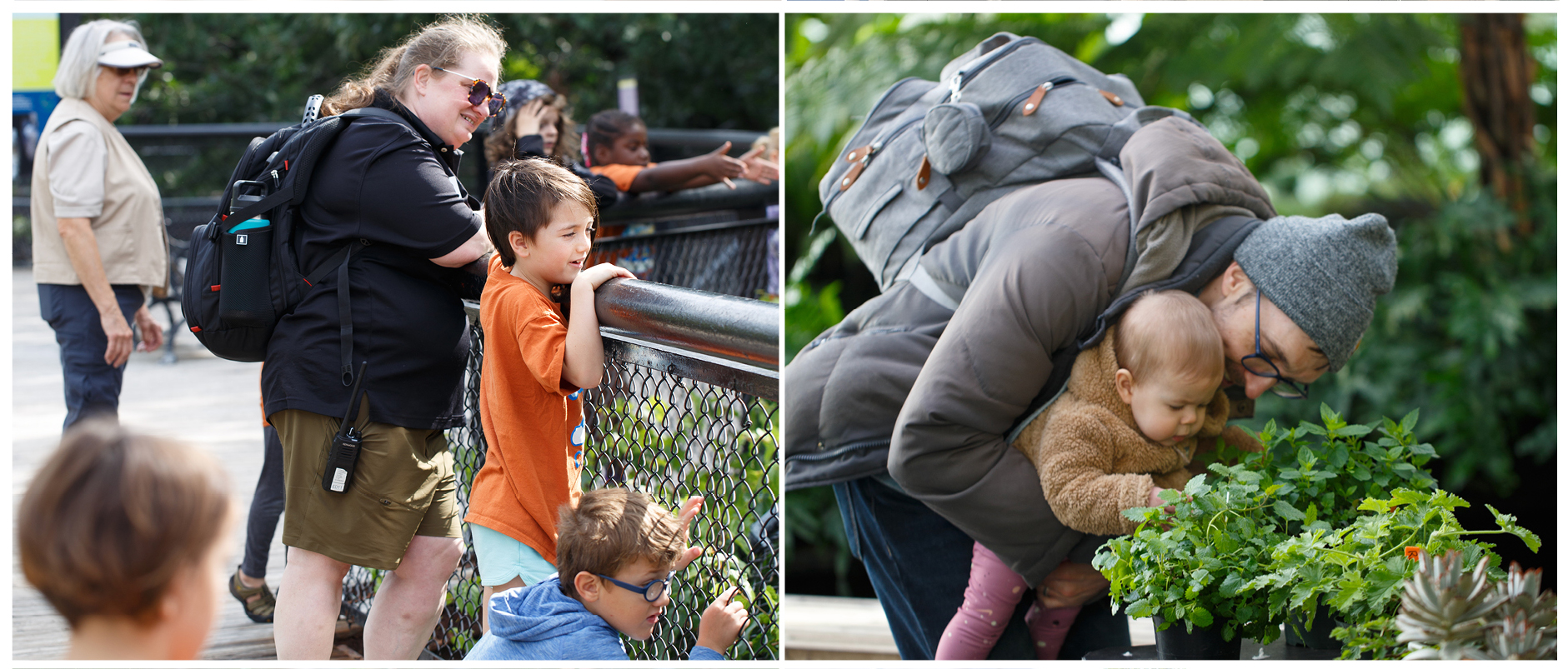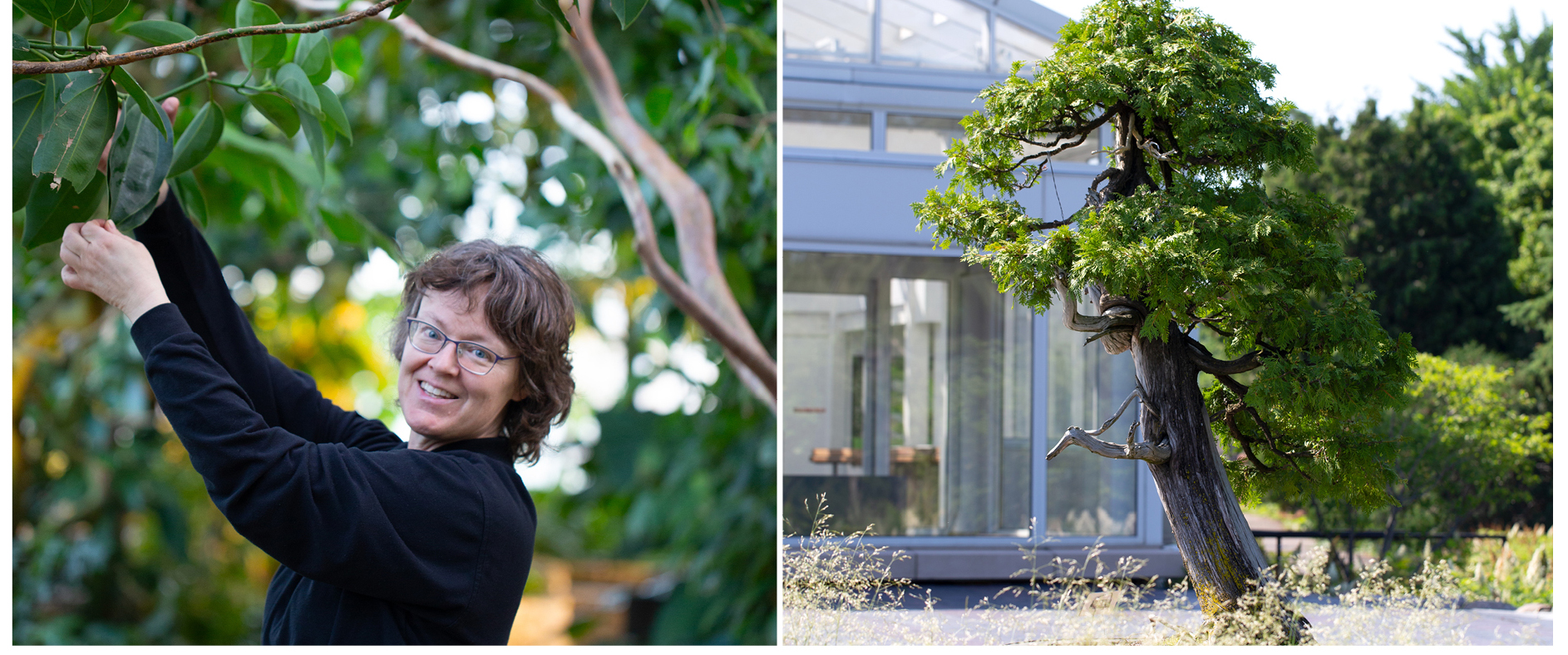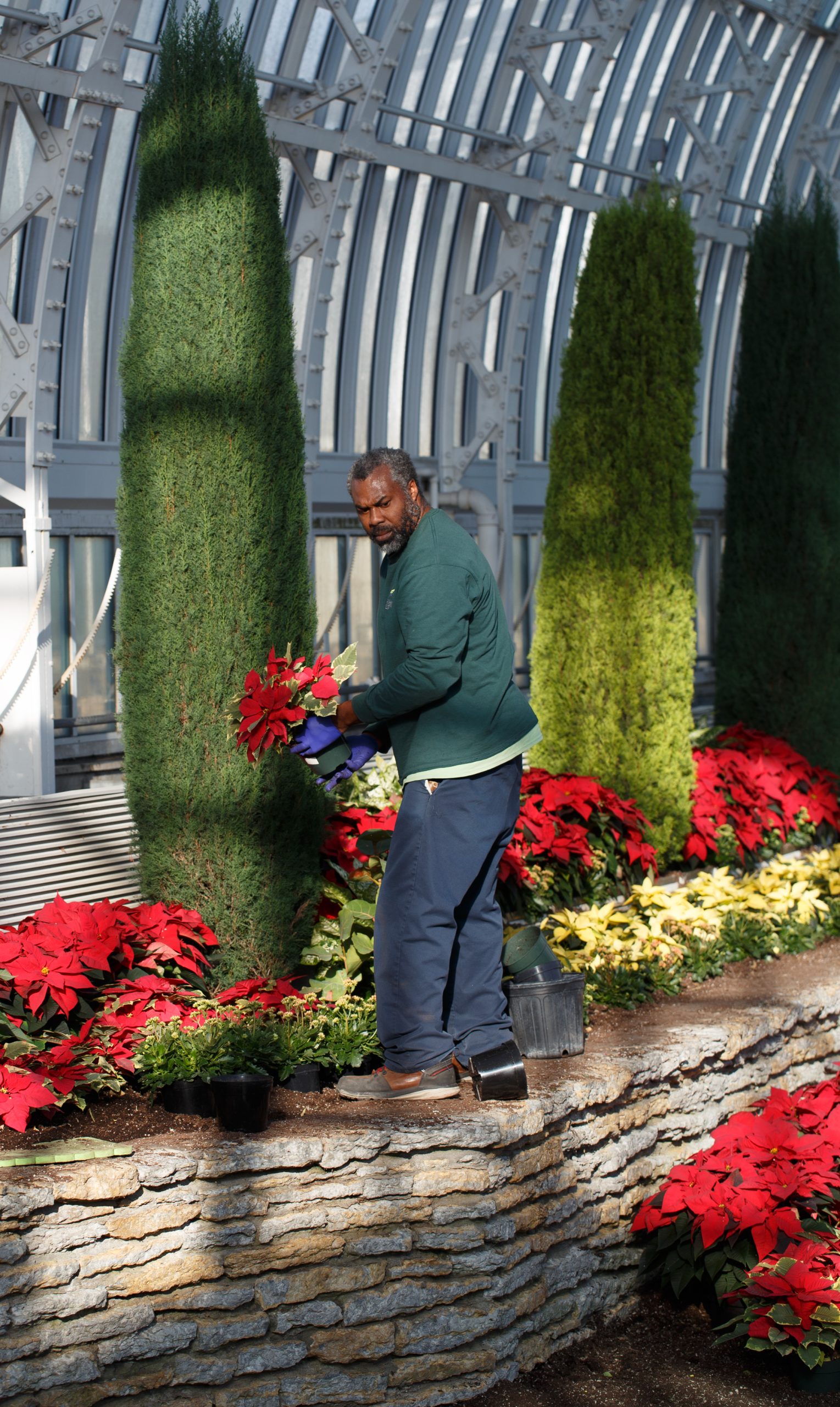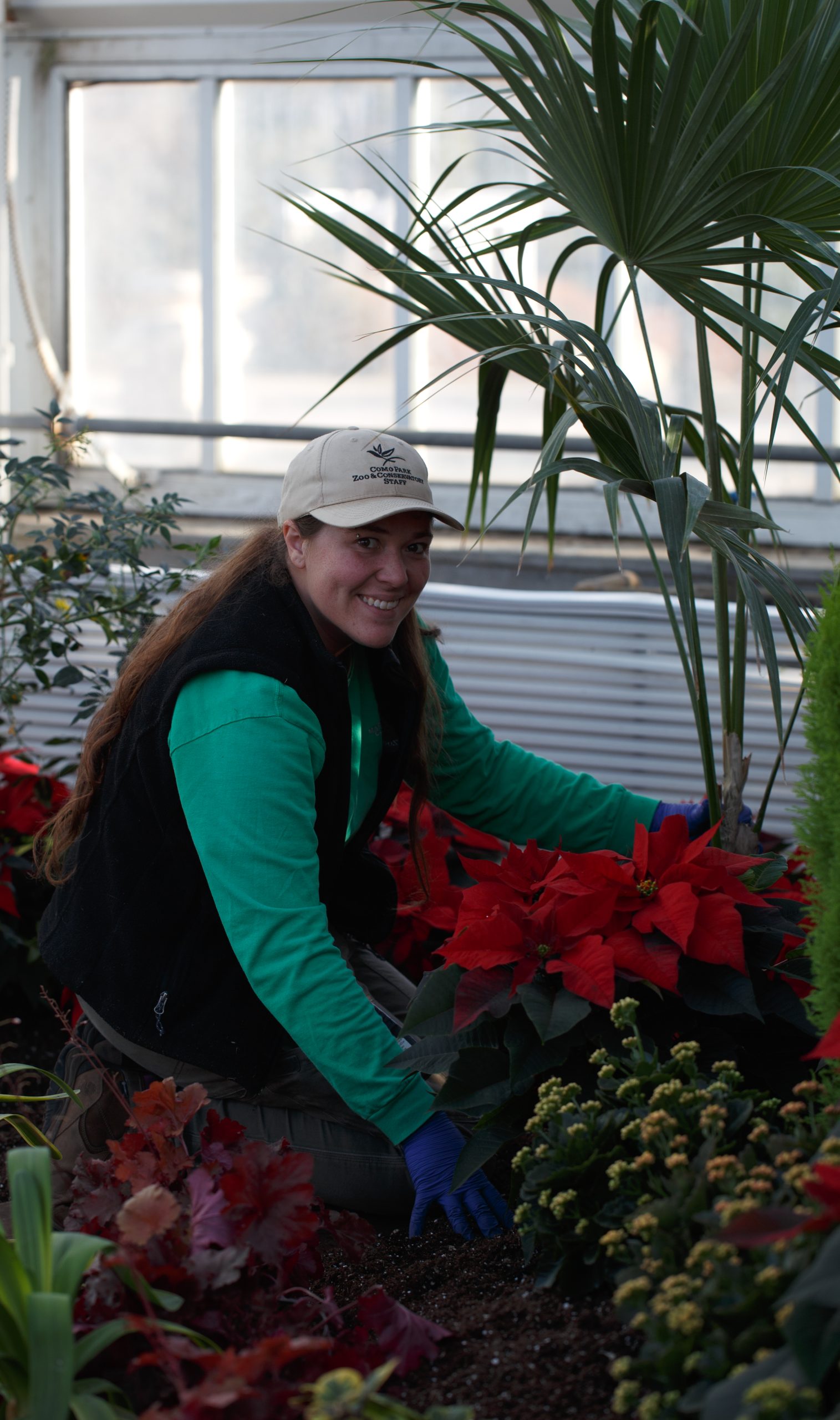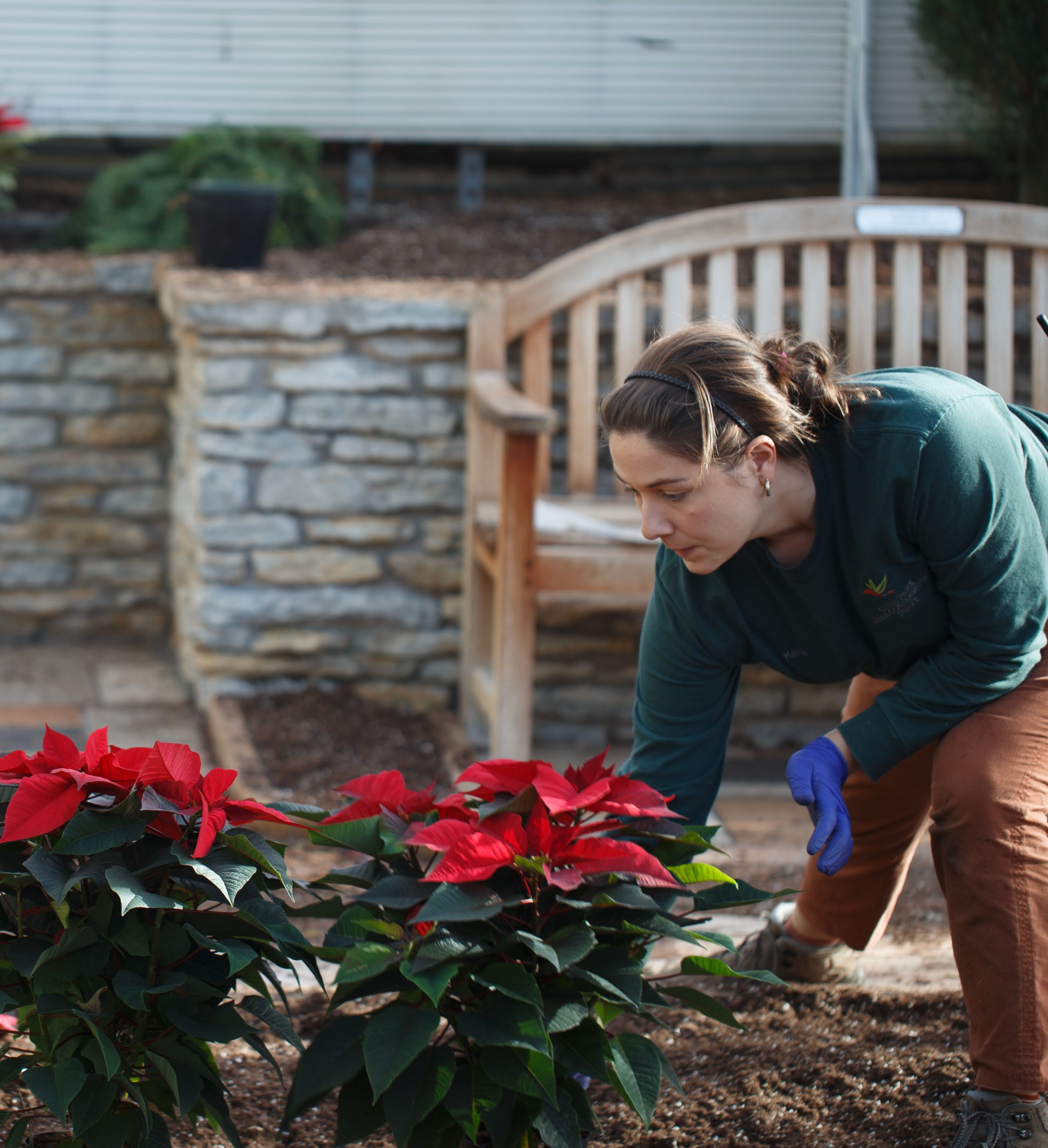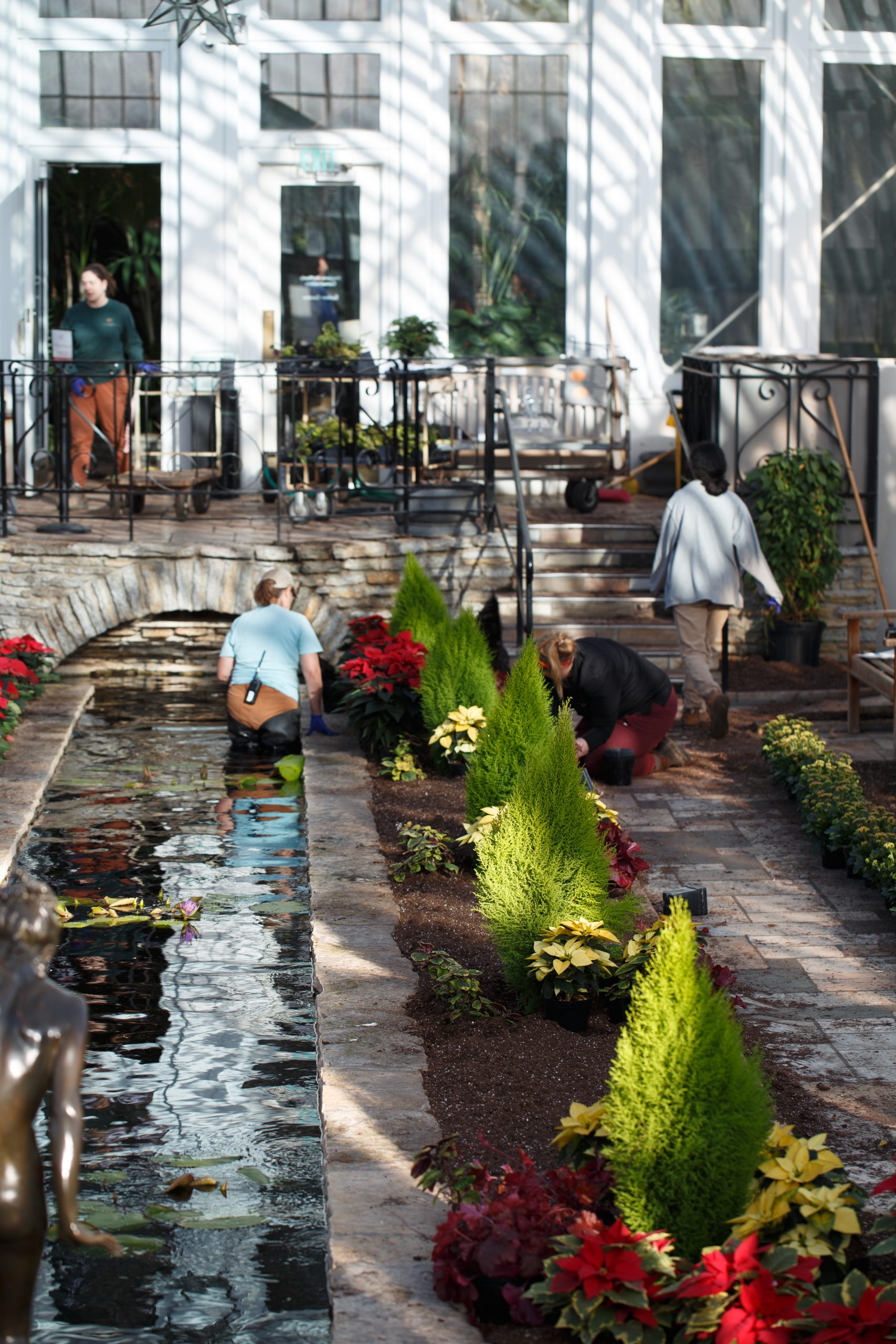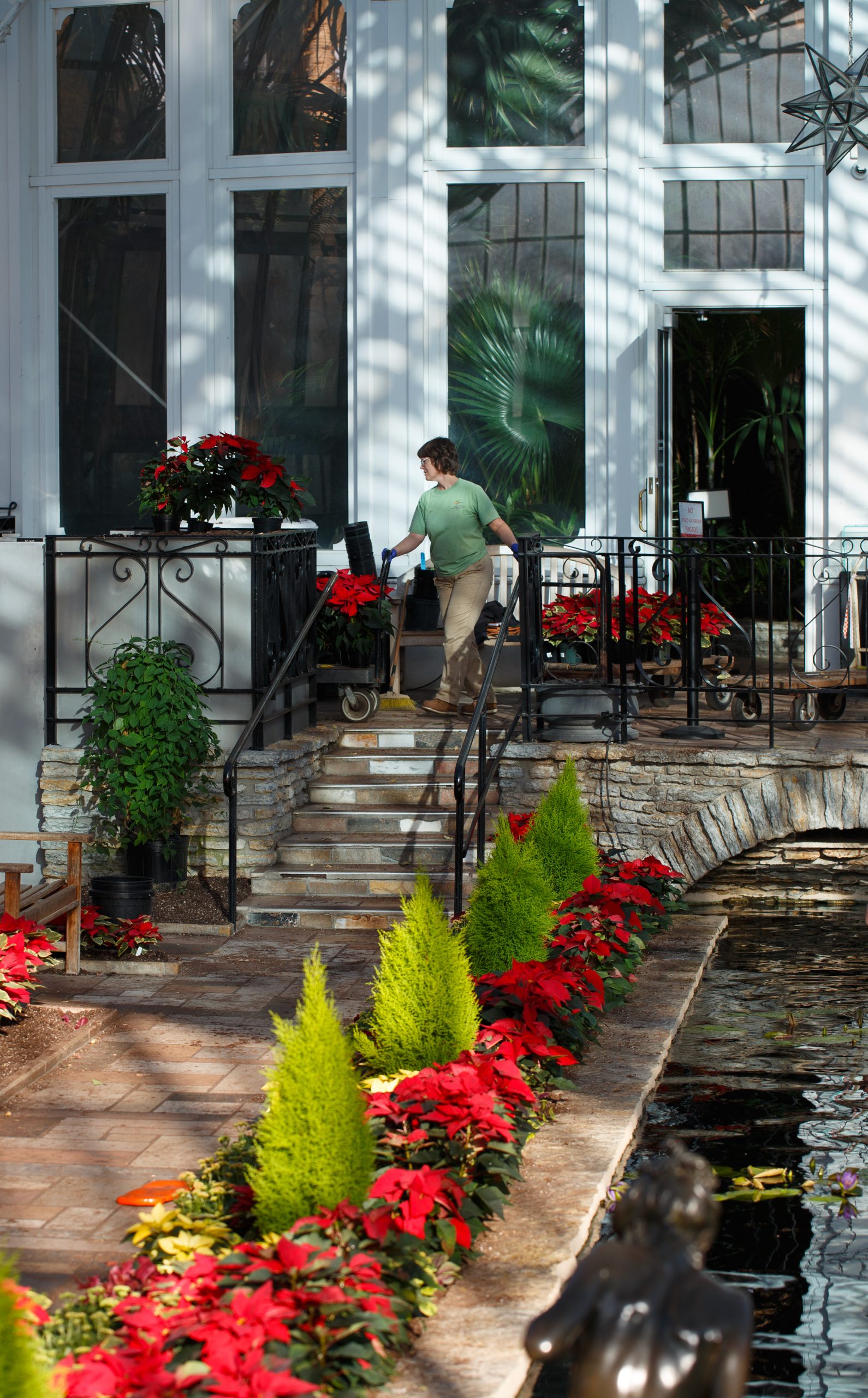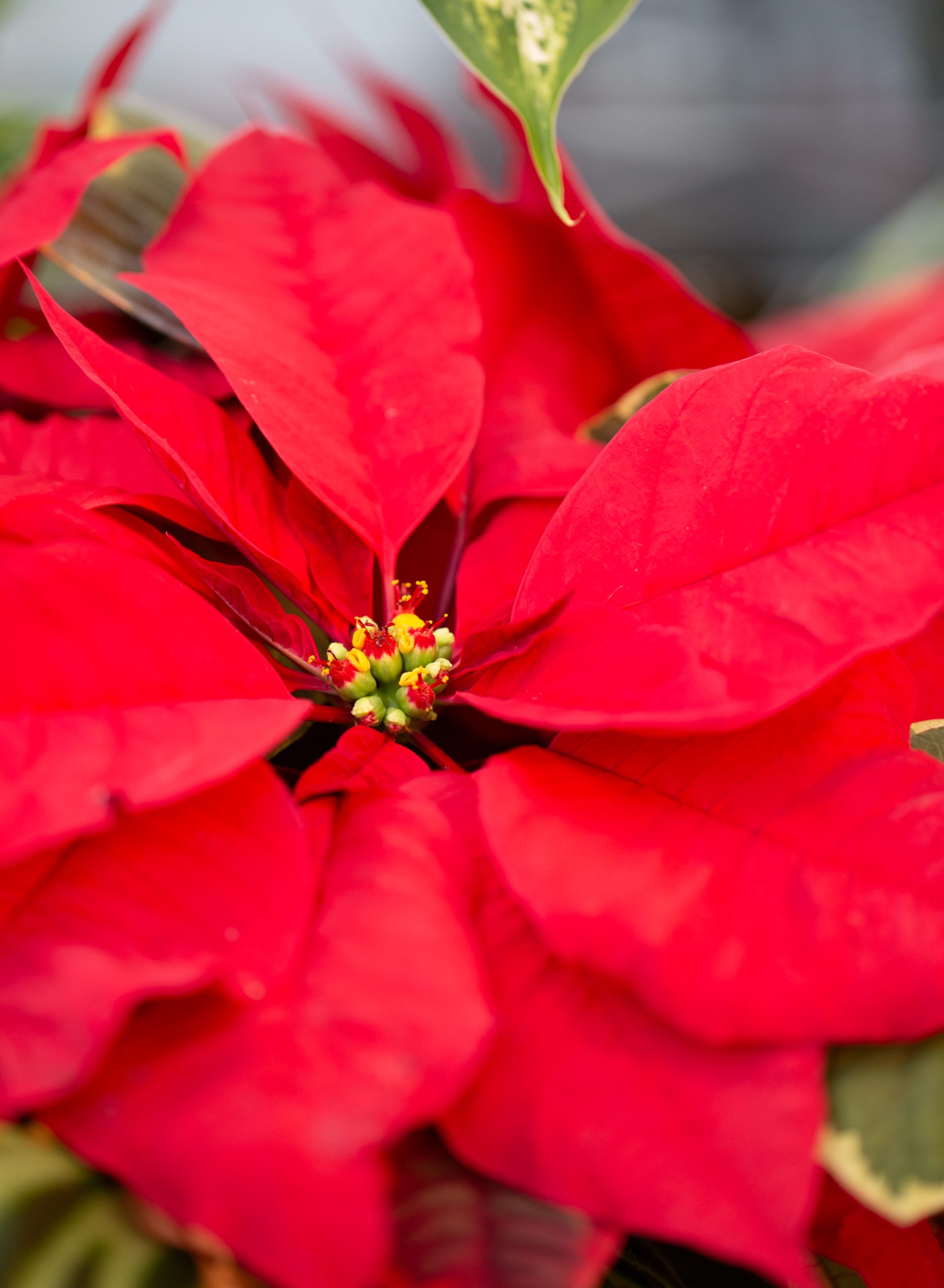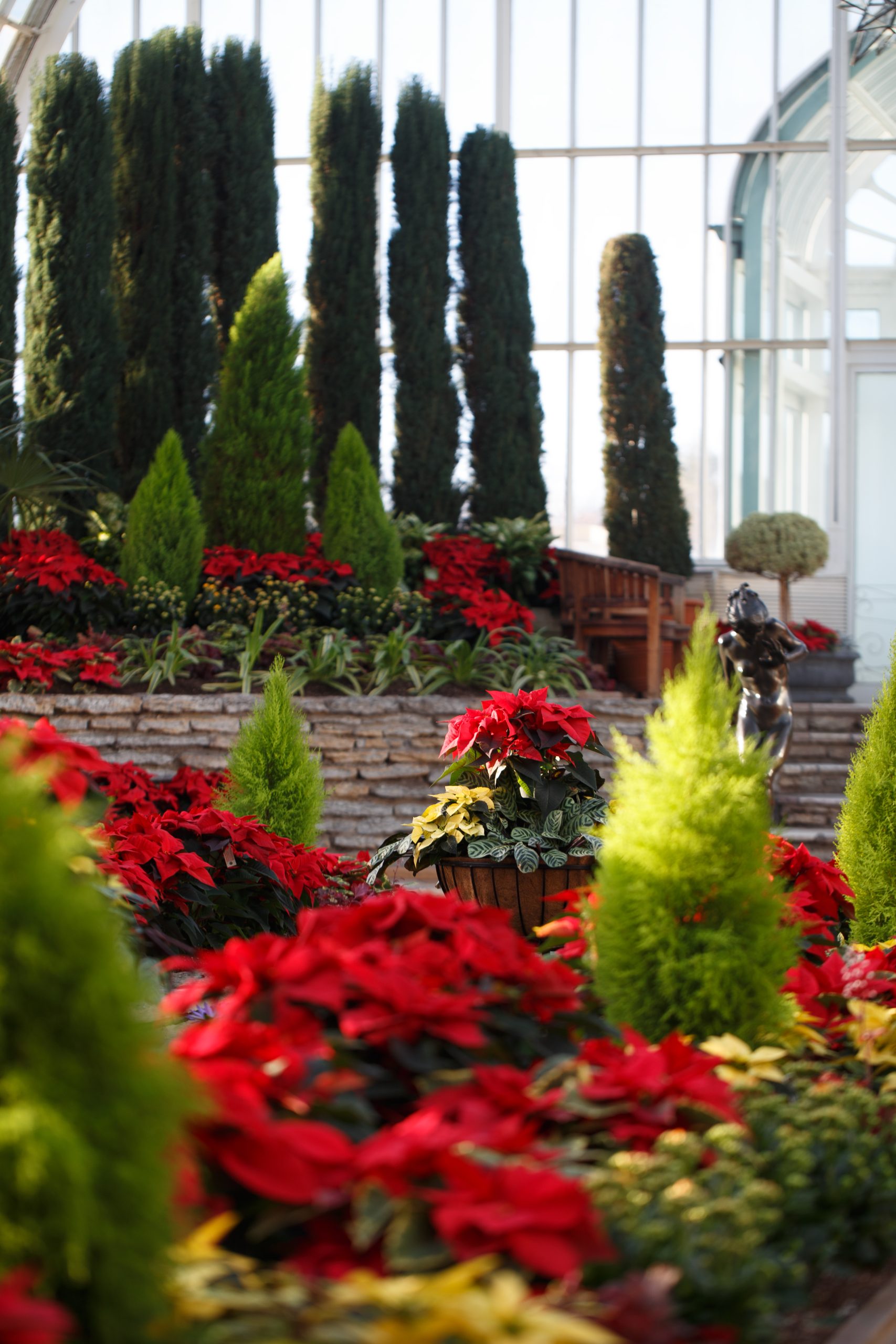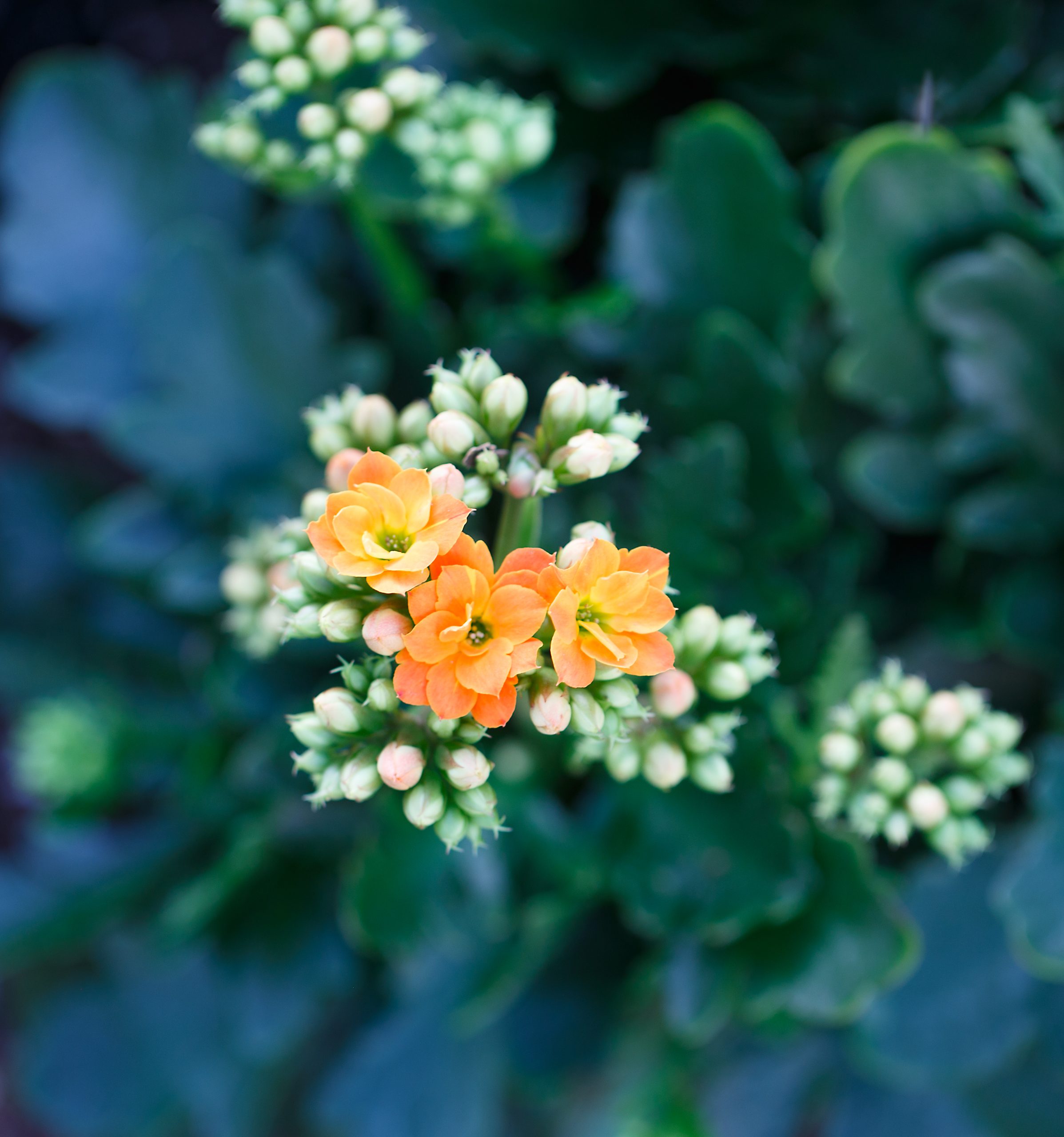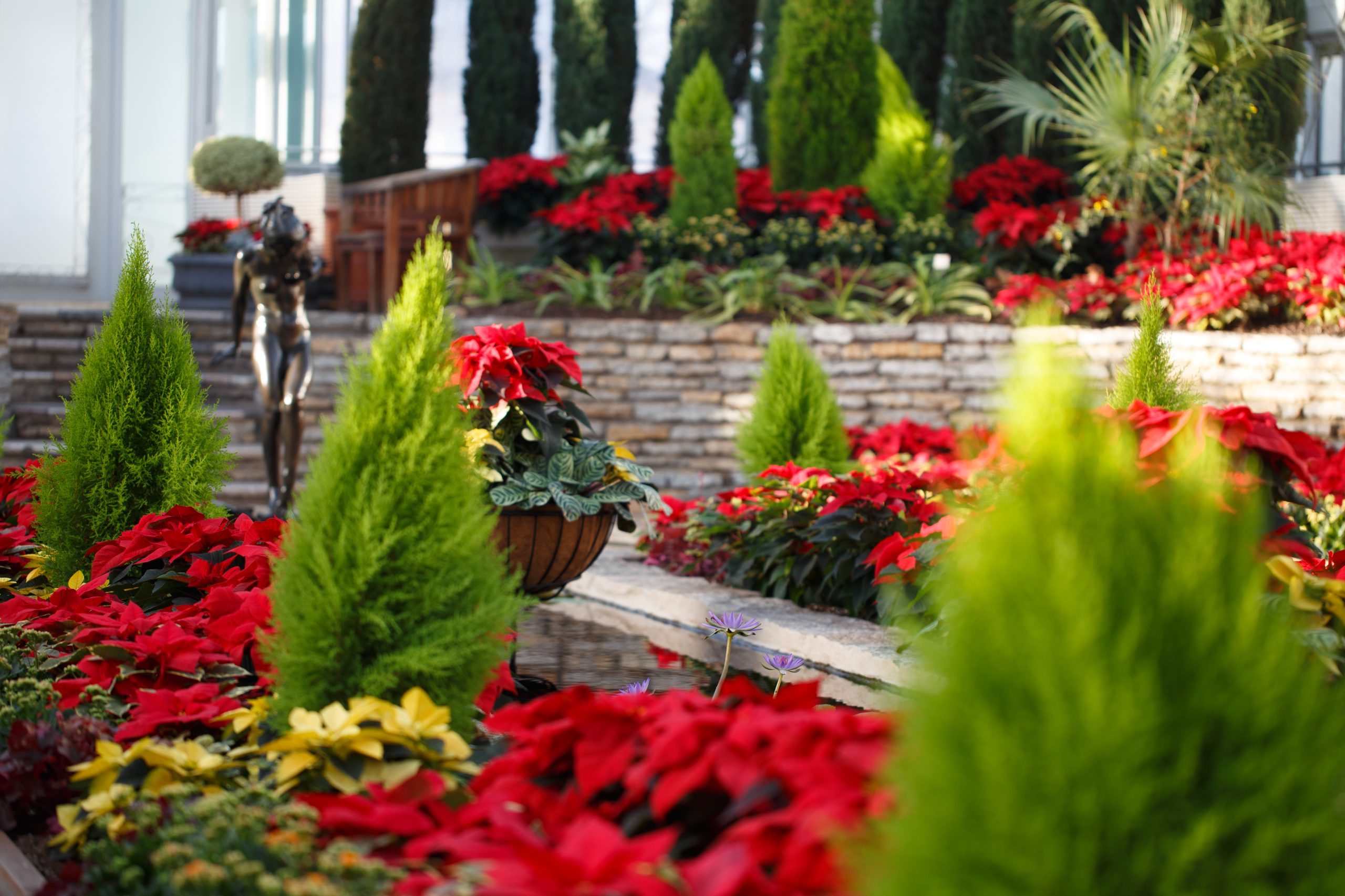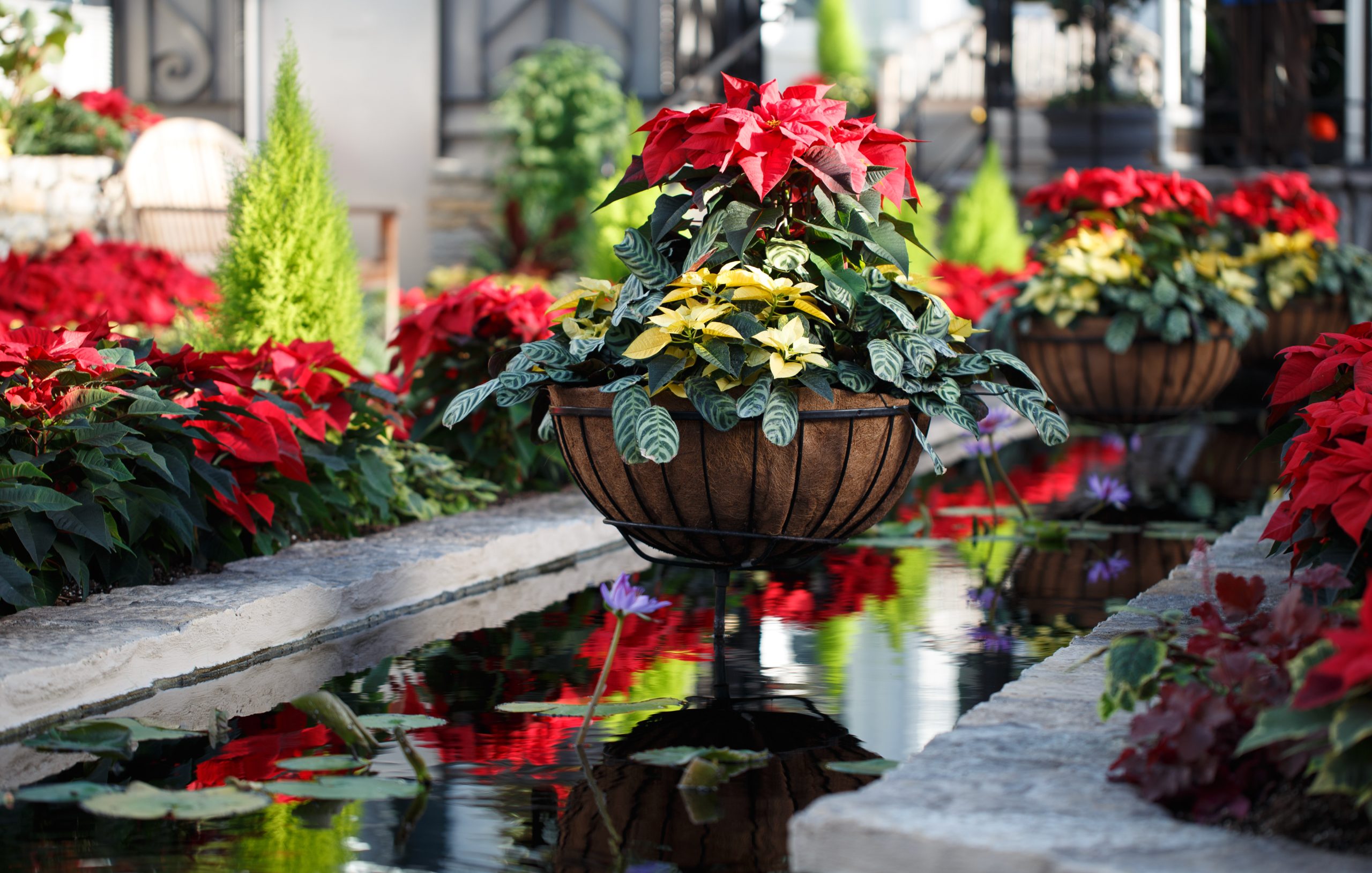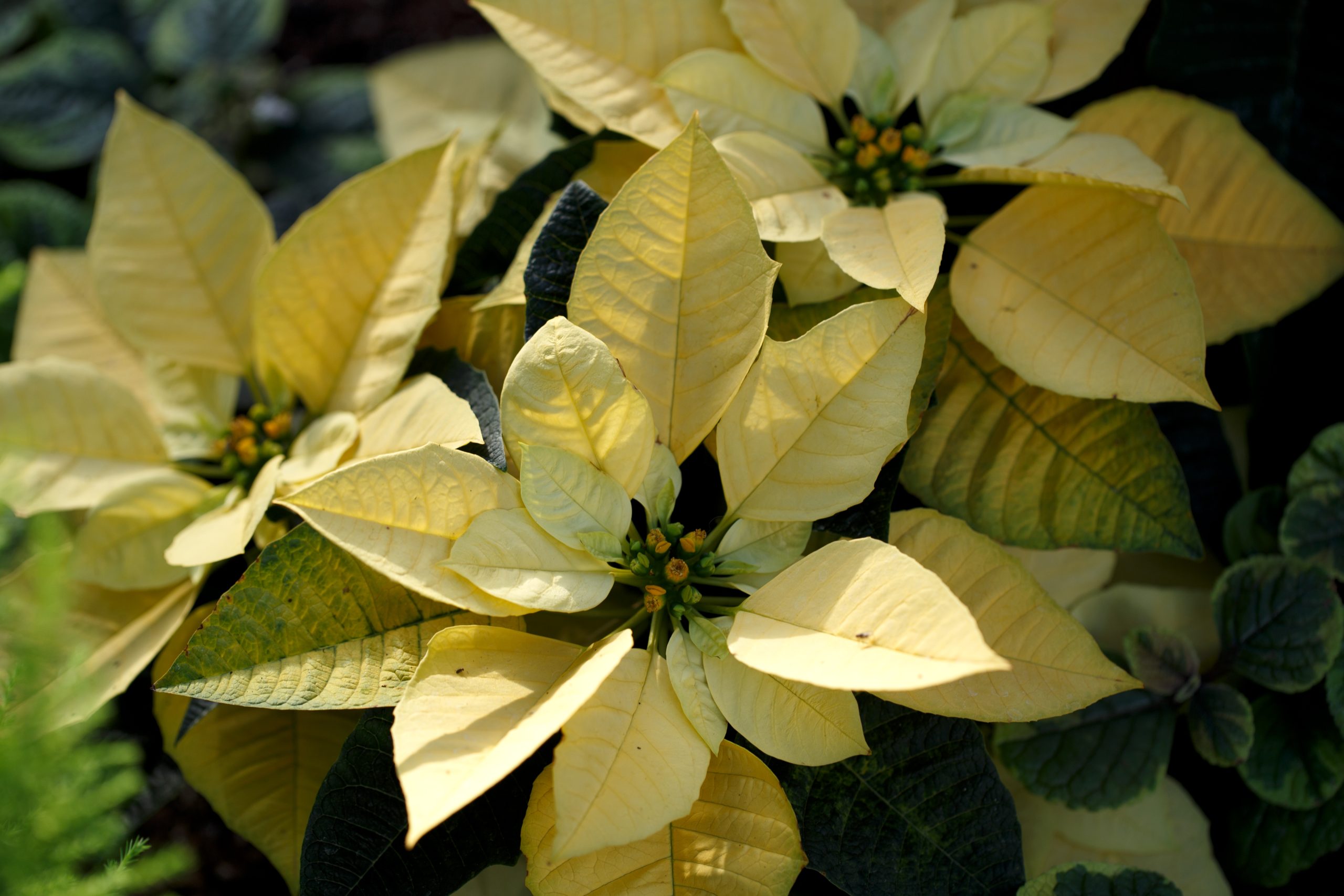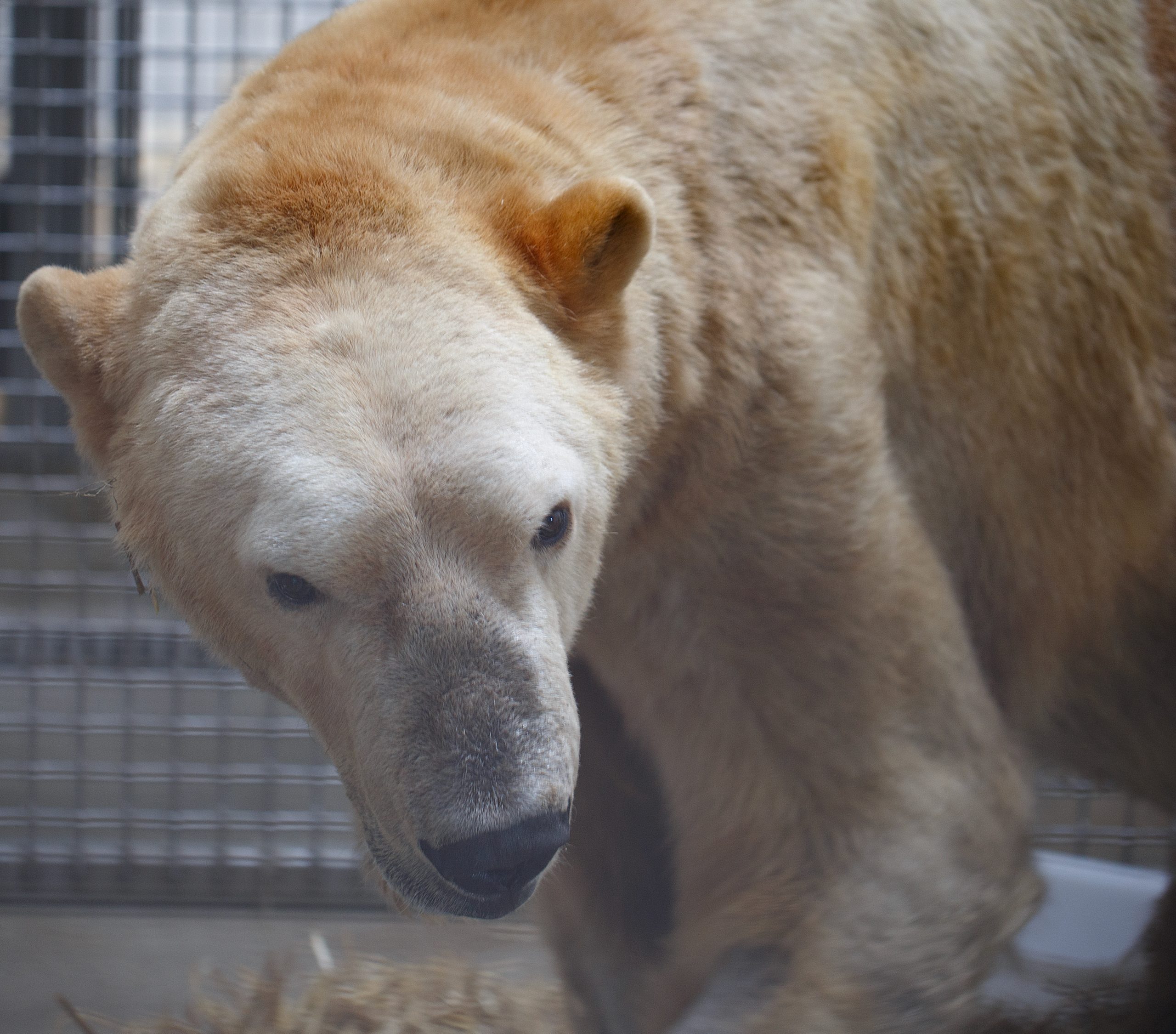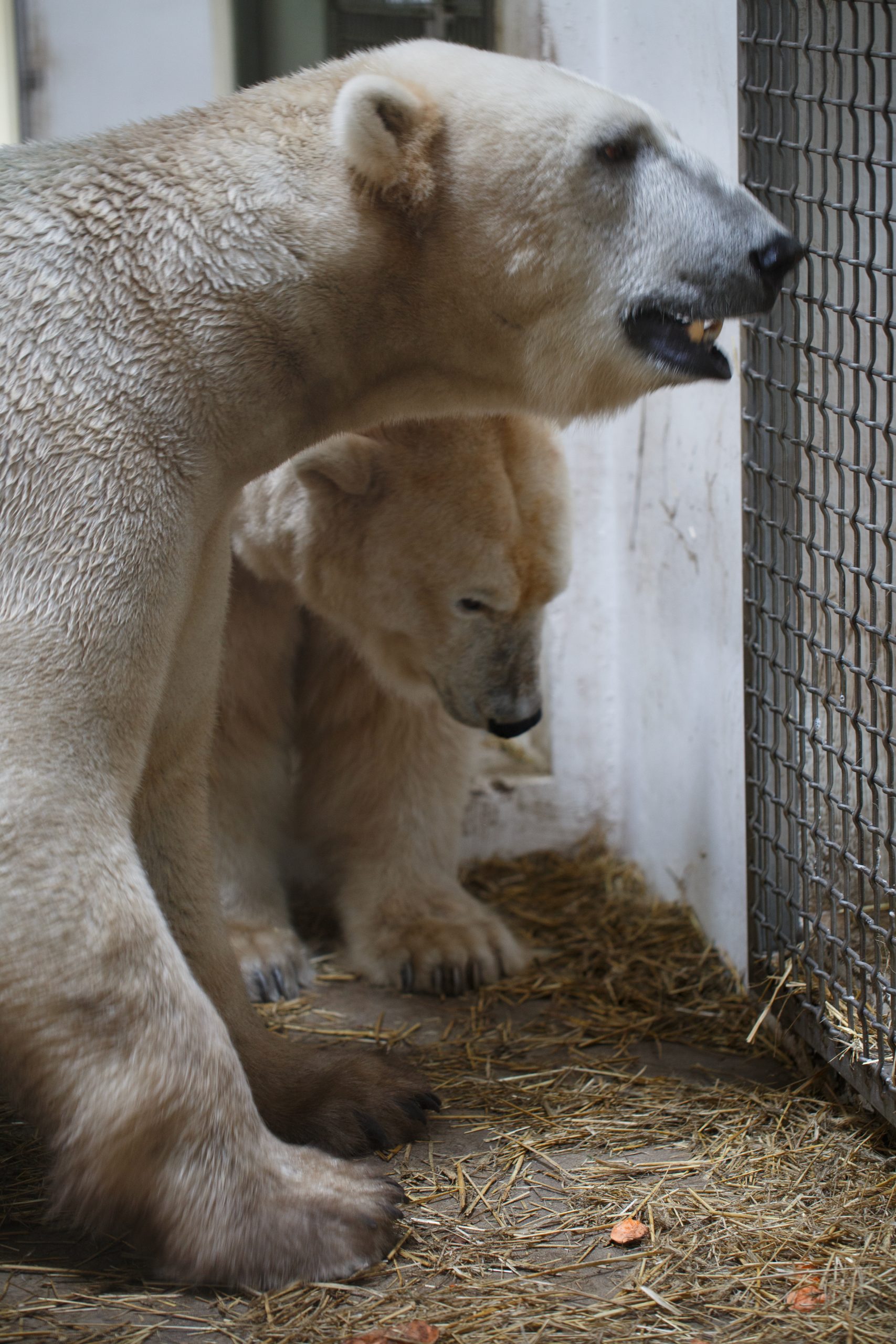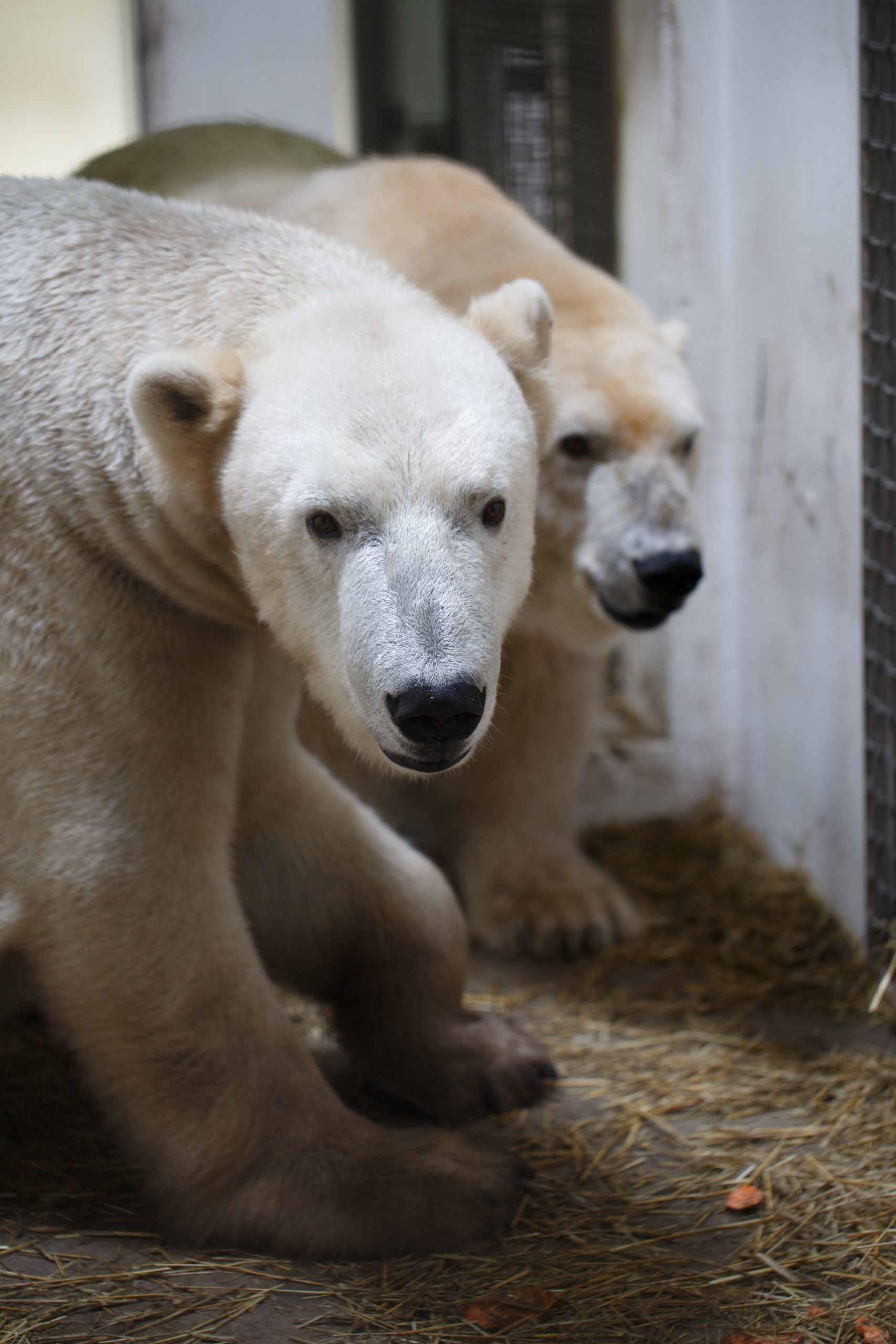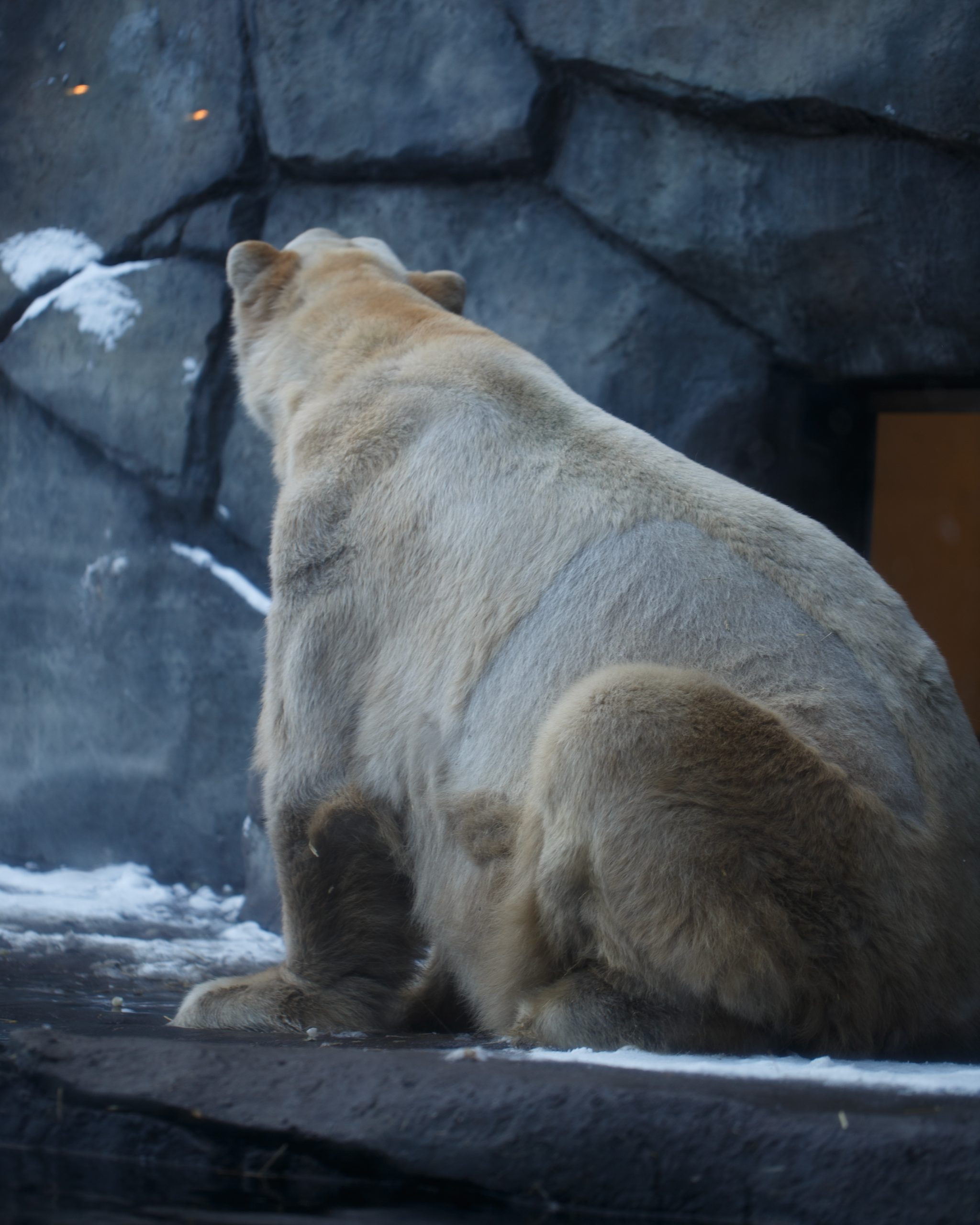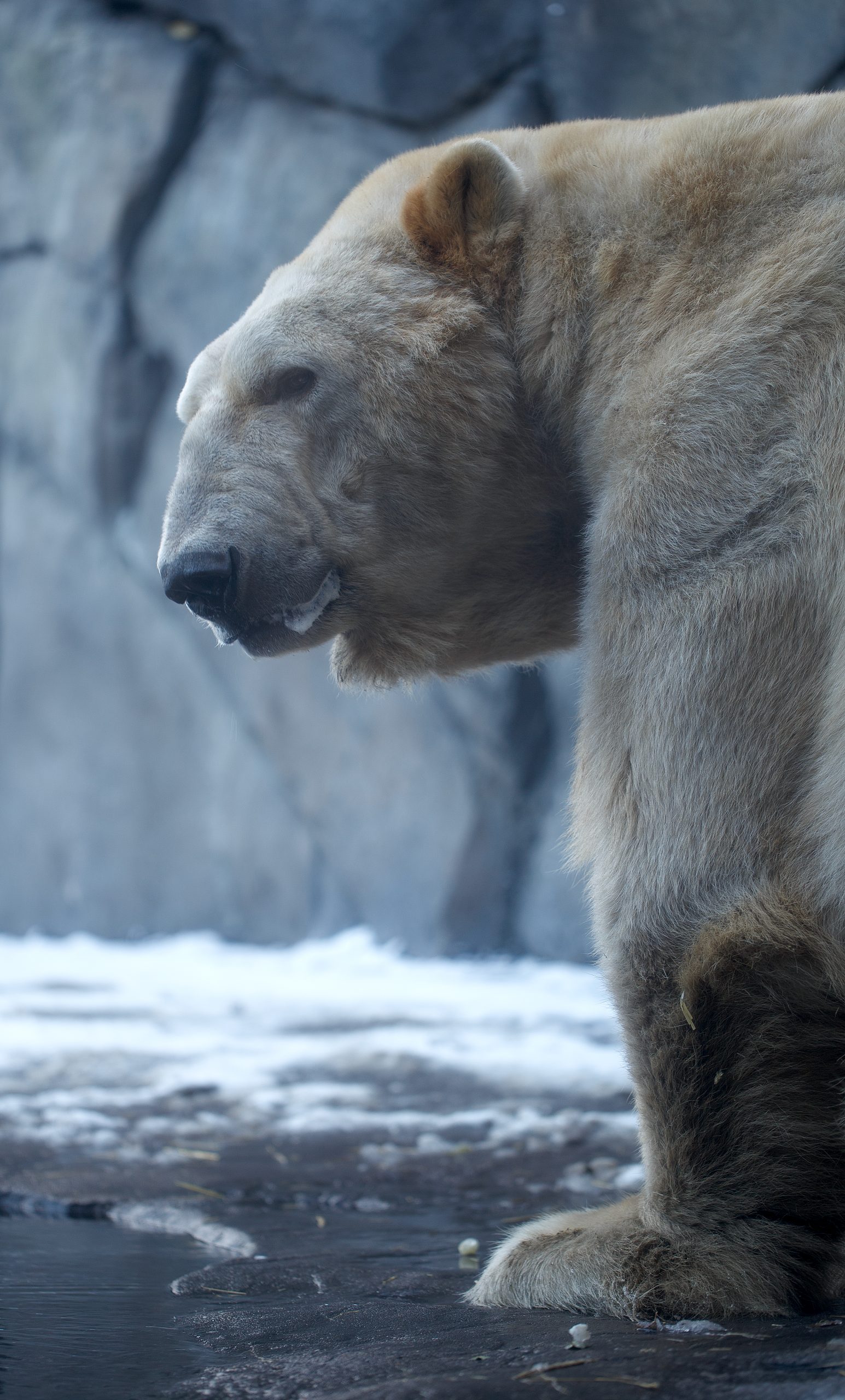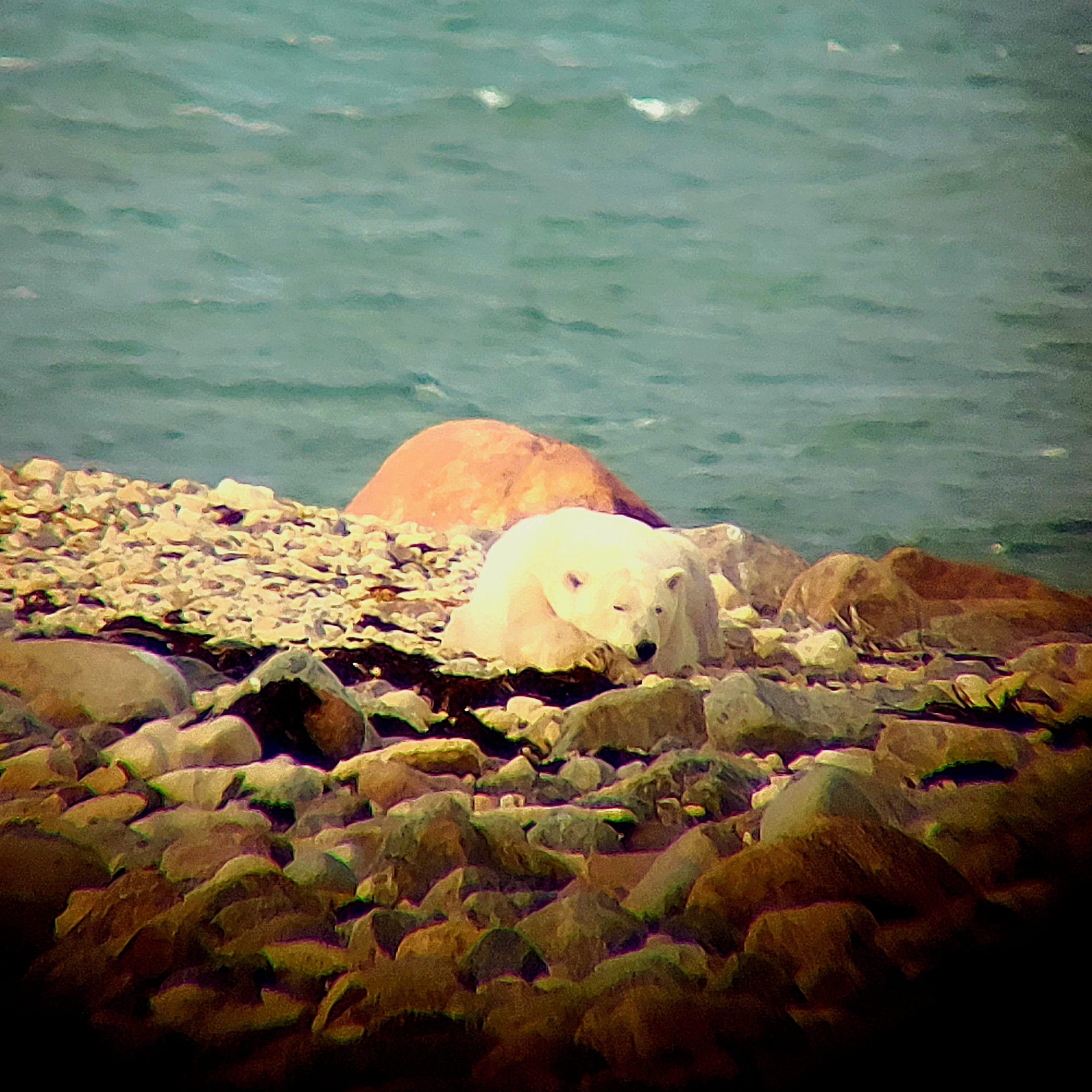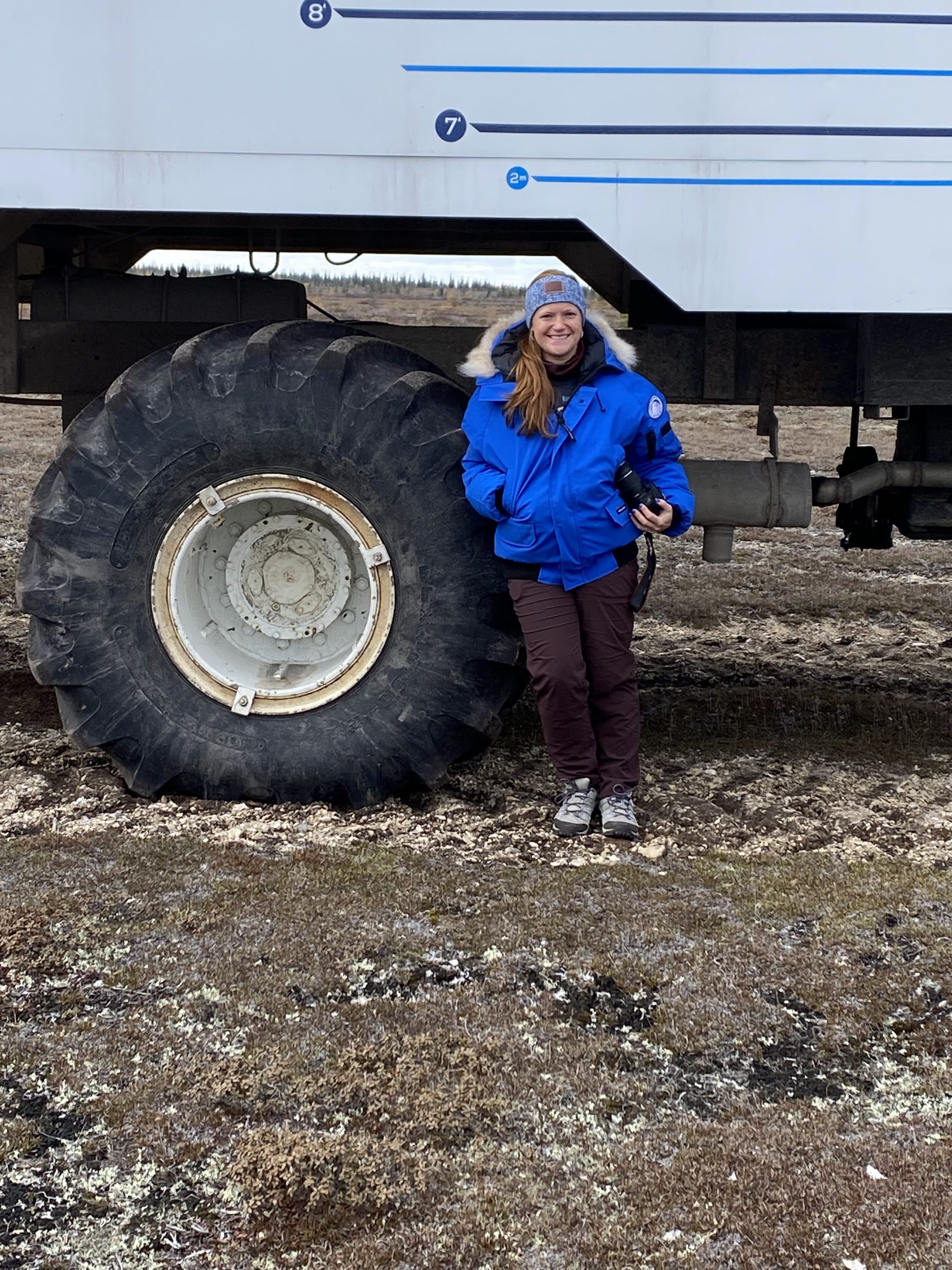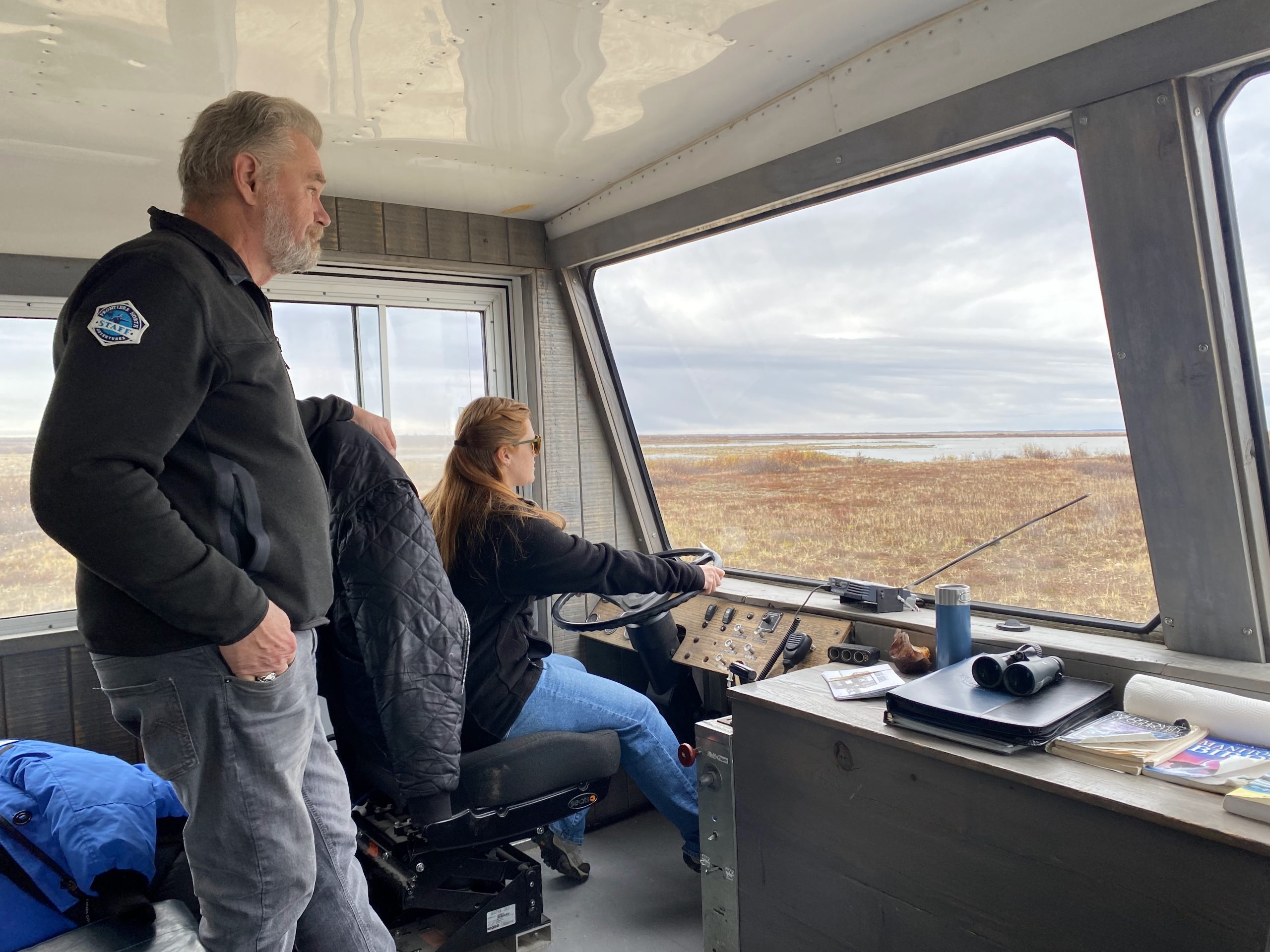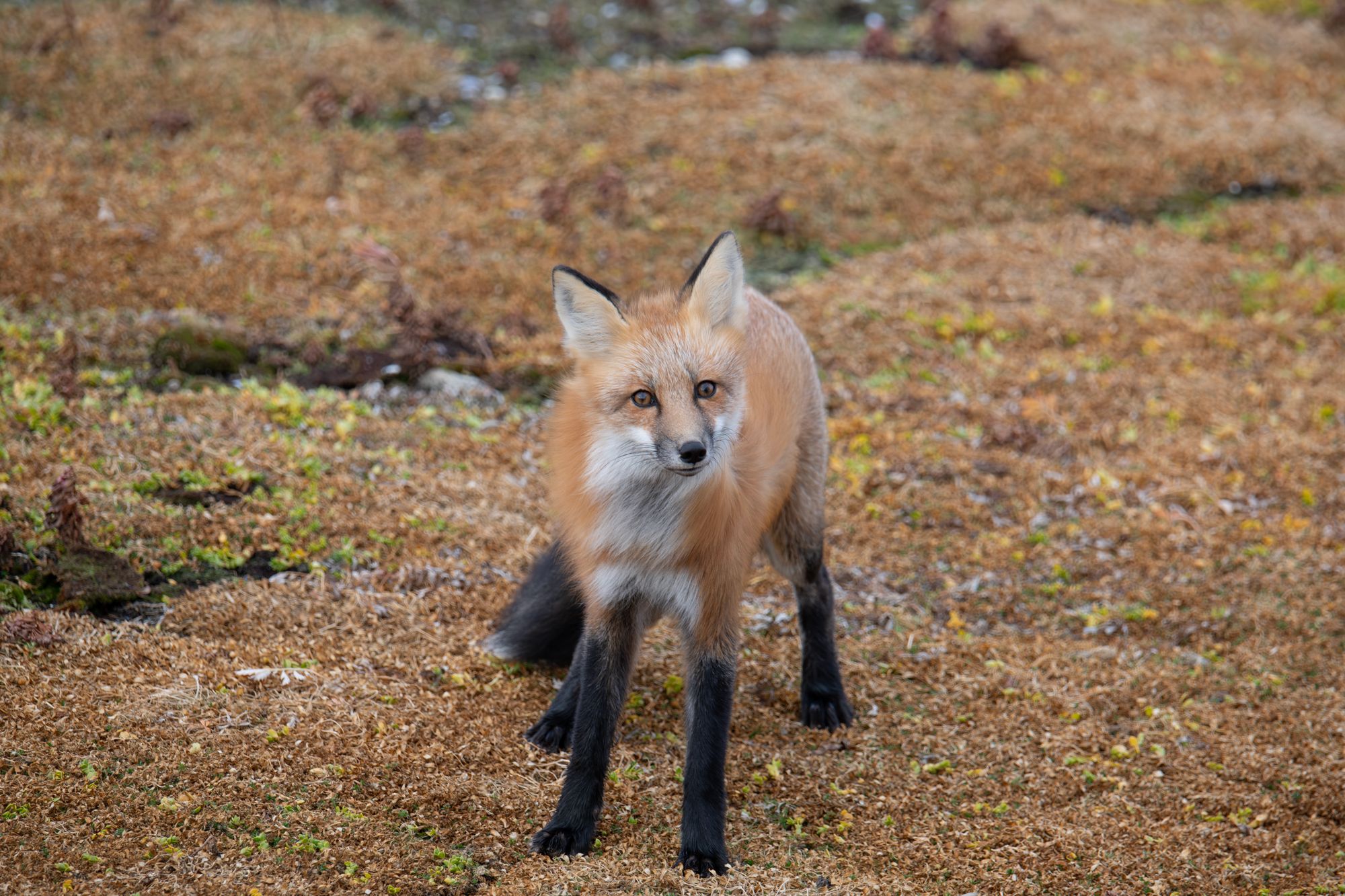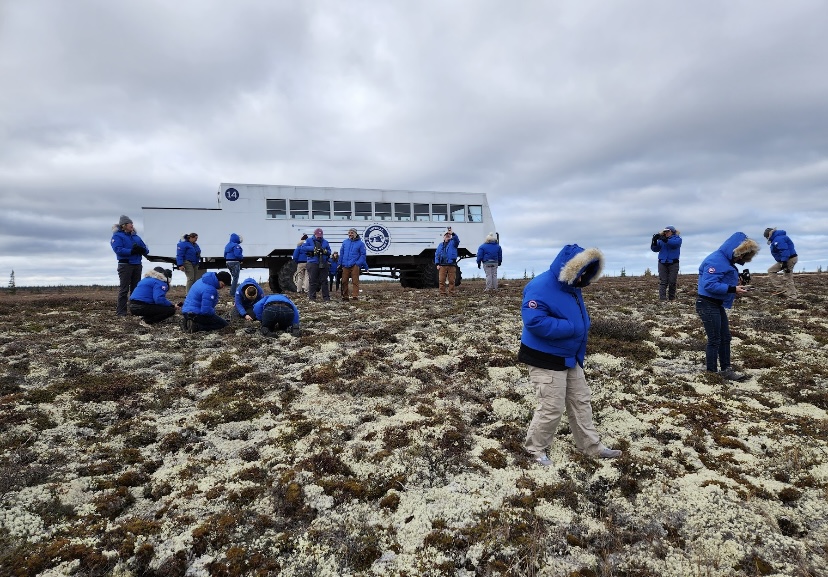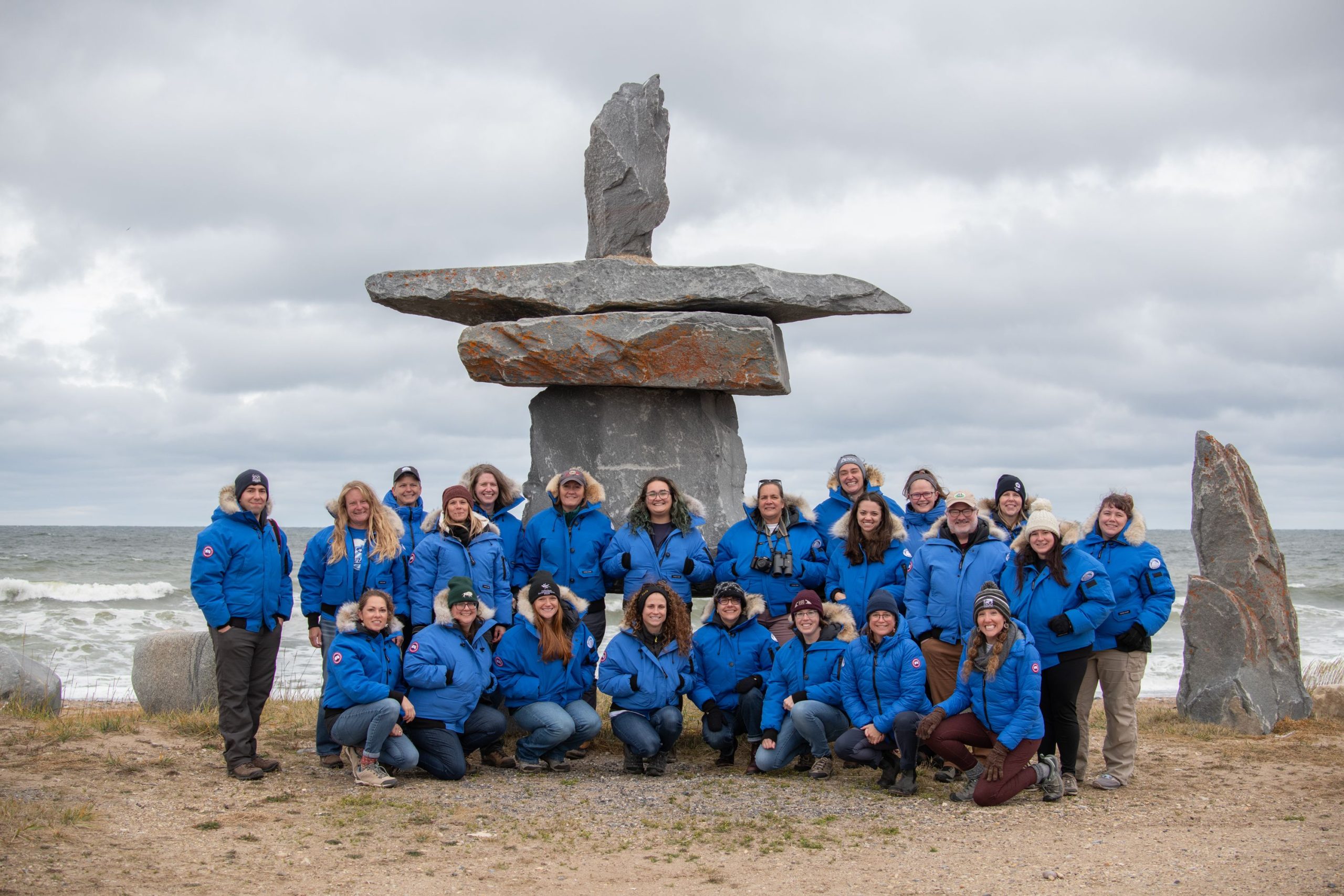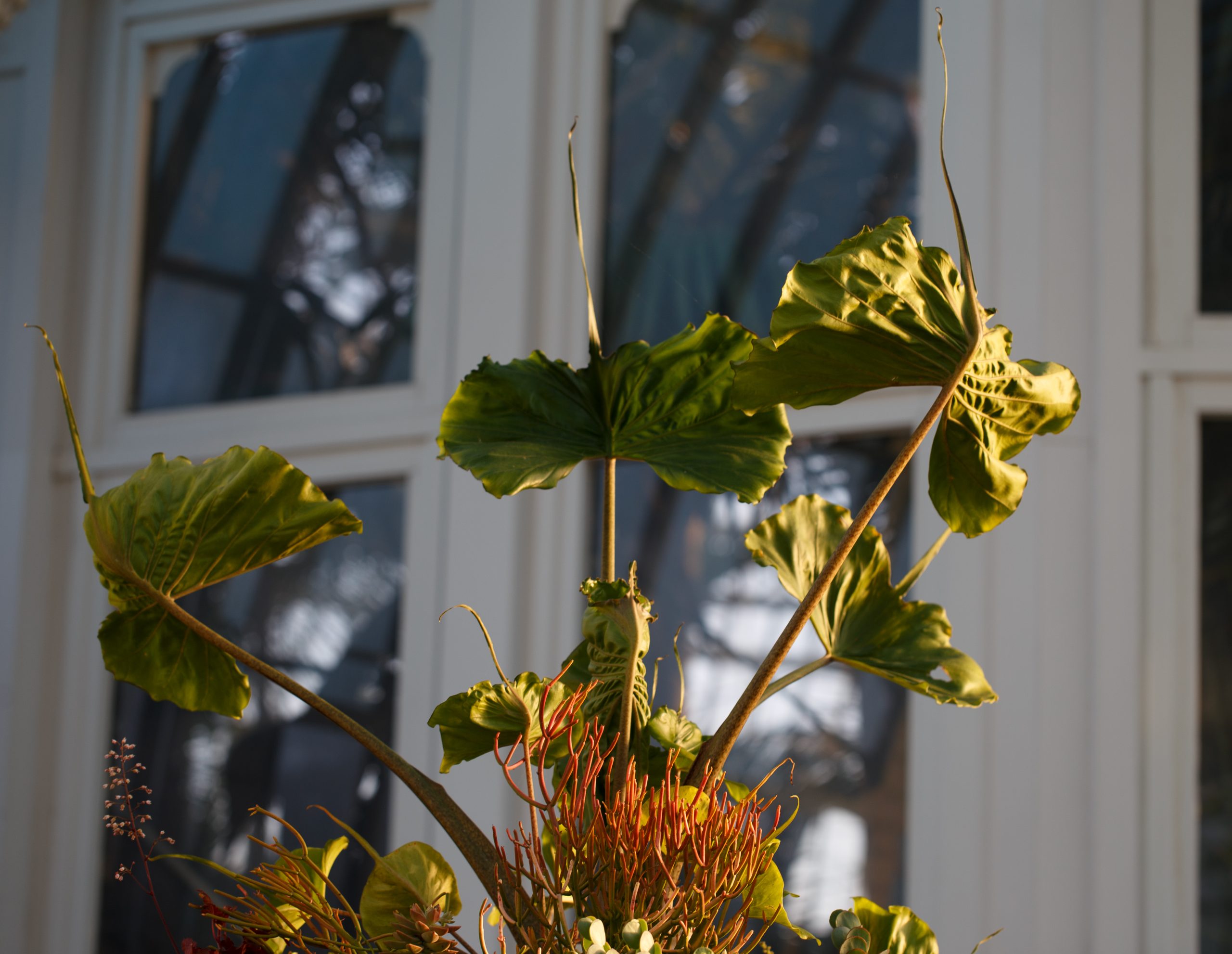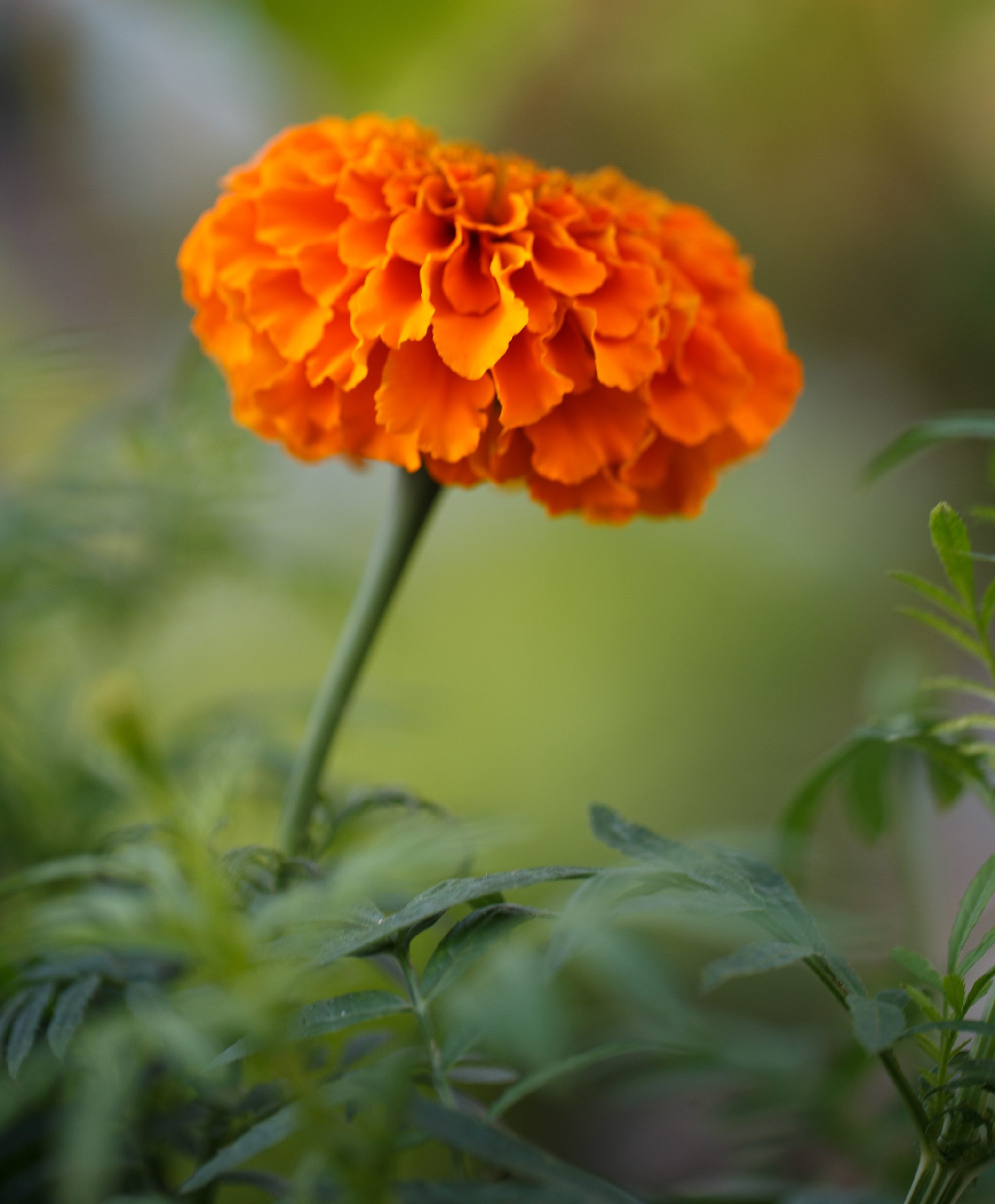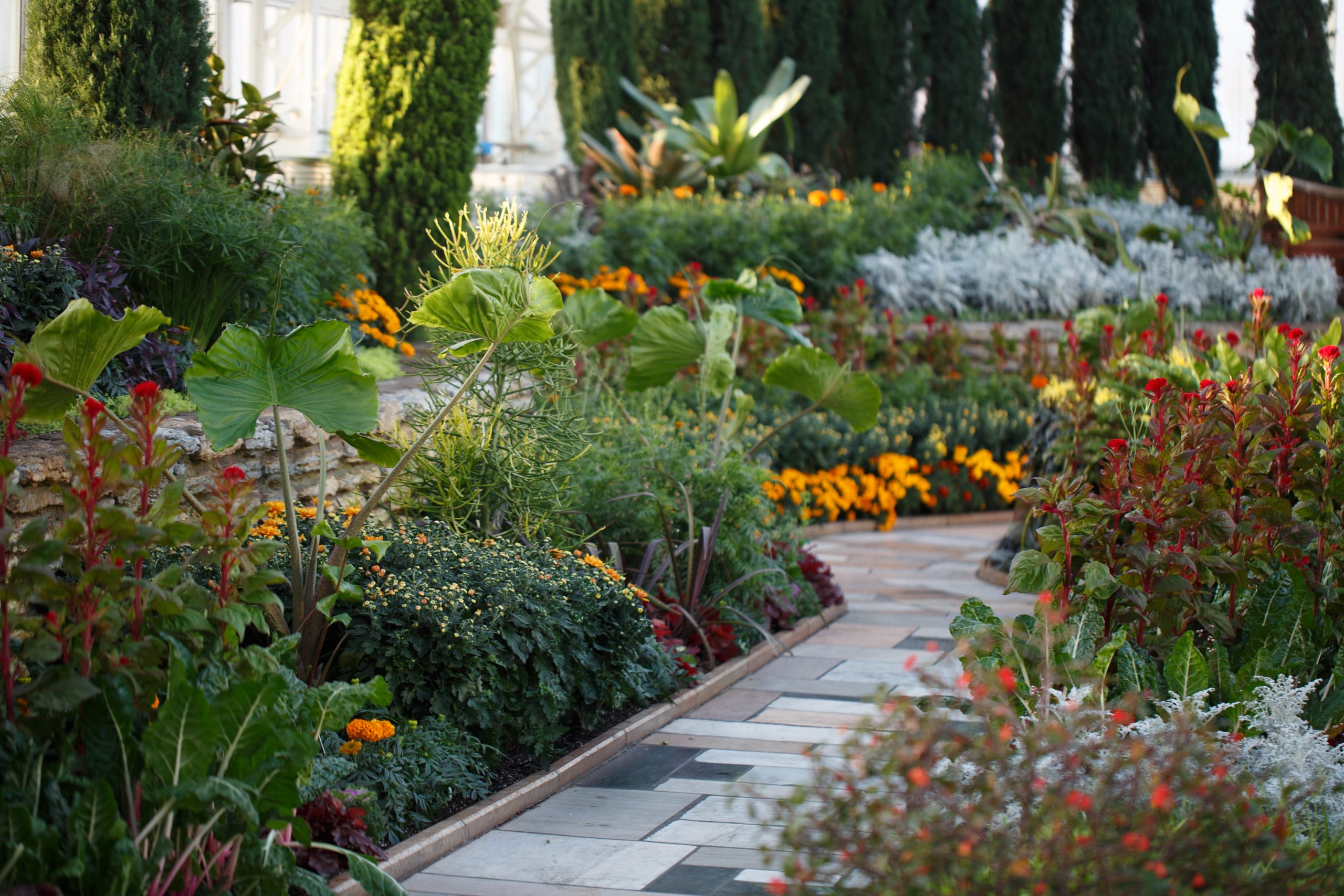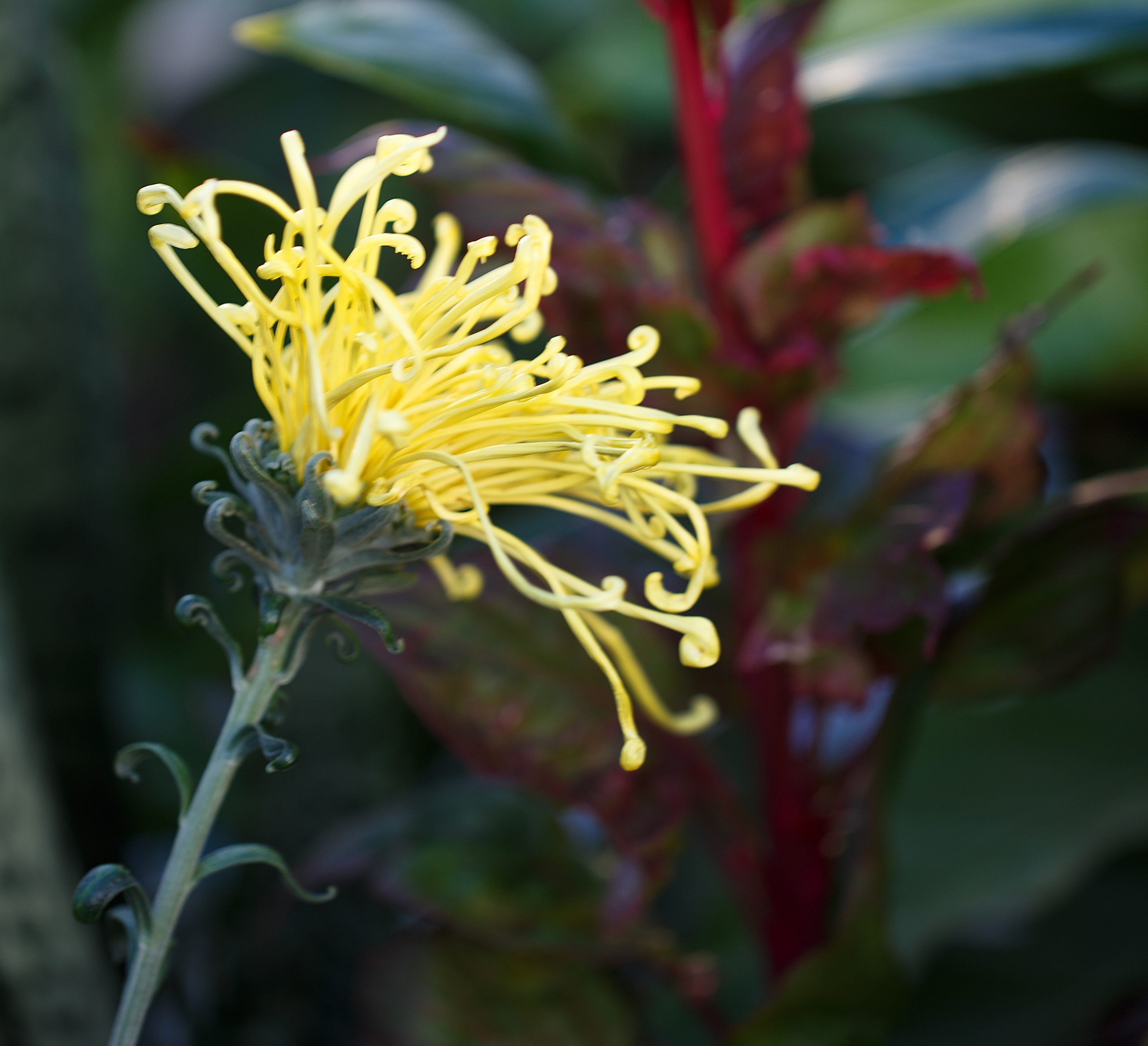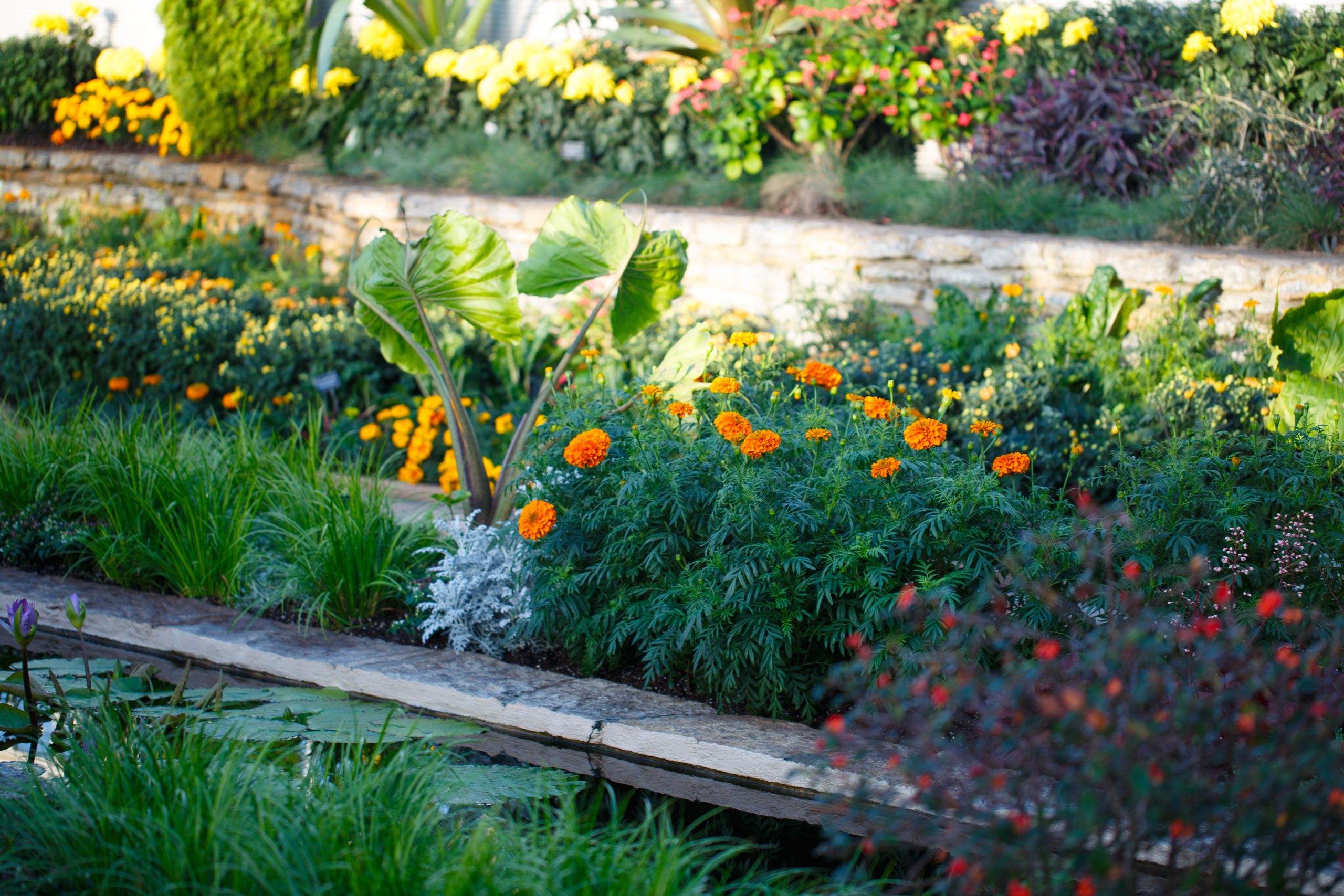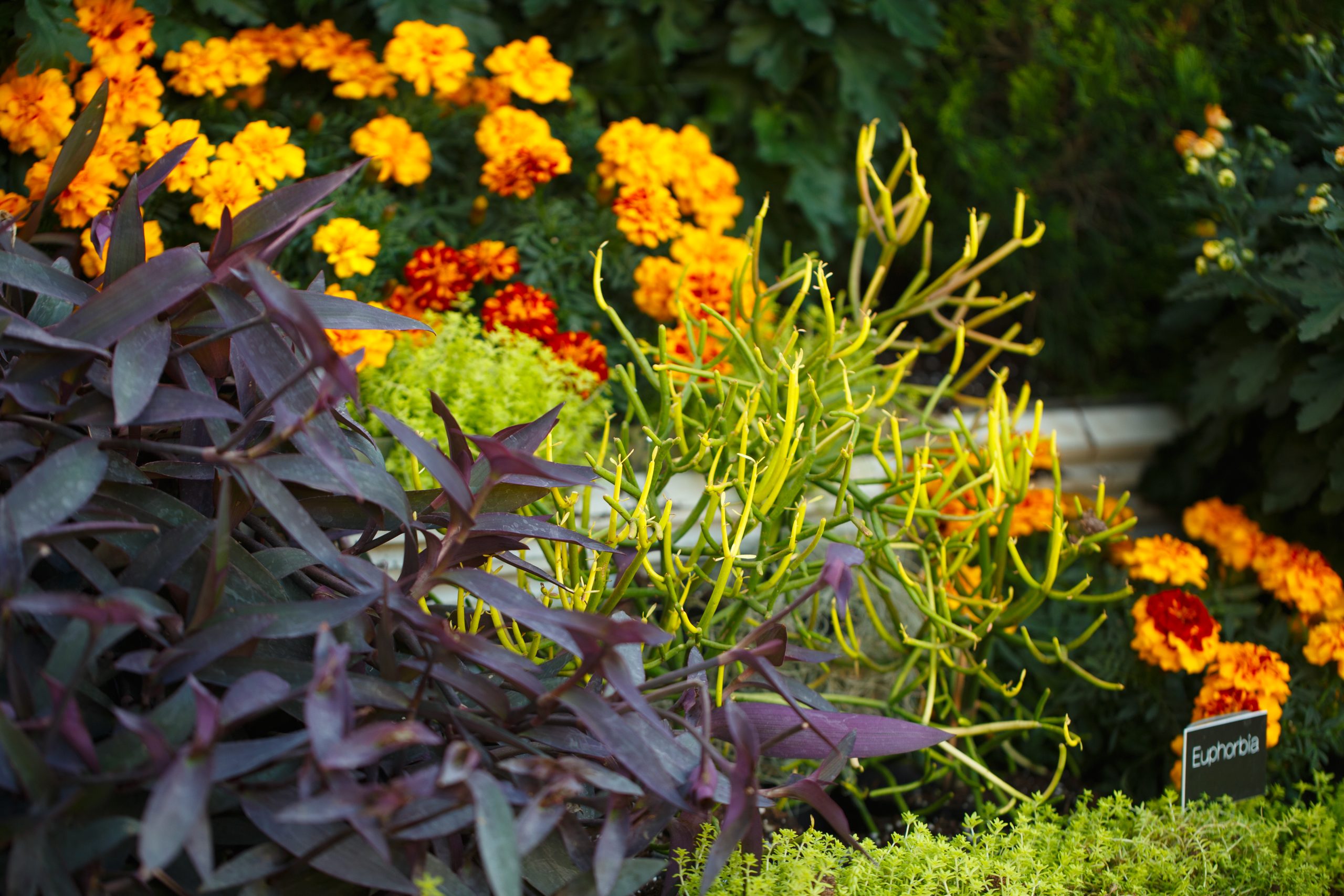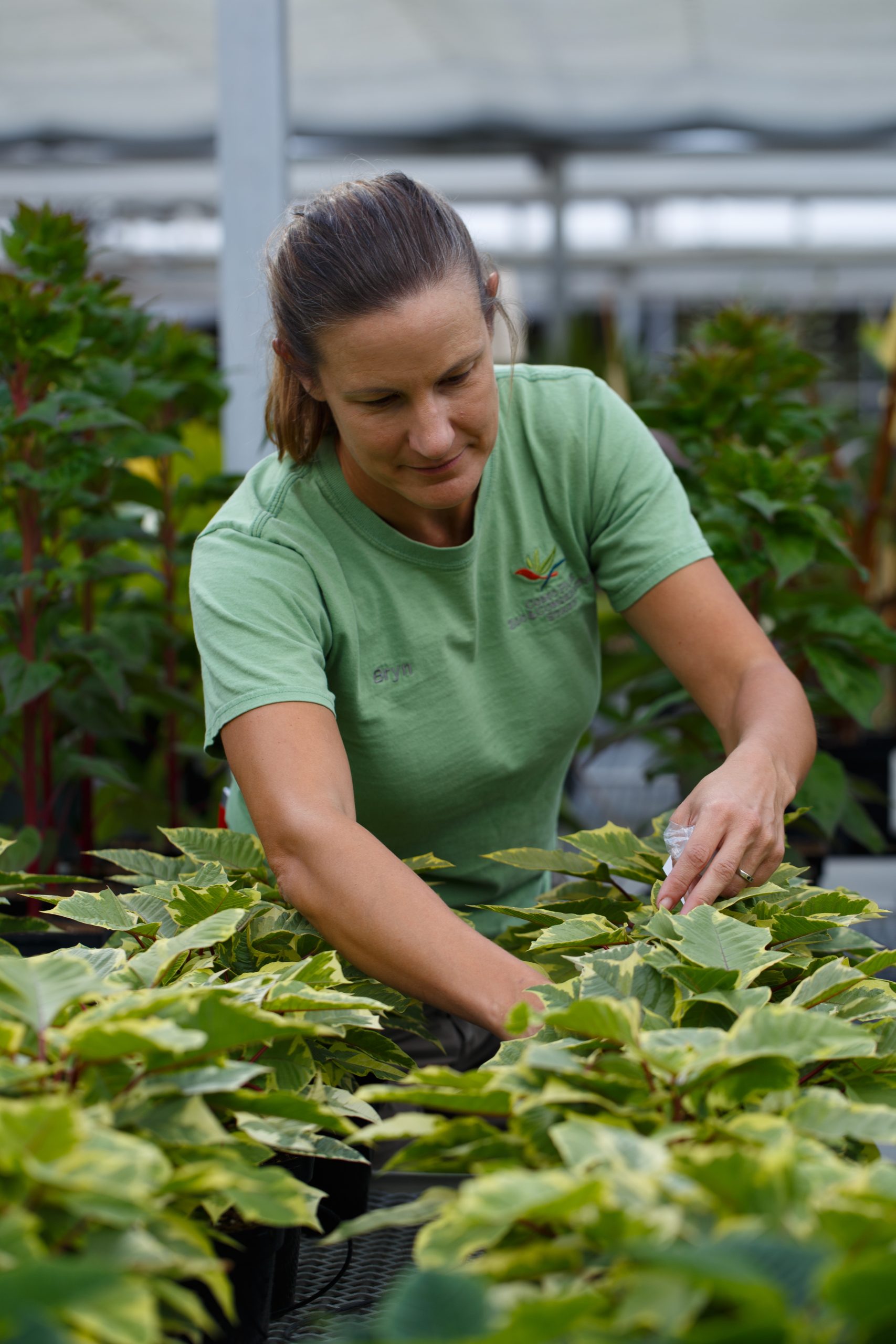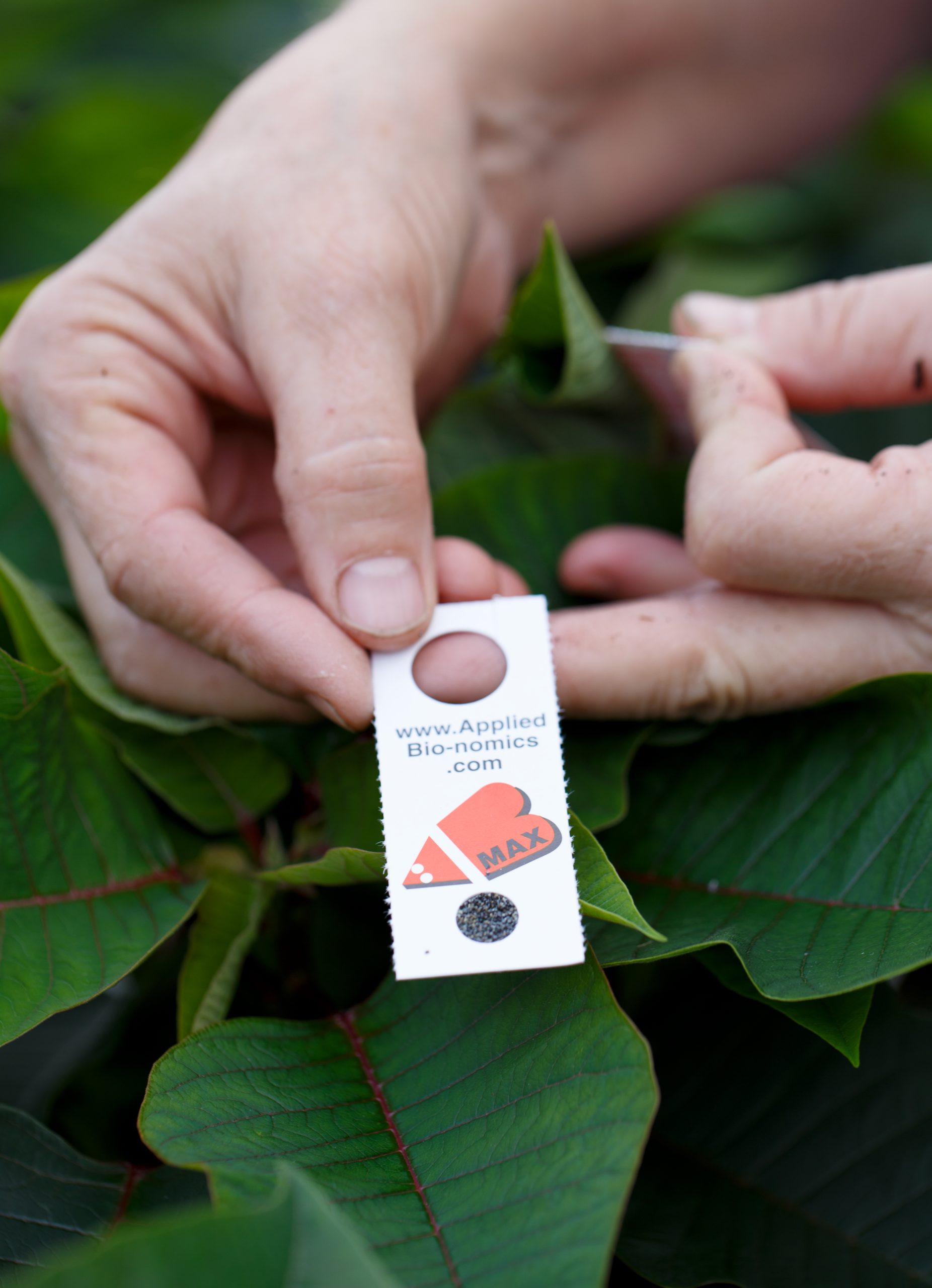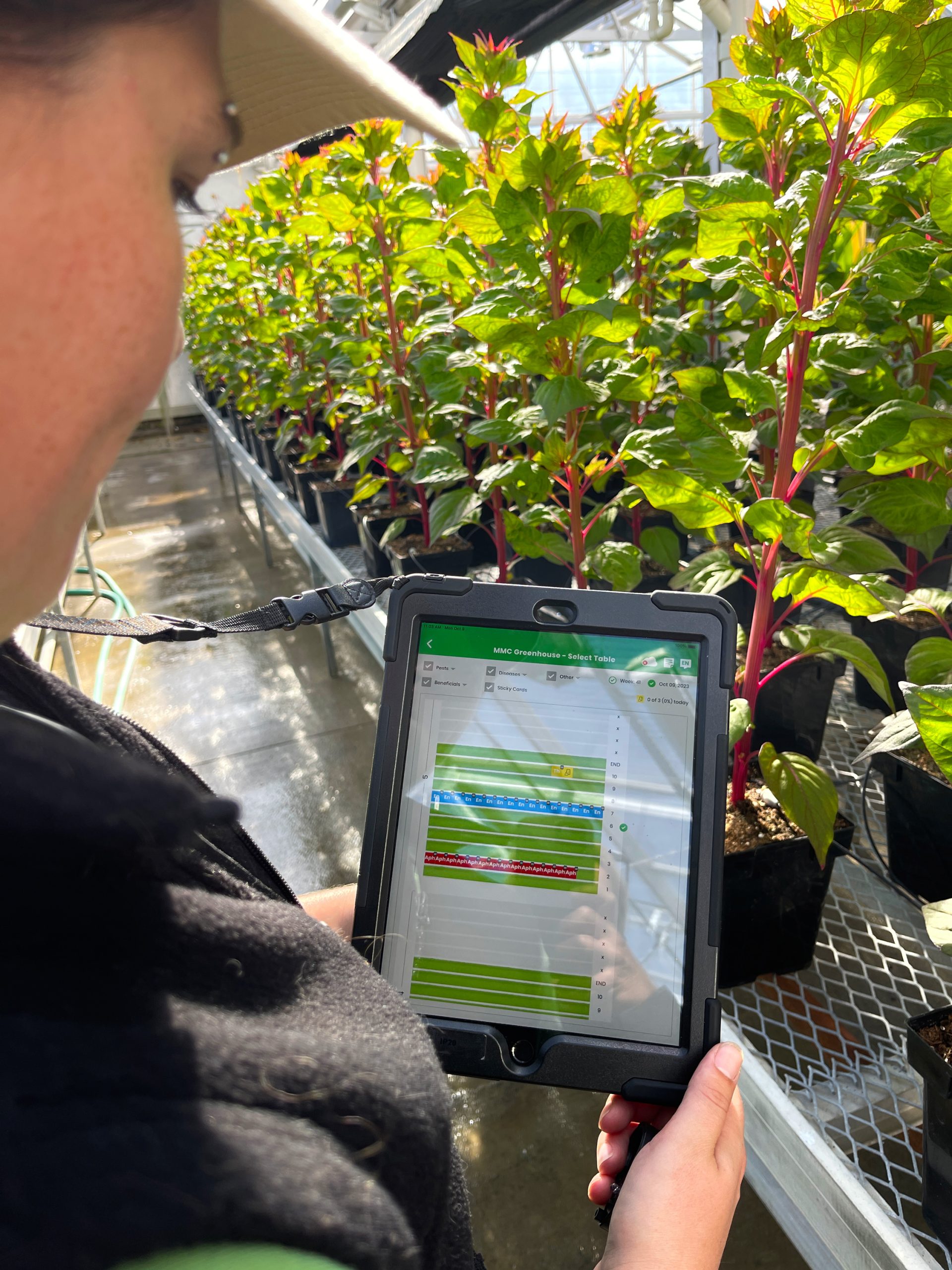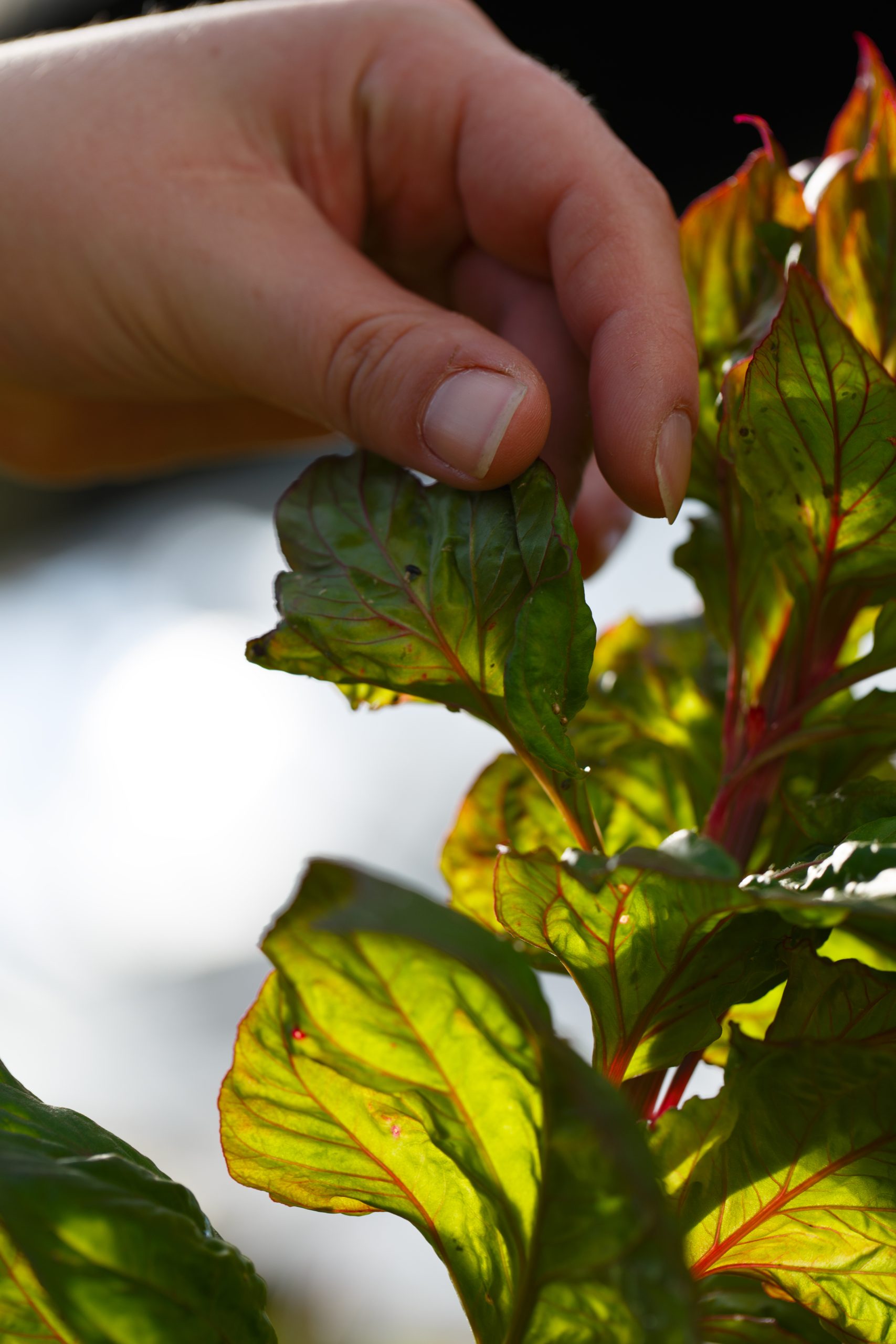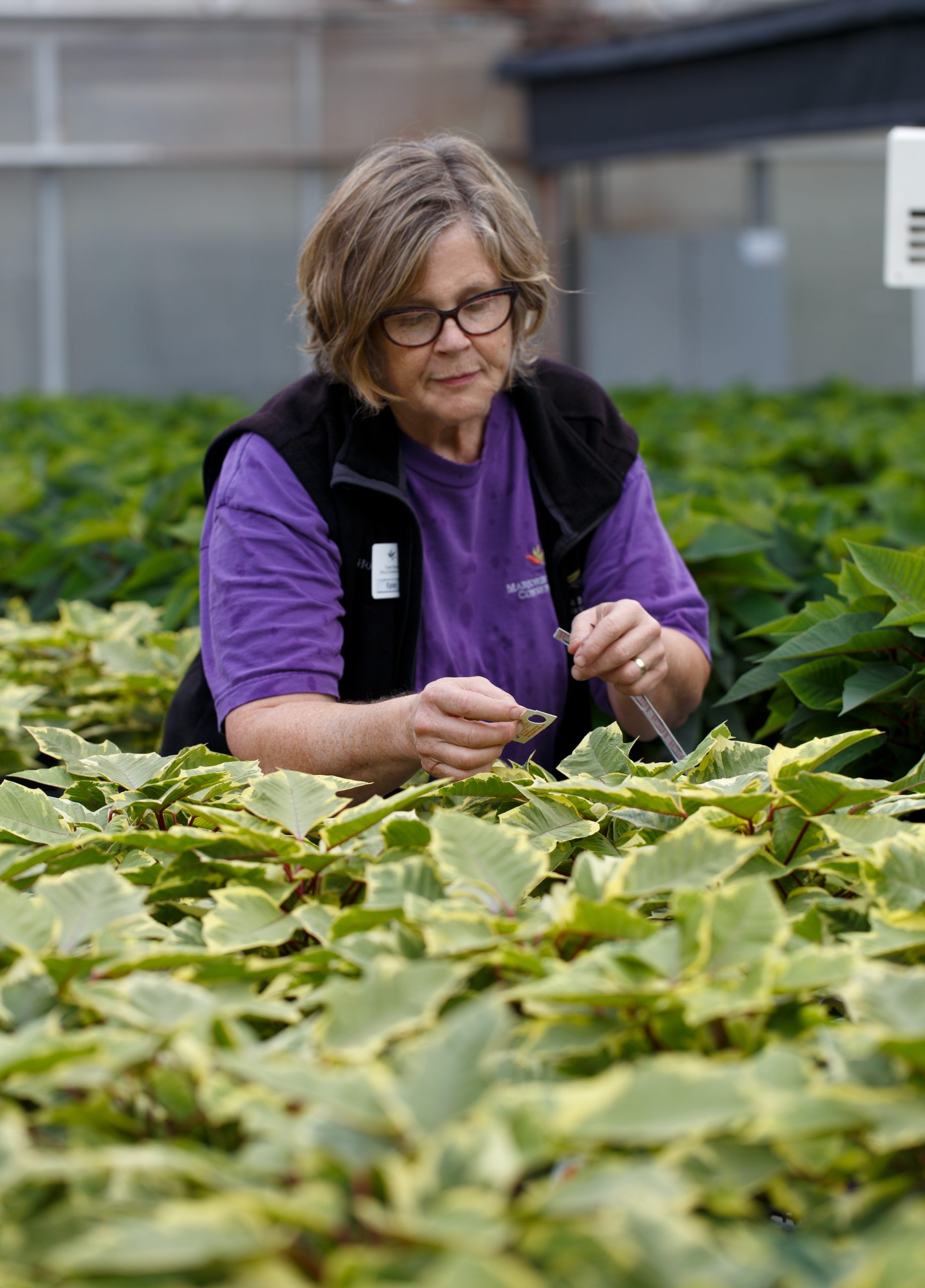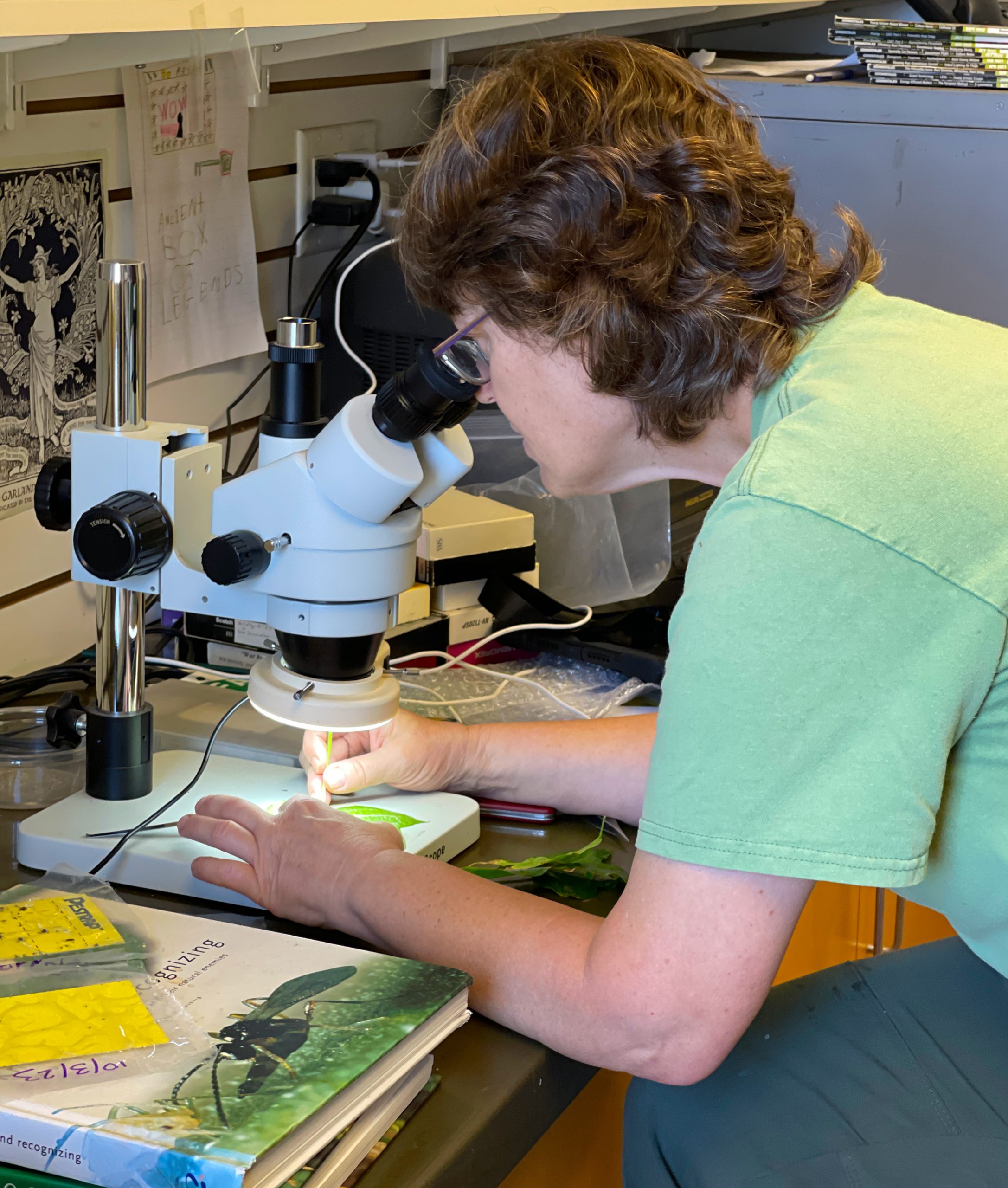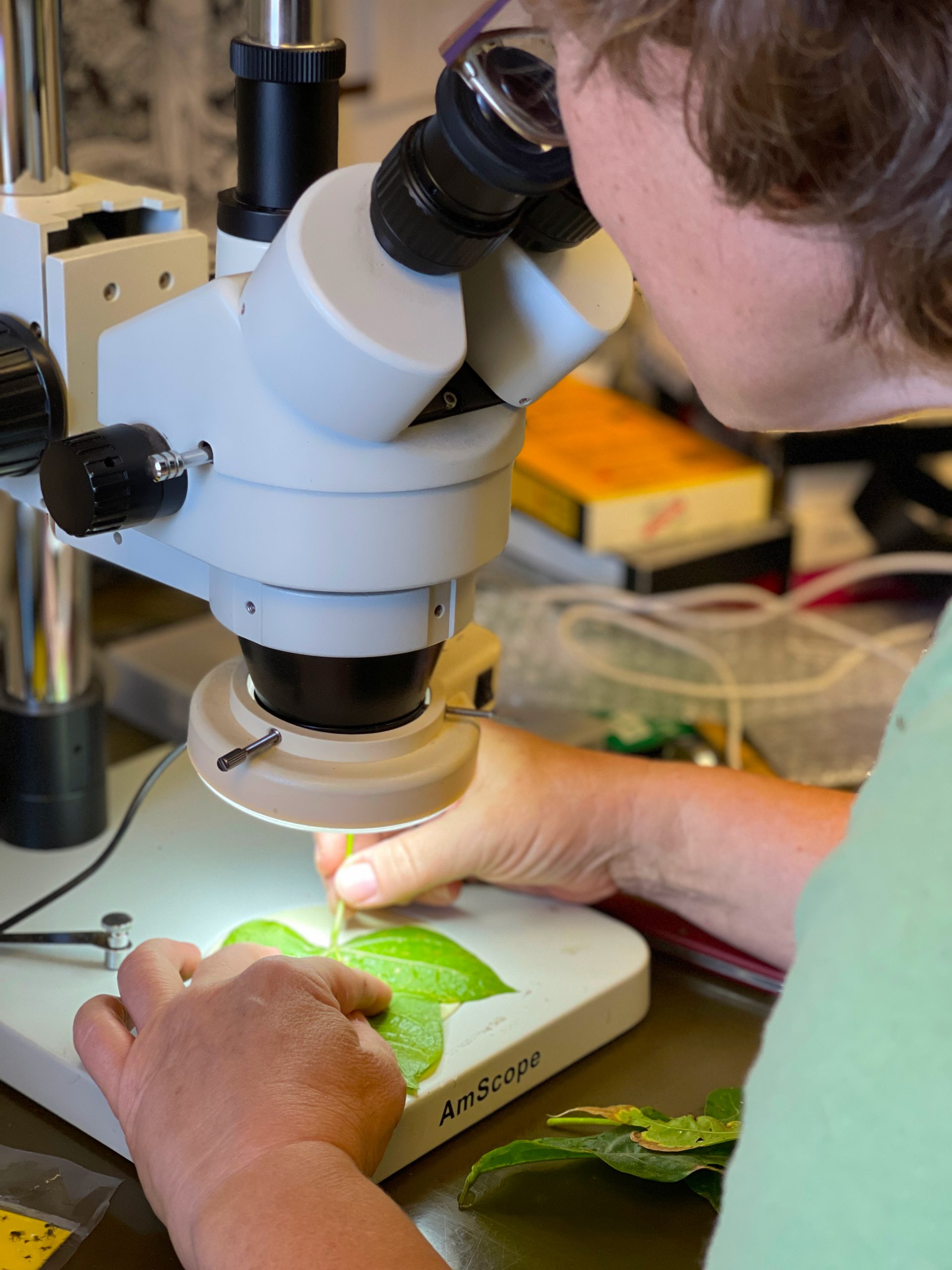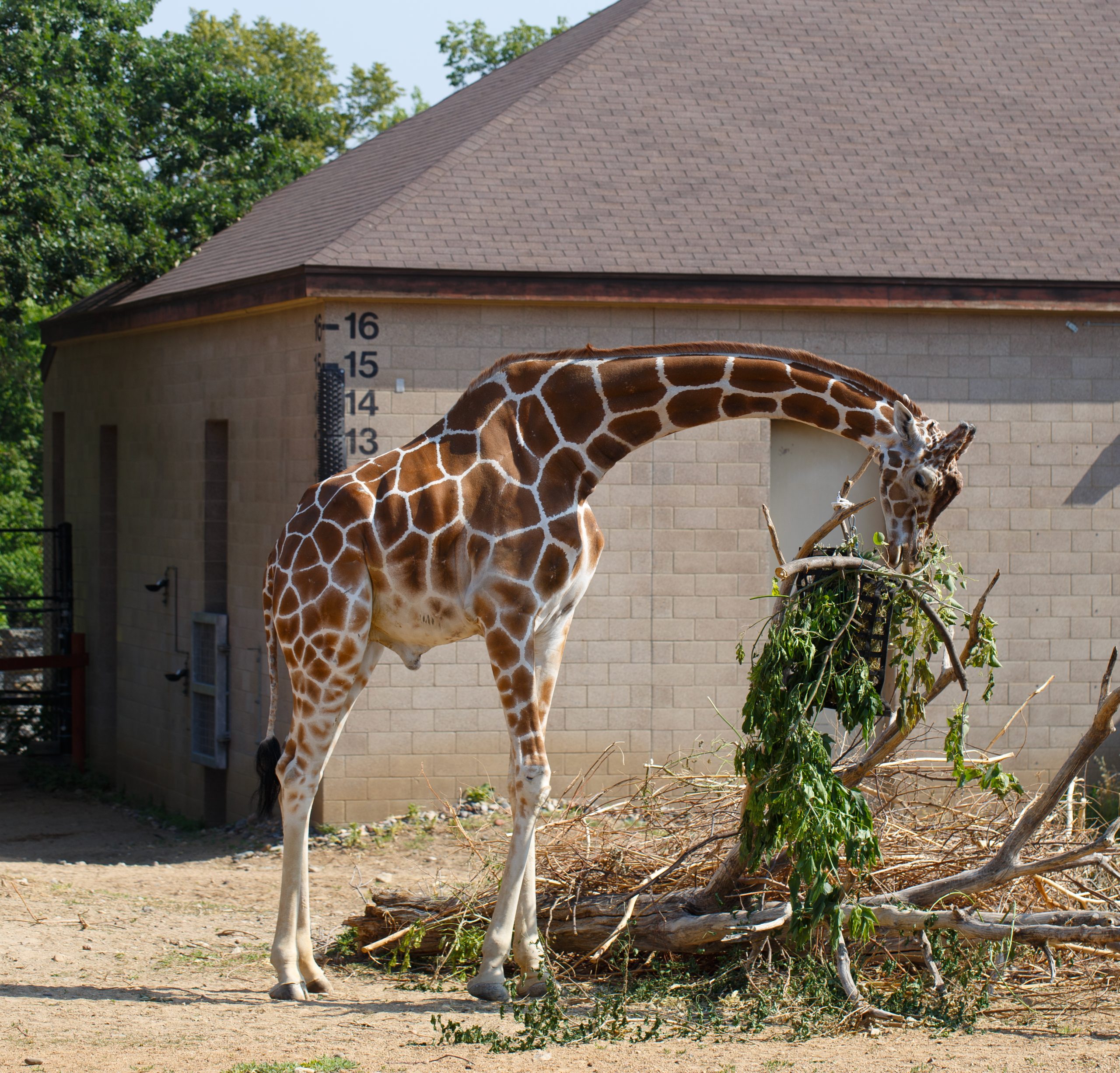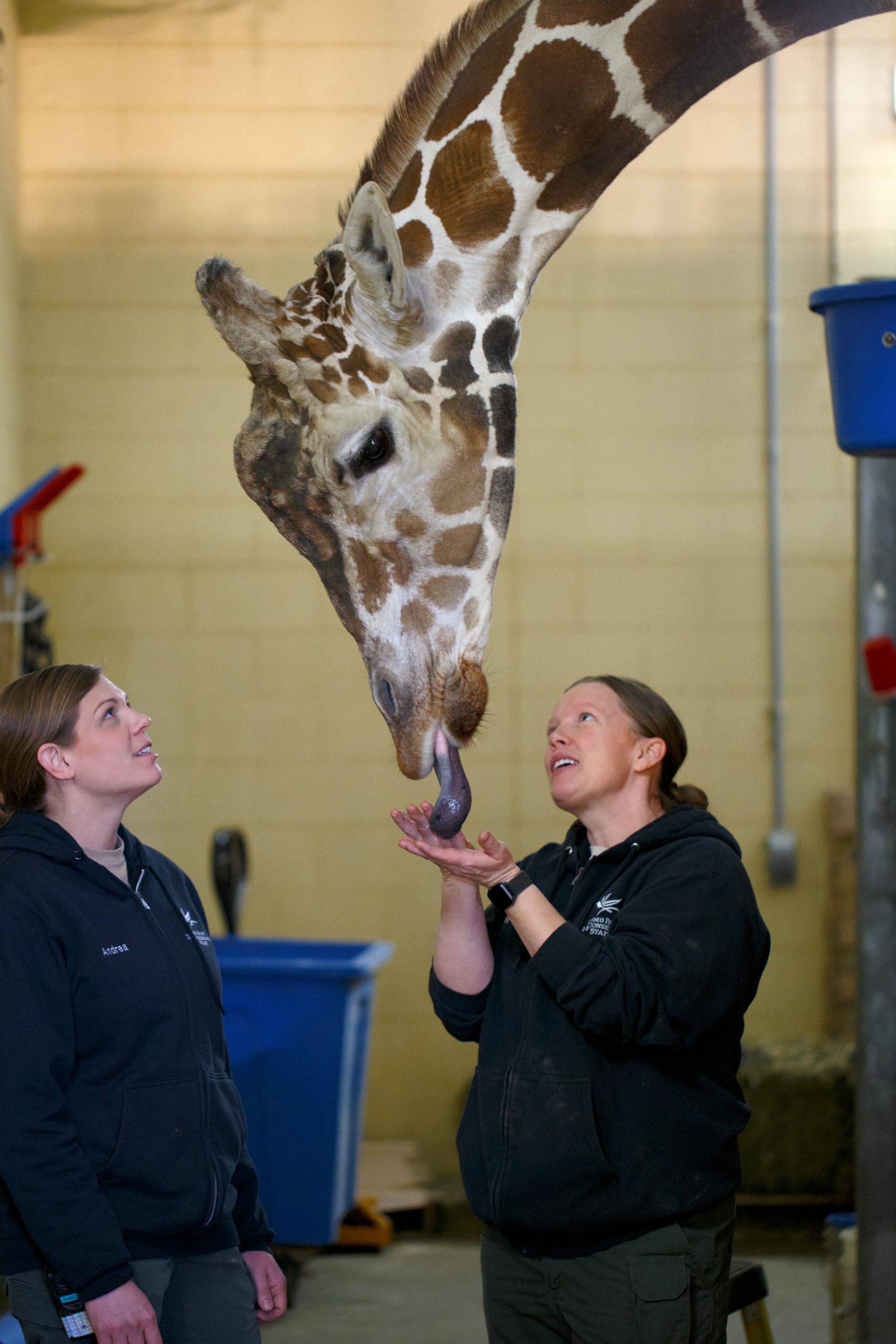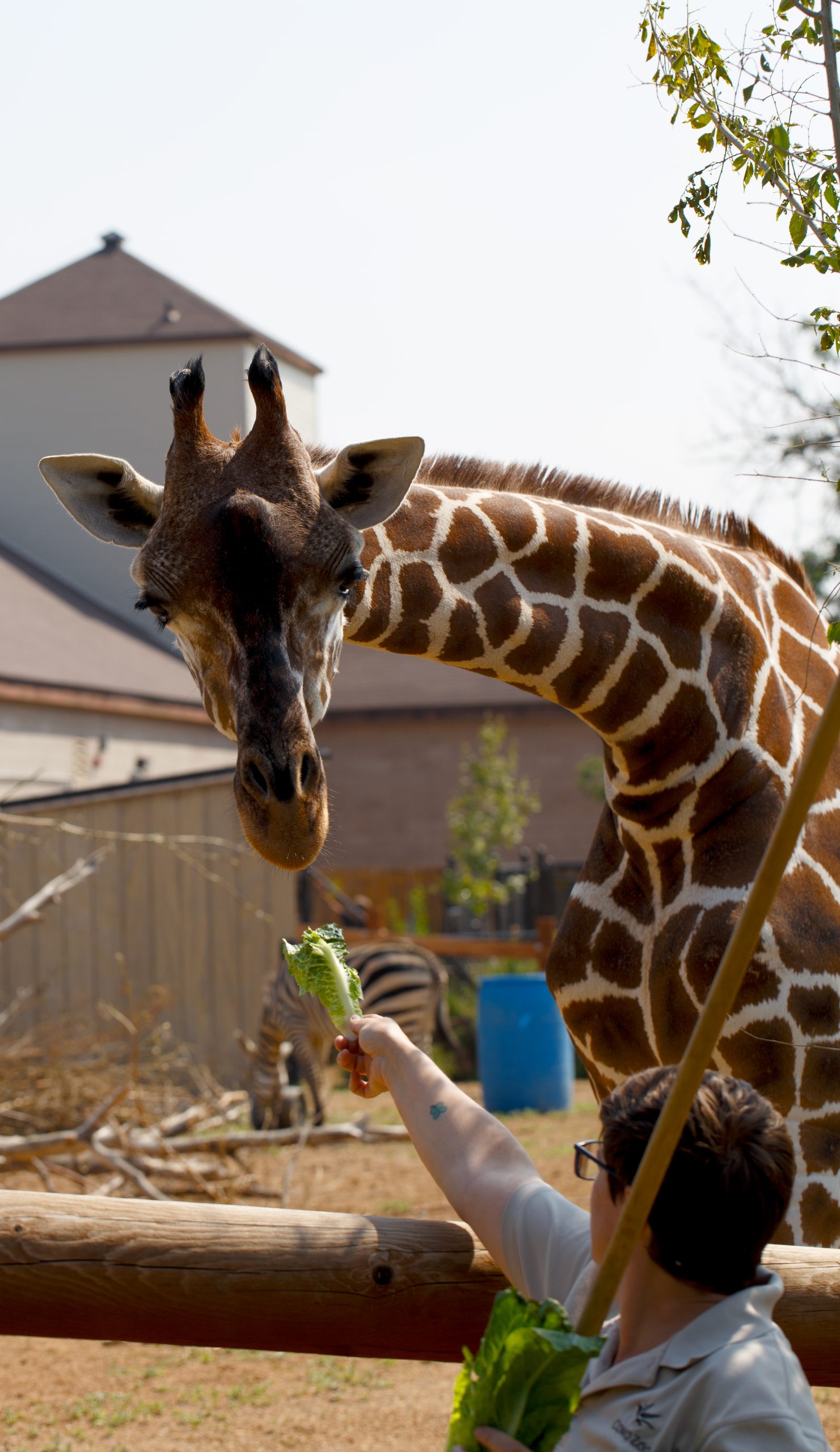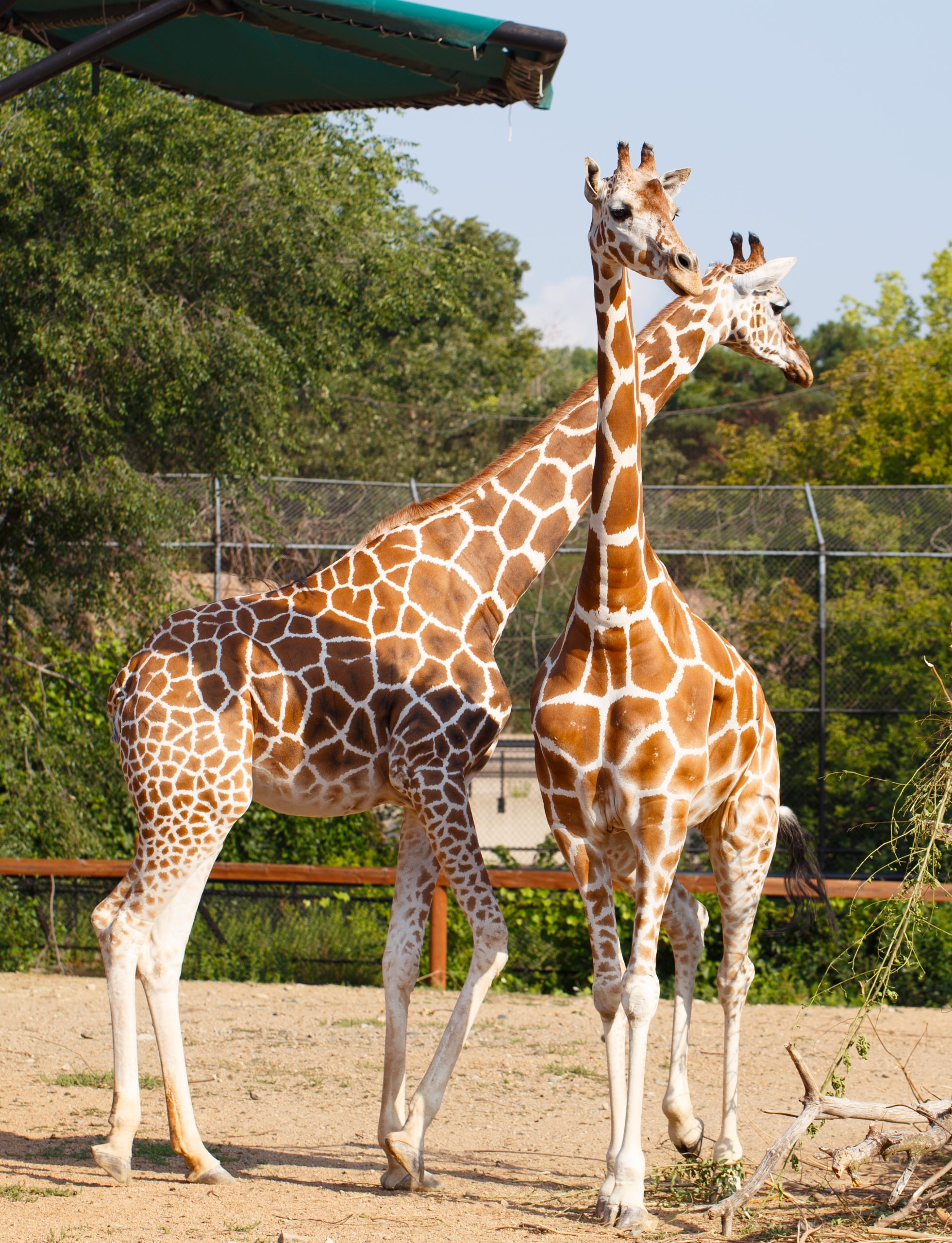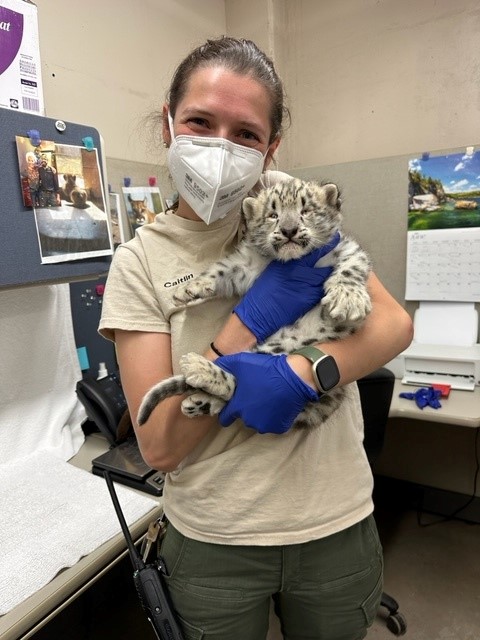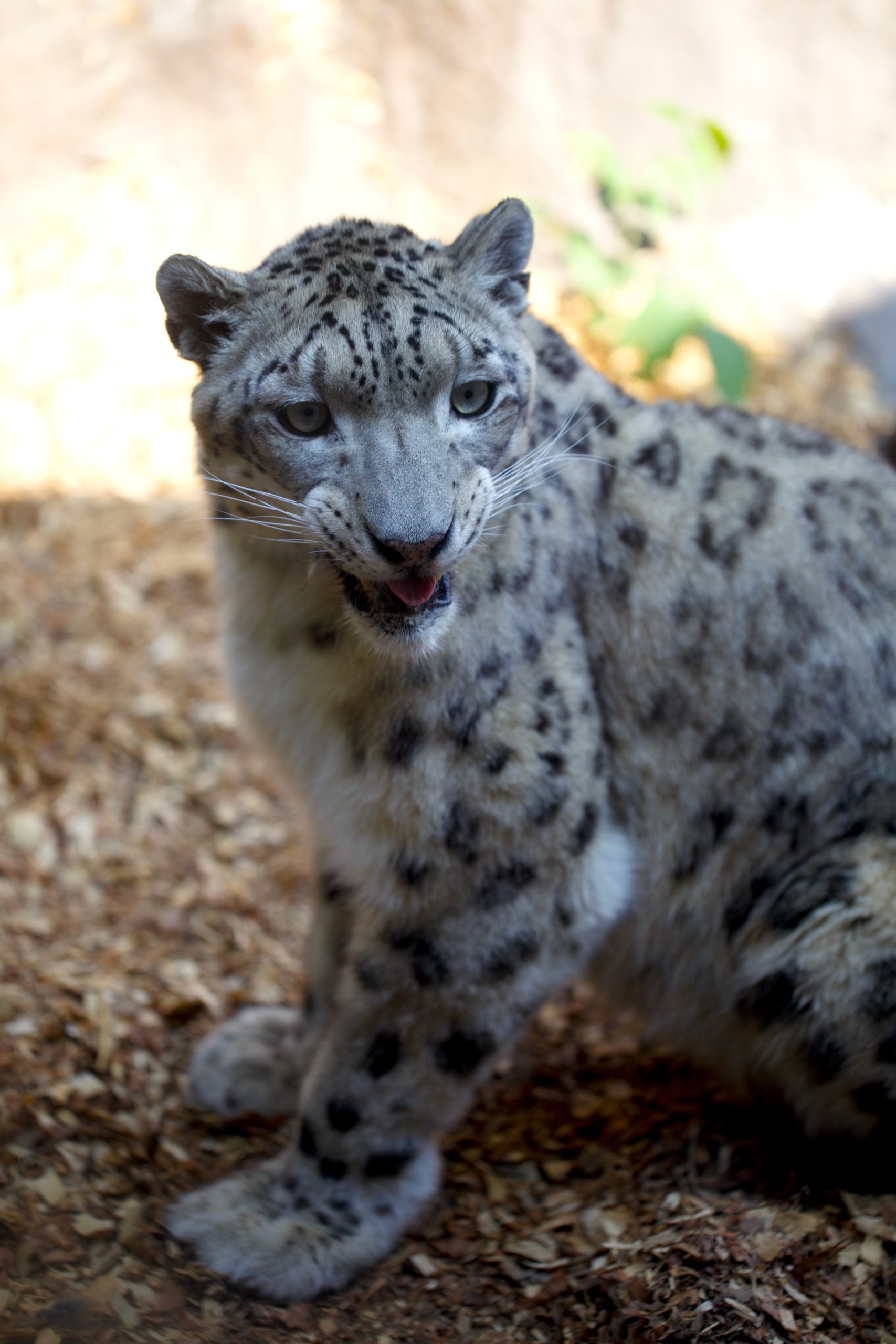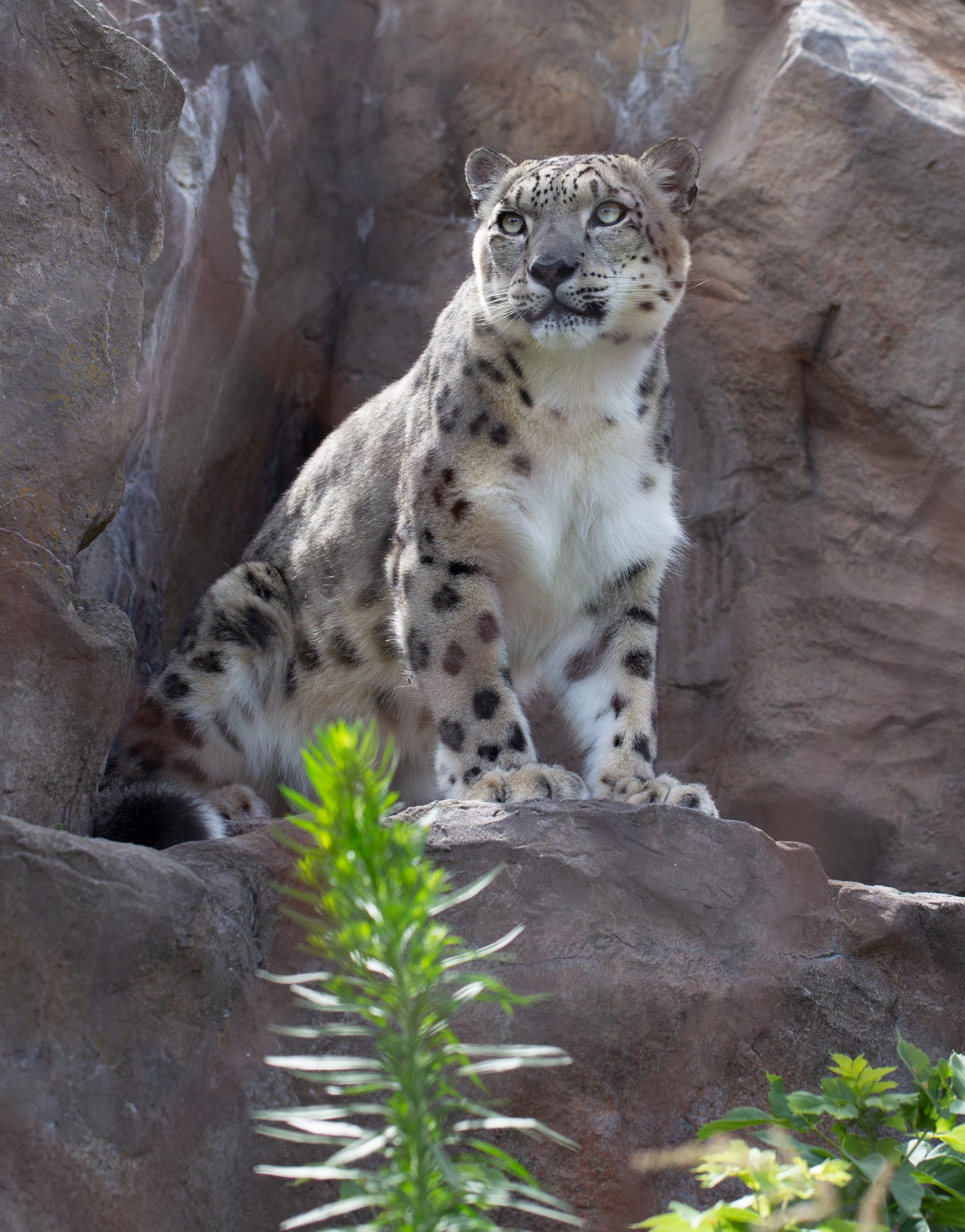Reusing, reducing and recycling is one of the secrets of Como’s Sunken Garden
Horticulturist Rylee Werden has fond memories of visiting Como with her mother and grandmother. “We always came to see the flowers together, so having the chance to design a flower show that connects with the Winter Carnival Orchid Show is really an honor.”

This season’s Winter Flower Show is a storybook example of an English-style cottage garden, with dense green foliage, deep pink and purple flowers, and a casually unkempt style—as if the garden is bursting out to fill its stone boundaries after years and years of growth.
“I was really inspired by the plant loropetalum which has a really nice weeping tree form and pretty flowers that I thought would make the pond look sort of enchanted,” says horticulturist Rylee Werden, who designed the show, her first for the Marjorie McNeely Conservatory. “From there I started building in more pinks and snowy whites and icy blues to play with the winter season. And the Winter Carnival Orchid Show coming later this month is what inspired me to use two of the flowers, a snapdragon called ‘Snappy Orchid Flame’, and a Viola called ‘Orchid Rose Beacon’”.
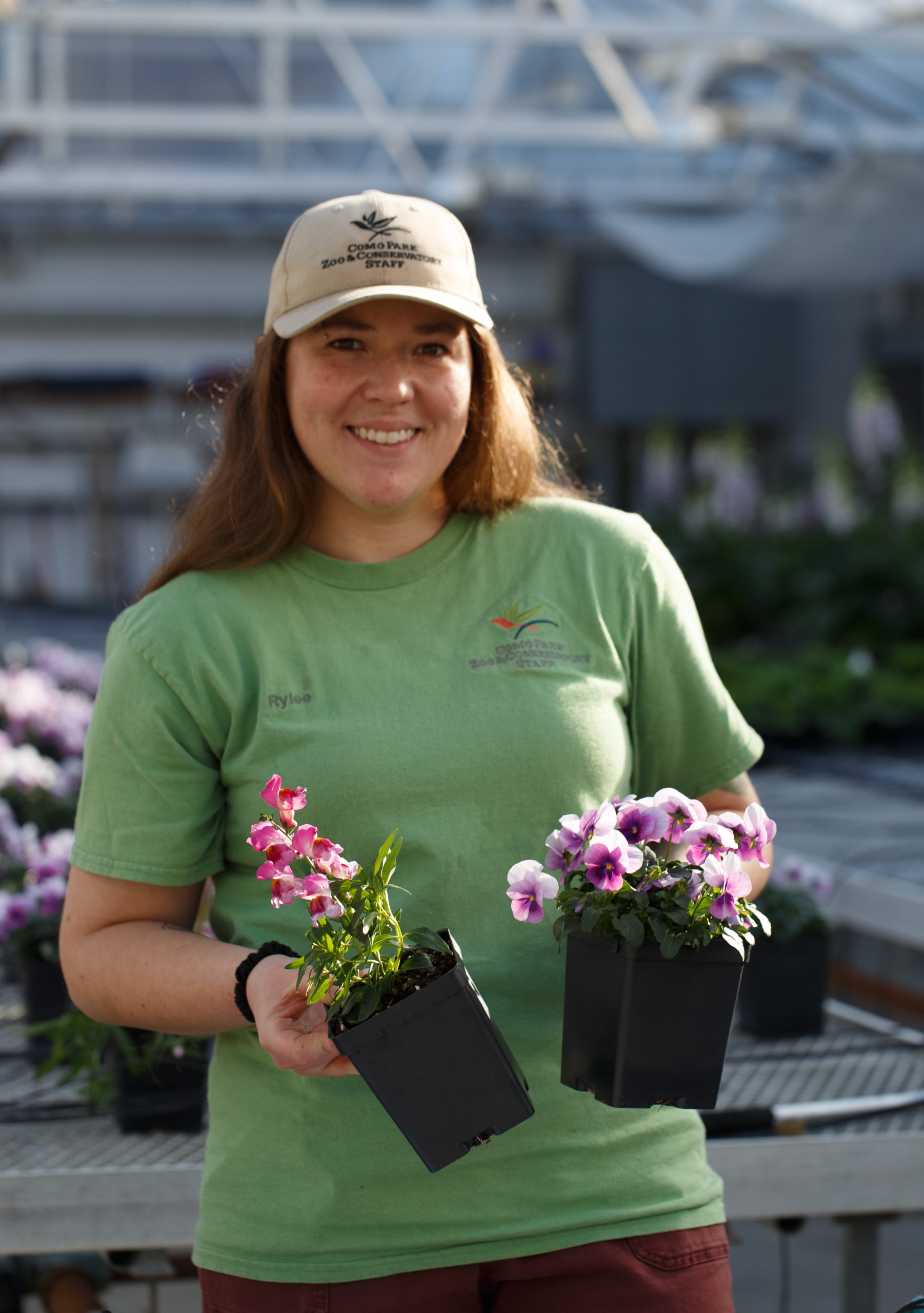
While most of the flowers you’ll see in this season’s show were grown from seed or plugs back in September, many supporting players in the Sunken Garden’s canopy were drafted from the Conservatory’s expansive greenhouse, design choices that are helping to make Como’s five seasonal flower shows more sustainable. For instance, the small birch trees featured in the Winter Flower Show were recently culled from the Charlotte Partridge Ordway Japanese Garden.
“Visitors seem to really love how they look, and we’re always excited to find a new use for what we already have,” says Werden. In fact, when the winter show is complete, the cuttings will be converted into birch poles for use in next year’s holiday plantings.
“As often as we can, we also try to give the plants and trees we use in the Sunken Garden a second life somewhere on campus, or in the community,” says Como’s horticultural curator, Dr. Lisa Philander. For years, spring bulbs pulled from the Sunken Garden have been recycled and resold through Como Friends’ Garden Safari Gifts, with proceeds that help pay for the next year’s bulb show. Your contributions to Como Friends are also helping the Marjorie McNeely Conservatory start a new on-site compost system with the capacity to turn tons of spent plant material into rich compost for future flower shows and gardens.
Making smart use of resources—from existing plant collections and from contributions from people like you—has helped Como Park Zoo & Conservatory keep its tradition of five rotating flower shows going for nearly 99 years. Thank you!
To sponsor the Marjorie McNeely Conservatory’s Sunken Garden visit:
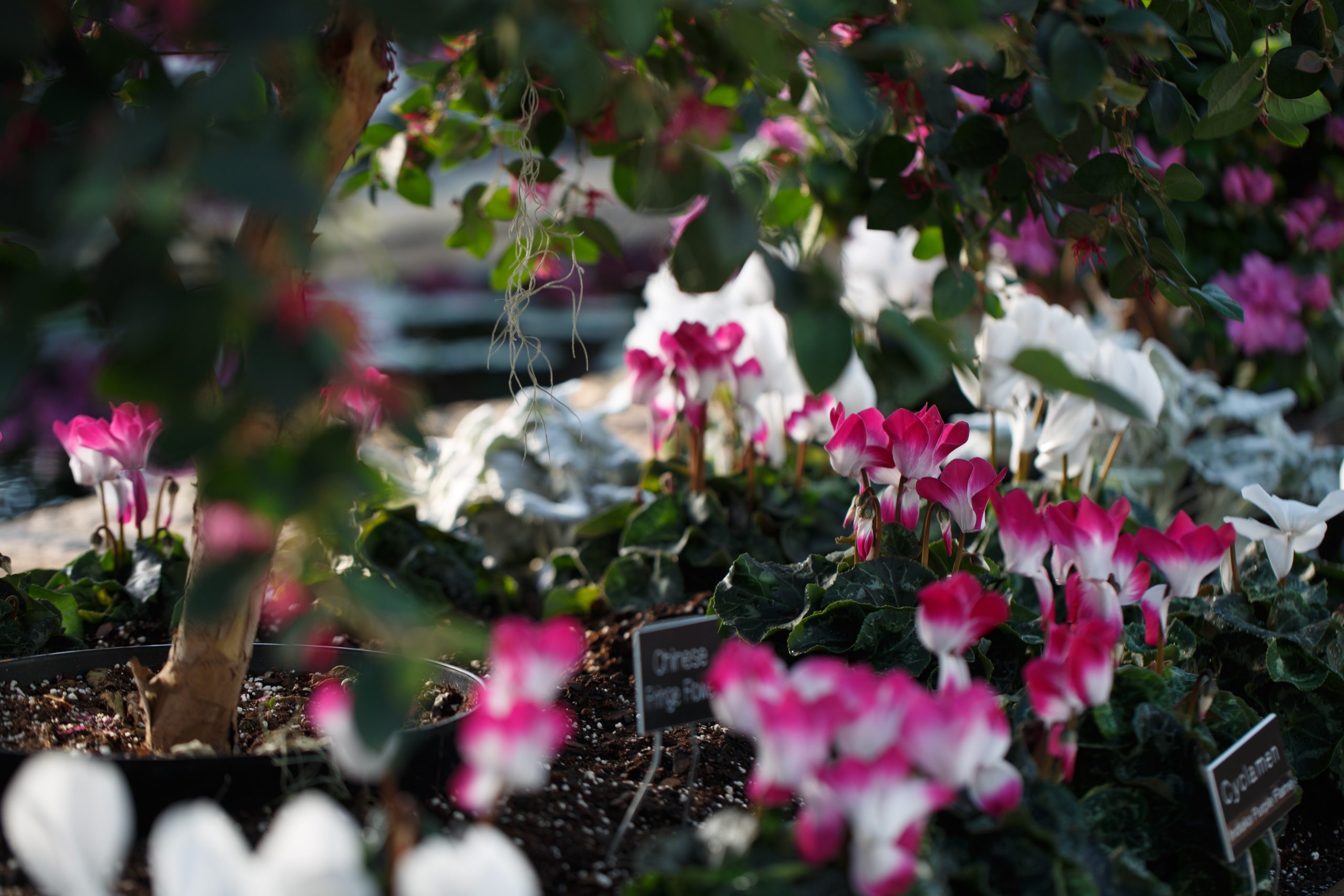
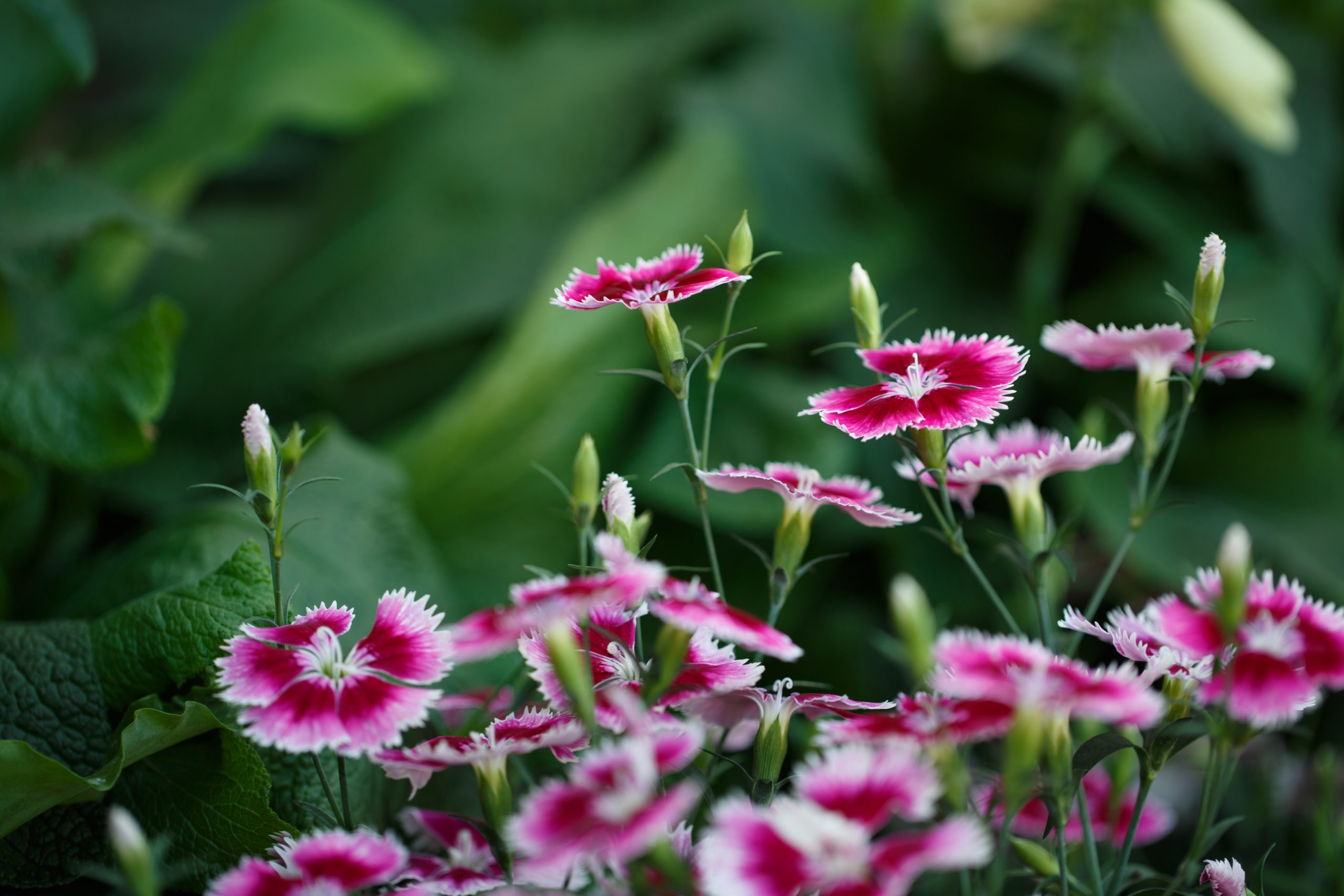
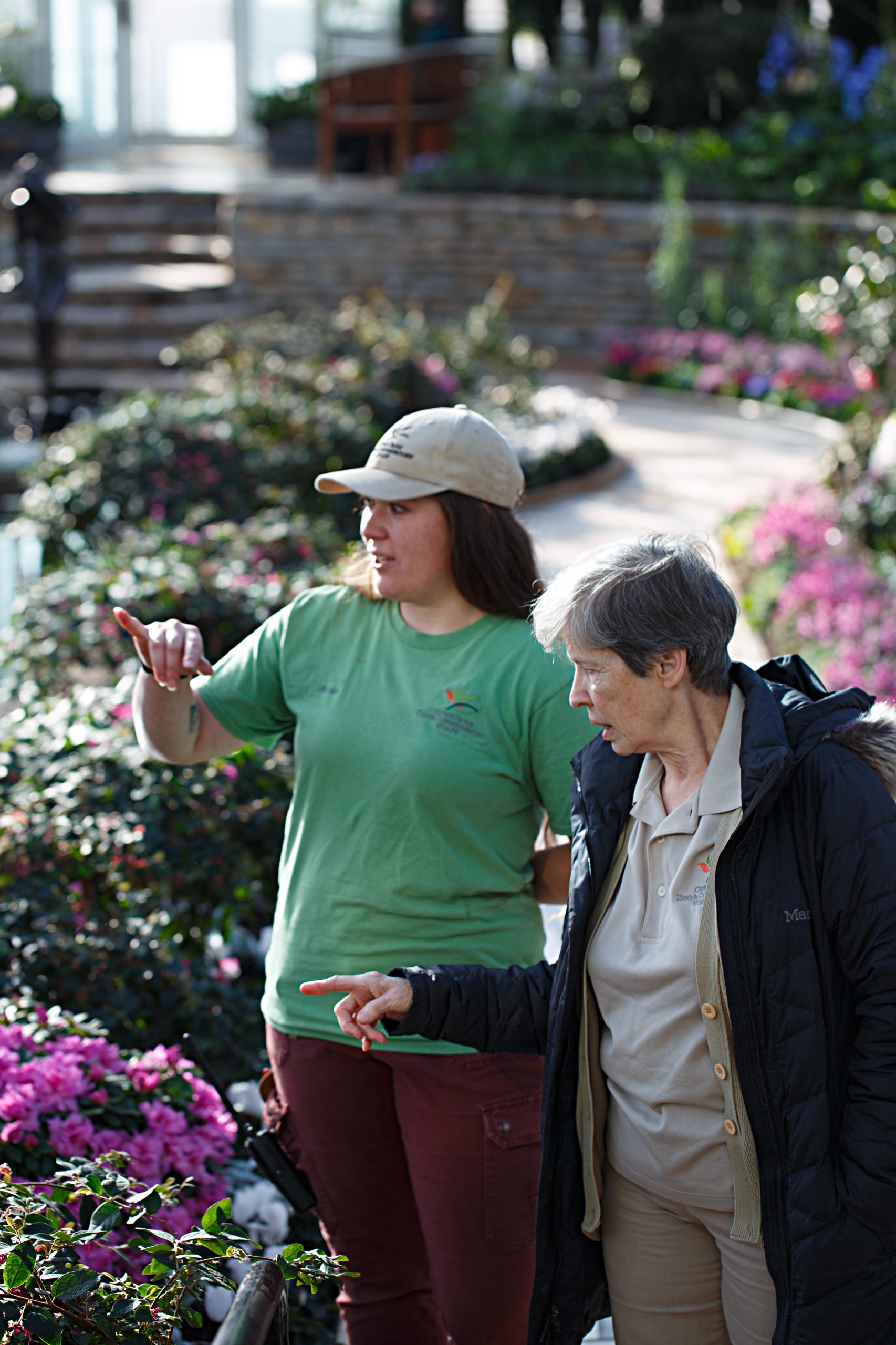
From the favorite foods Como’s animals love to the free field trips that inspire the next generation, your contributions to Como Friends make more possible
There are few things Como Zoo’s giraffes love more than browsing—wrapping their legendarily long tongues around the tiny twigs and tender shoots of tree branches and shrub cuttings that keepers place in their habitat. Browse is easy to come by during the growing season, but when the cold weather comes, Como’s hoofstock herd often has to wait until springtime to tuck into their favorite bushes and branches.
But thanks to your support for Como Friends, there’s a new giraffe snack solution on the horizon. With the help of donors, the African Hoofstock Building will have extra room in the budget to bring in fresh browse from warmer climes during the winter months, providing hours of munching, crunching, and curious exploration for Skeeter, Clover, Zinnia and Ivy, the cute new calf born in November.
The funding for the winter browse is just a fraction of the $1.83 million annual contribution to Como Park Zoo & Conservatory that your support for Como Friends made possible this year. “We know that gifts of all amounts from our donors have an incredible impact for the animals at Como Zoo, the gardens at the Marjorie McNeely Conservatory and for the people who love to come and experience Como throughout the year,” says Jackie Sticha, president of Como Friends. “Since Como Friends’ start back in 2000, that’s really been one of the most satisfying aspects of our successful public-private partnership—seeing the enormous difference that a little extra generosity can make in the care of the plants and animals we love at Como, and in the ways we serve the community.” Here’s a look at how your gifts made a difference in 2023:
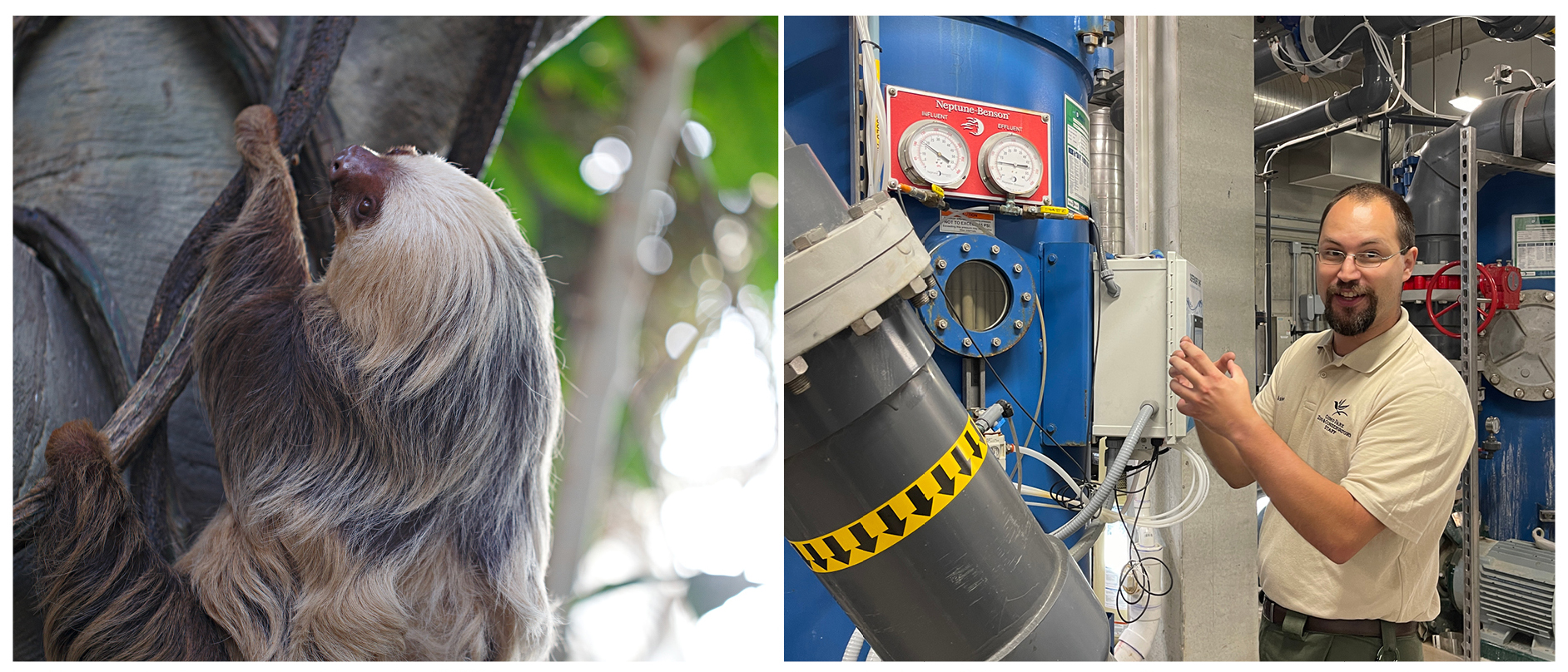
Tools and Training for Even Better Animal Care:
More than 20 years ago, Como Friends funding helped launch the positive reinforcement animal training initiative that’s helped to make Como Zoo a national leader in progressive care for animals of all sizes, from penguins to polar bears. This year, your generosity will support continued animal training consulting, advising Como Zoo’s professional keepers on new findings about animal behavior and best practice training techniques to benefit all of the animals in Como’s care. Contributions from people like you also make it possible to amp up Como’s arsenal of specialized equipment, from specialized crates to care for polar bears and large cats; scuba tanks and spectrophotometers to keep water habitats healthy for amphibians, fish, and marine mammals; to a new radiograph, tonometer and digital x-ray machine that allow Como Zoo to provide quicker, cutting-edge veterinary care to animals.
Como Friends is also making investments in more individualized animal needs. At Gorilla Forest, Schroeder’s tight-knit family troop will get a dedicated pathway for moving in and out of their habitat, giving gorillas greater choice about where they want to spend the day. A new shade structure is helping keep animals in the African Hoofstock habitat cooler on hot days. And in Tropical Encounters, Chloe the free-ranging sloth will be able to save even more of her energy with an expanded habitat that will allow her to stay in her tree 24/7, instead of retreating to her behind-the-scenes bedroom at night.
Cool Conservation Curriculum For All:
Always a trusted educational partner to area schools, Como’s conservation programs are coming back in full force this year. Thanks to your support, Como has the resources it needs to relaunch a second grade field trip program. This summer, as Como’s popular summer camp programs resume, Como Friends funding will also support camp scholarships to ensure that families have access to Como’s cool conservation programs.
Helping the Marjorie McNeely Conservatory Grow:
Over the years, your contributions to Como Friends have helped to keep many of Como’s best horticultural traditions growing, from the fantastic Holiday Flower Show on display this month in the Sunken Garden, to the continued transformation of the Charlotte Partridge Ordway Japanese Garden. This year, your contributions are helping preserve and protect Como’s extraordinary horticultural collections, with a new security system for Como’s valued bonsai collection, a new lighting system in the North Garden, and a new database that helps Como’s horticulturists keep track of all the specimens in Como’s beautiful gardens.
The rainforest habitat of Tropical Encounters was reenergized by a complete soil replacement, while a new sound system will help improve the visitor experience throughout the Conservatory. As part of Como’s continued conservation efforts, your support is also helping to implement a new composting system to save time and energy, turning last year’s plant material into rich compost, right at Como. Your support also helped the Conservatory launch a new integrated pest management system, deploying beneficial bugs throughout Como’s garden to further reduce the use of pesticides.
Free Admission for All:
Most important, your support for Como Friends helped Como Park Zoo & Conservatory make a full return to traditional operations this year, welcoming more than 1.75 million visitors—and counting. Thank you for all you do to support the natural wonders that bring our community together at Como Park Zoo & Conservatory!
The holidays are a great time to get closer to Como Zoo’s animals
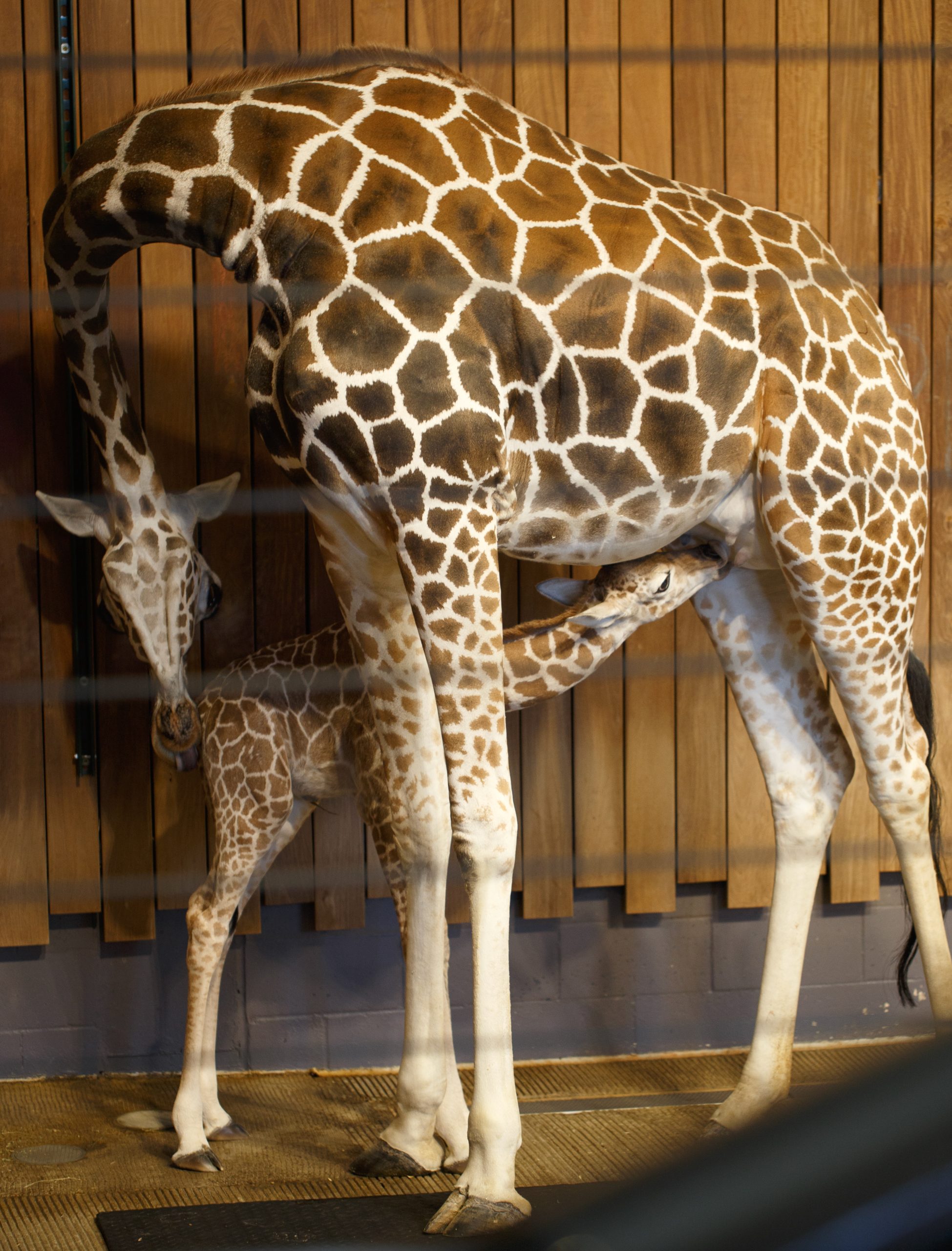
The summer months are always Como Zoo’s high season, but animal fans in the know often prefer late fall, early winter. “It’s one of the best times to be here, because the animals are so active and engaging,” says Como Zoo senior keeper Jill Erzar. “We heard from so many visitors how much they enjoyed being here on Thanksgiving Day and how wonderful the animals were.”
Some of that excitement is due to a flurry of furry new faces, all recently arrived at Como Zoo. Here’s a look at some of the new animals you’re likely to encounter on your next Como visit.
-
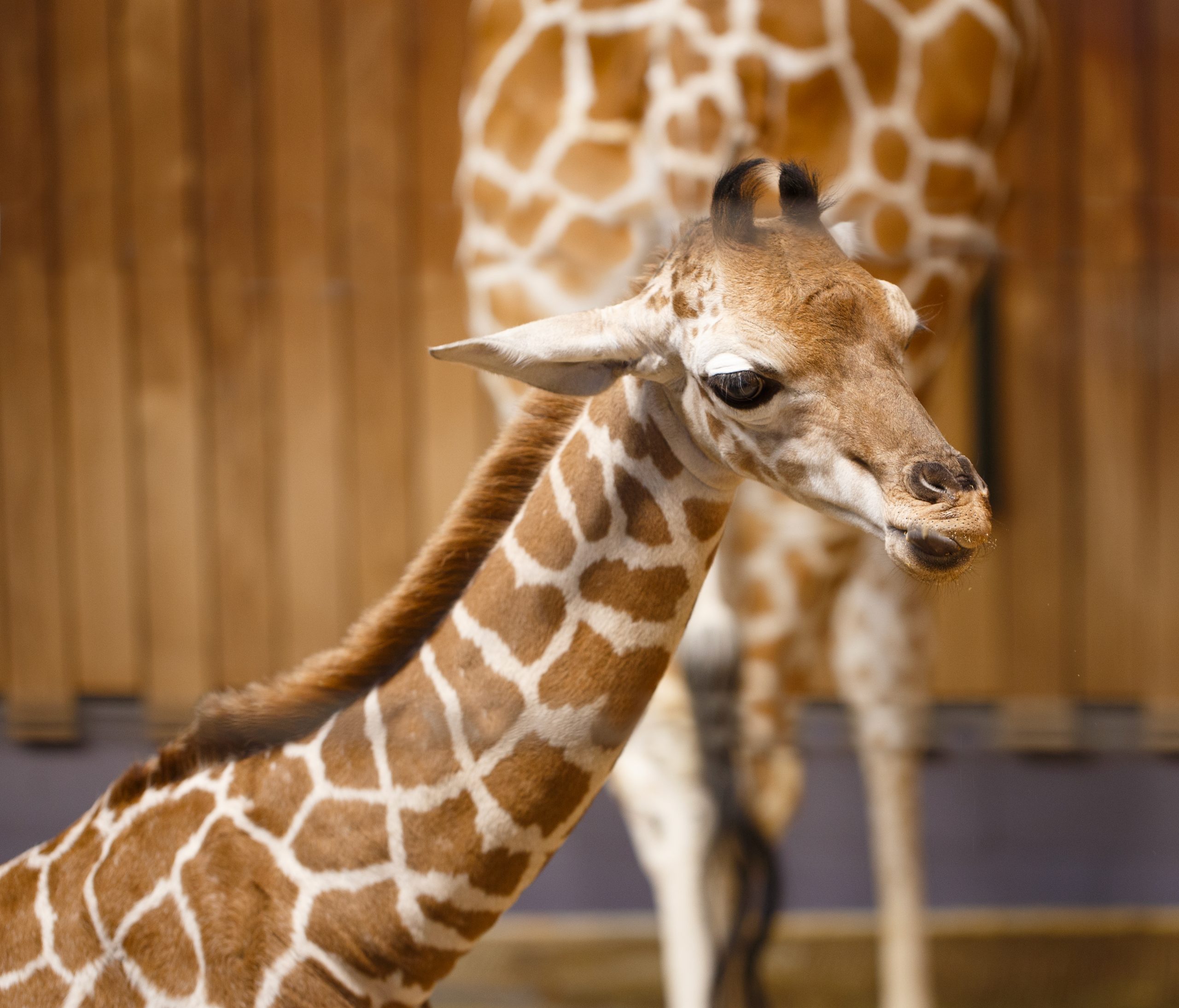
Ivy
A social media star within hours of her arrival, this six foot tall, 132-pound baby giraffe has been captivating crowds and keepers alike. “She is incredibly feisty,” Erzar says, noting that it took four keepers to keep her still during her neonatal “well baby” exam just 72 hours after she was born. “We can’t walk by her without her attempting to kick us.” Her fighting spirit is a great sign of her overall health, and the doting care she’s getting from mother Zinnia, a seven-year-old female who moved to Como Zoo last summer. When it came time to name the new giraffe, more than 15,000 Como visitors voted from among three plant-themed names to pick their favorite. Judging by how fast she’s growing, Ivy is just the right choice.
-
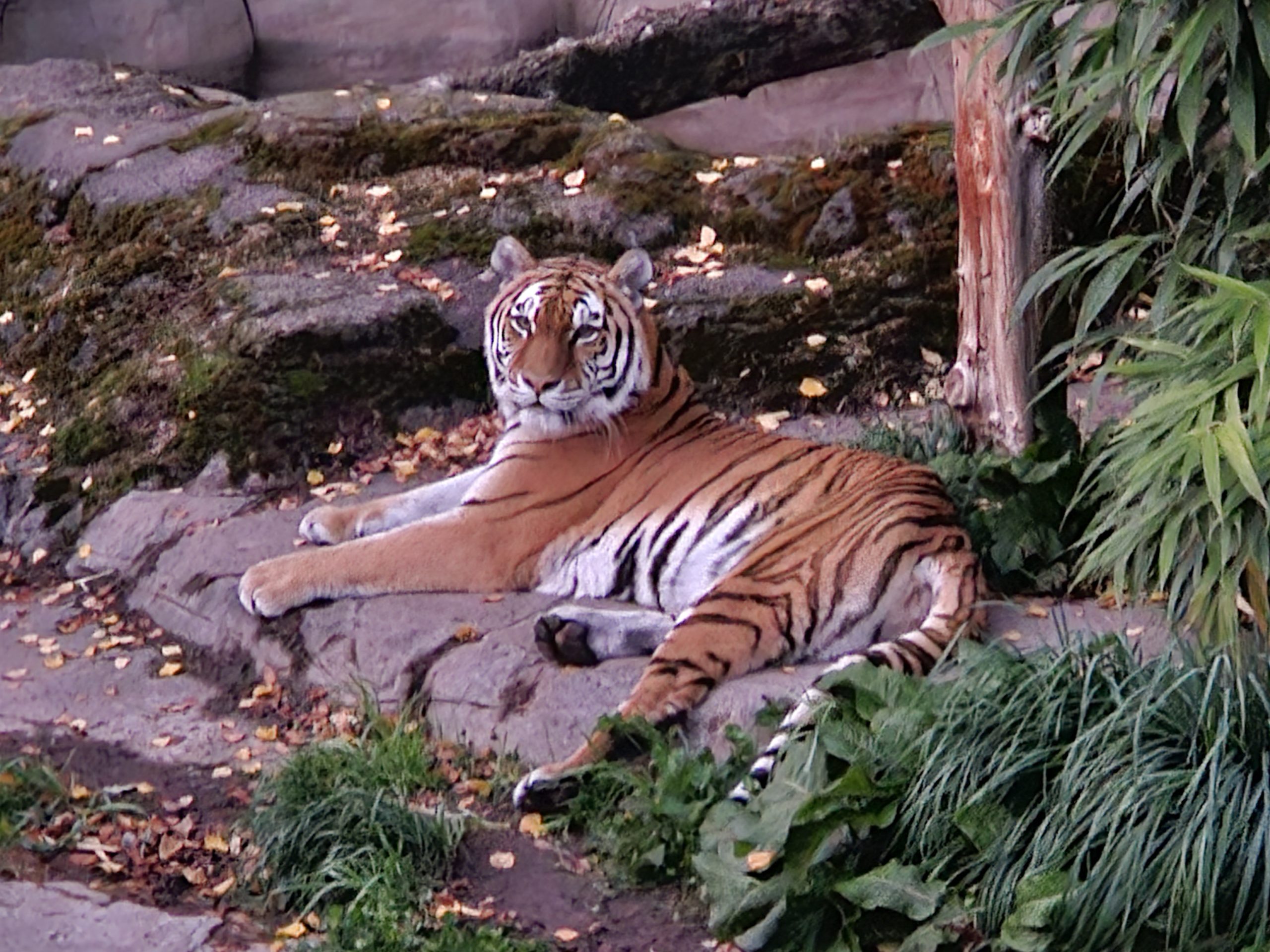
Bernadette
Still skittish about making her public debut at Como Zoo, visitors have definitely heard the new female tiger making noise behind the scenes. “She’s a nice, calm, and very vocal cat,” Erzar says about the nine-year-old female originally from the Oregon Zoo. While she’s getting used to her new surroundings, keepers are taking their time introducing her to Tsar, a male tiger that could become her breeding partner. “Tiger introductions are a big deal,” Erzar says. “They’re normally solitary cats with the potential to injure each other, so we want to take the time to ensure there aren’t any issues.”
Photo courtesy of Zookeeper Megan Hagedorn, Oregon Zoo
-
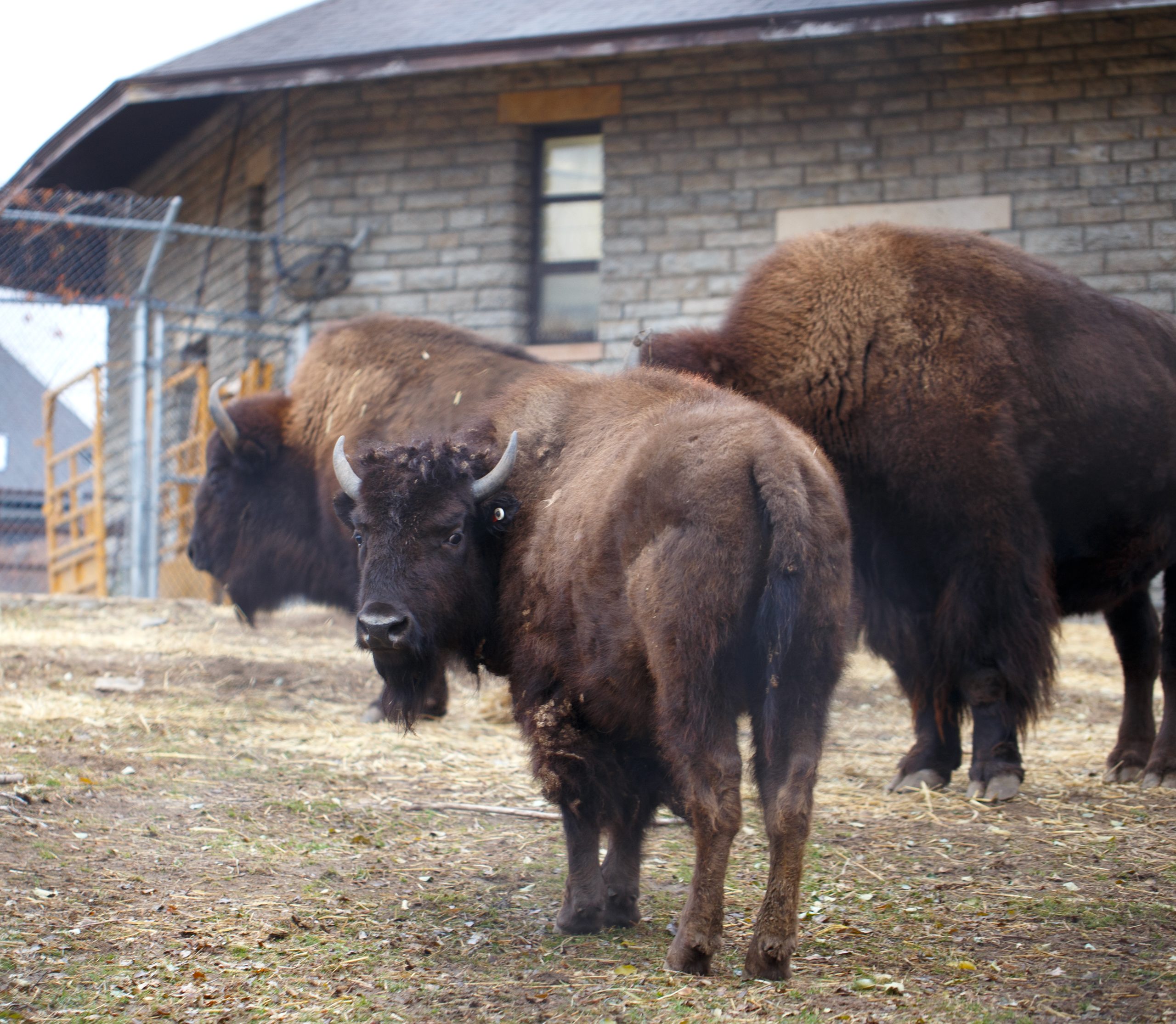
Ruby
At nearly 700 pounds, this bison is definitely the biggest arrival Como Zoo has seen all year. But at only 16 months old, Ruby will also have plenty of room to grow in Como’s newly expanded bison habitat. Ruby is a member of the Minnesota Bison Conservation Herd, a collaboration between the Department of Natural Resources and the Minnesota Zoo, which is working to protect the genetic diversity and future health of the state’s growing bison herds at Blue Mounds State Park, Minneopa State Park, and the Spring Lake Park Reserve Bison Prairie. “She’s getting along very well and seems to really like our male bison, Bogo,” says Erzar. As winter weather descends, Ruby and Bogo will be in their element, with wooly coats that can help them withstand temps of -40F, and 50-mile-an-hour winds.
-
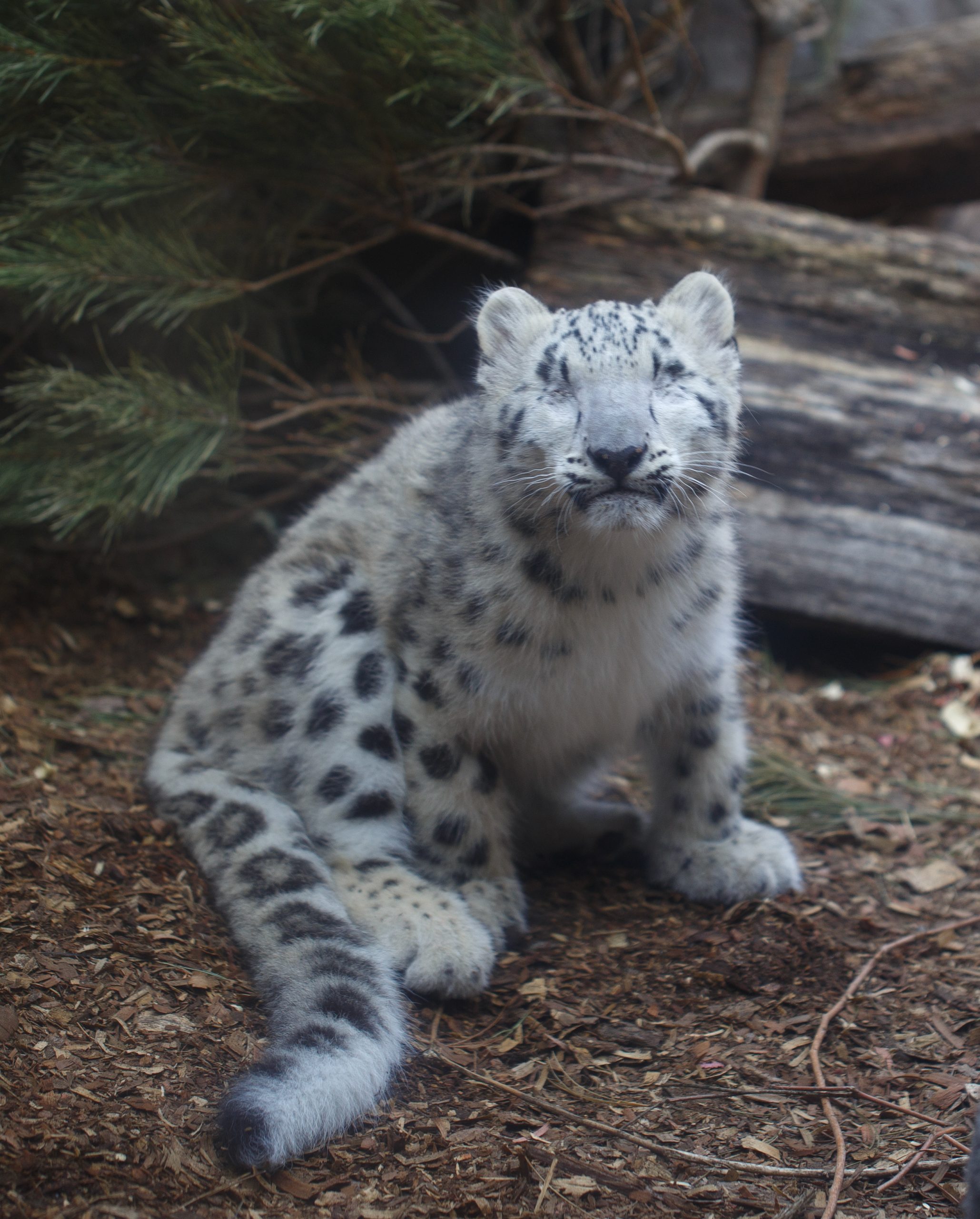
Willow
Born in May, this snow leopard cub has become a visitor favorite for her adventurous spirit and natural curiosity. Though she was born blind, she’s been an intrepid explorer in the habitat she shares with mother Alya, occasionally climbing to heights that she can’t quite figure out how to come down from. “She is very playful and living her best life,” says Erzar, who says that the young cub is also showing growing interest in her keepers, especially now that “she’s realized that’s where food comes from.”
Permanently blind due to multiple ocular colobomas, the young snow leopard underwent an operation earlier this year to remove retinal tissue that could cause health troubles down the line. “She will be blind the rest of her life,” says veterinary ophthalmologist Dr. Melissa Lively, who confirmed the cat’s diagnosis this spring. “But because she’s never had vision, she’s never known anything different, and she’ll be able to do everything a normal snow leopard cub could do. We know that cats are fantastic at using their touch, their hearing, and their sense of smell to explore their habitat and run zoomies just like a visual cub would do. In the wild, this cub would not survive moving through vast environments without being able to see where prey is coming from, but in this zoo setting, blind cats can thrive. Especially with all of the great care they get at Como Zoo.”
Willow’s parents Moutig and Alya will be visible in the outside habitat this winter while keepers help Willow learn to safely explore her habitat through more training behind-the-scenes. Working to meet the special needs of individual animals is one of the many ways that Como’s care team helps animals of every species thrive.
The diverse color possibilities of Poinsettias are now on display at the Holiday Flower Show, featuring ‘Ferrara’ red, variegated ‘Tapestry’ plants with yellow & green leaves, and yellow ‘Golden Glo’ Poinsettias. Yellow flowering kalanchoe, hibiscus, and lemon cyprus add tropical accents to one of the most visited flower shows of the year.
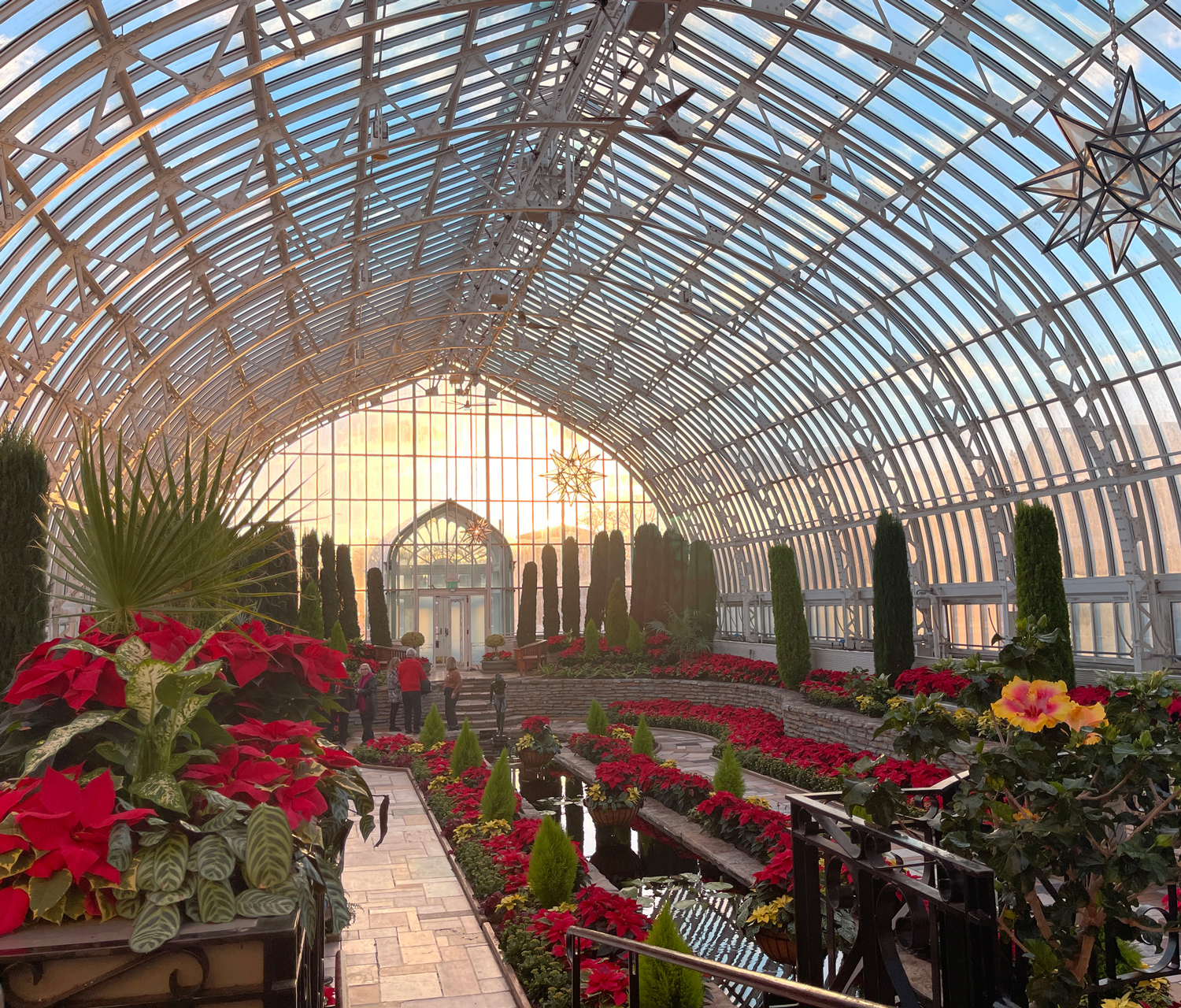
Known as the flor de nochebuena—or Christmas Eve Flower—in their native Mexico, it’s no wonder Poinsettias have become the quintessential plant of the season. Available in endless shades of reds, pinks, creams, and greens, Poinsettias are among the most economically valuable plants in the world, with nearly 70 million sold each holiday season in the United States alone.
Marjorie McNeely Conservatory horticulturist Bo Akinkuotu knows just what it takes to make these delicate tropical plants come to life. Back in June, he planted more than 1,000 Poinsettias to ensure they’d be at their peak just in time for the Holiday Flower Show now on display in the Sunken Garden through January 7.
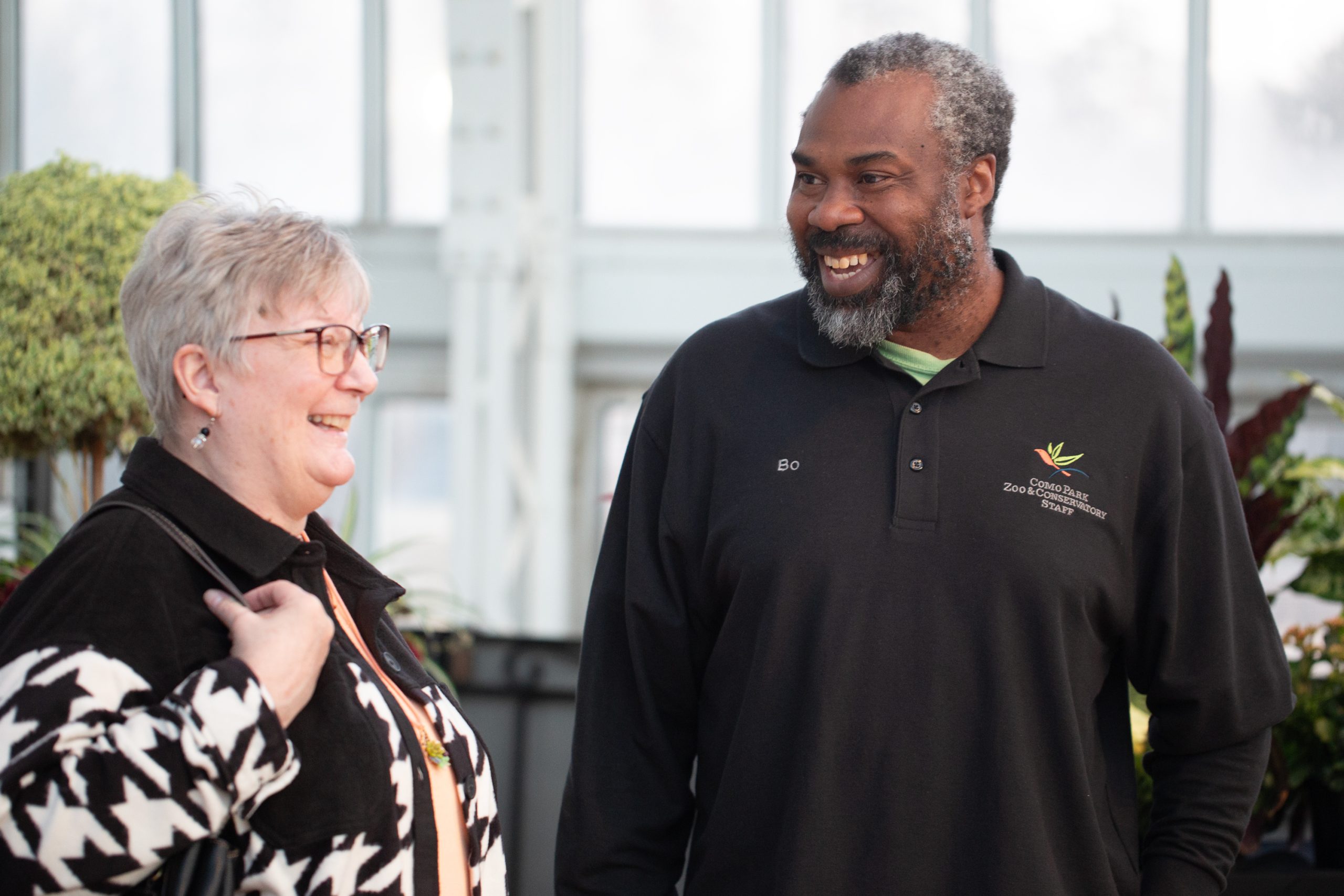
“It’s a tricky thing, because Poinsettias are a touchy, finicky plant, especially for growing at home,” Akinkuotu says. Though they’re deeply associated with the winter holidays, “They’re a tropical, heat-loving plant, and they don’t like to get too wet, or they’ll rot, and they don’t like to get too dry, or they’ll wilt. You have to find that sweet spot between the two.”
A member of the Euphorbia family, Poinsettias can only come to life during the darkest days of the year. “The interesting thing about them is that they really need these shorter days to start showing and changing their colors through the bracts, which are the showy part of the plant,” he says. Climate control is another key ingredient to keeping these plants at their best. “They’re unhappy in chilly weather, but if you can keep the temperature in the low to mid 70s, they’ll usually last until the end of the holiday season.”
Thanks to your contributions to Como Friends, the Marjorie McNeely Conservatory’s Holiday Flower Show is always free, and is open from 10 a.m. to 4 p.m. every day of the week, including Christmas and New Year’s Day.
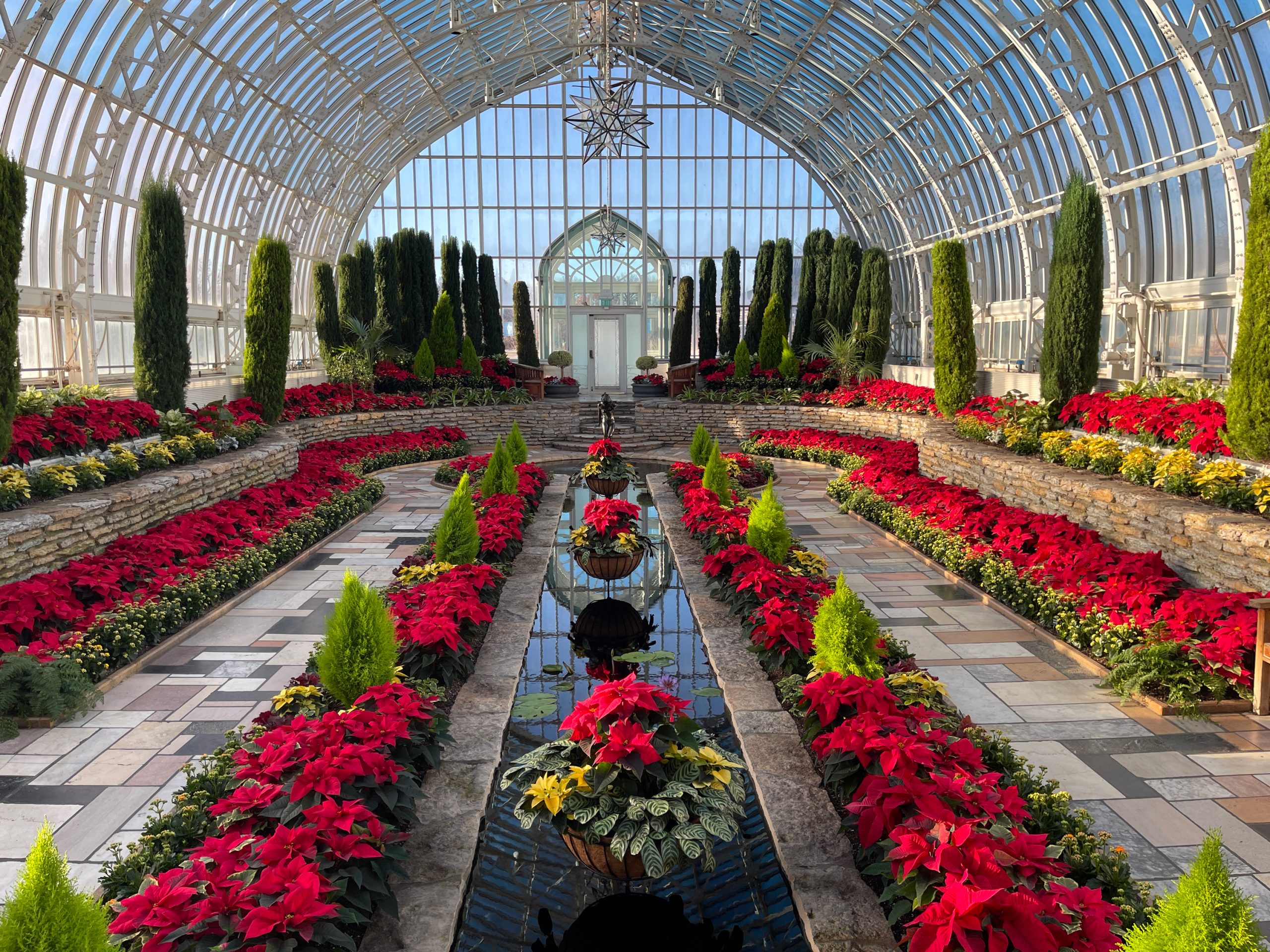

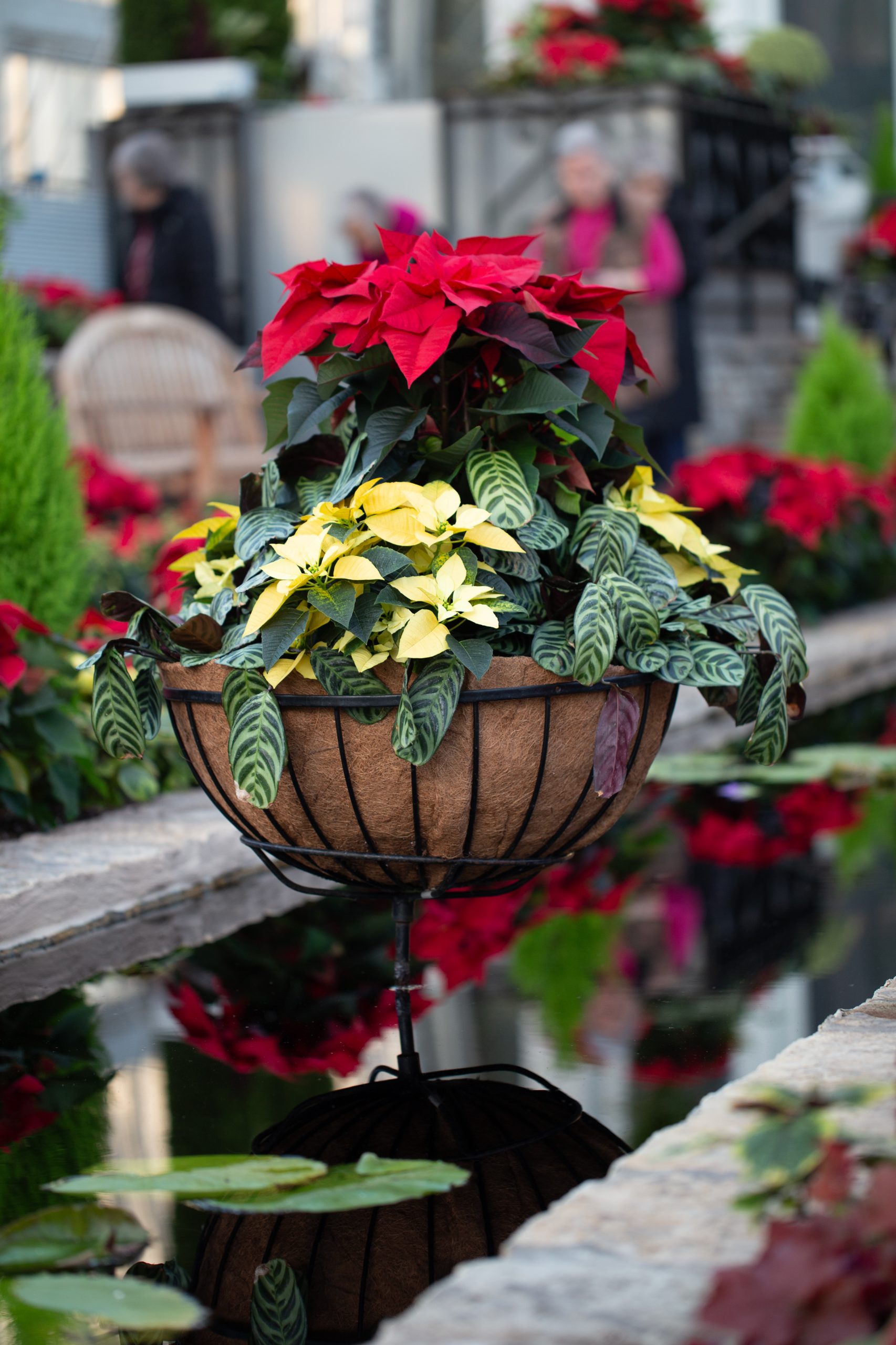
Caring for polar bears every day can be exhausting. Just ask Como Zoo’s Julie Yarrington, one of a team of aquatics keepers who keep an eagle eye on Como’s three polar bears, Nan, Kulu, and Neil.
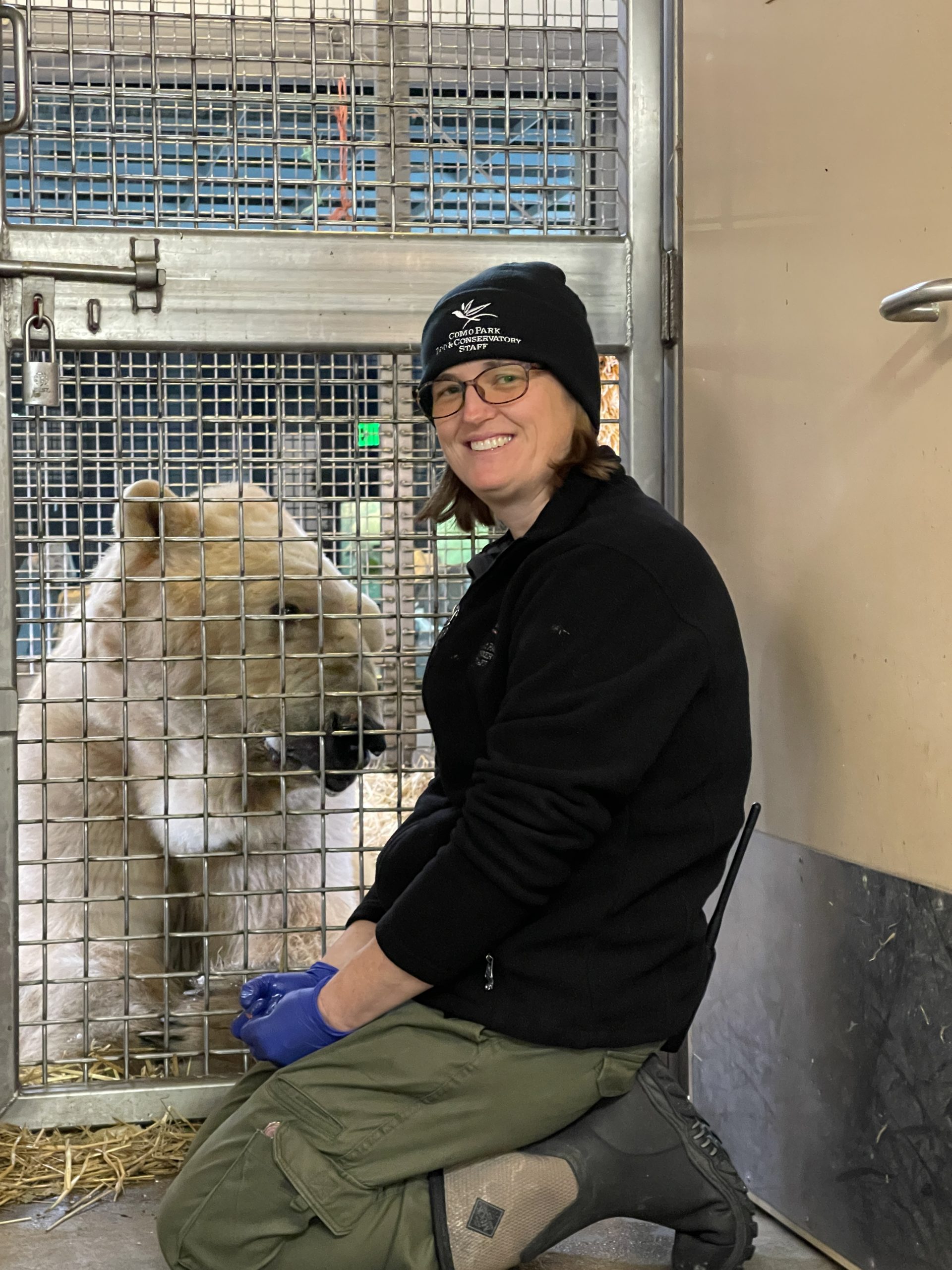
Earlier this year, Neil was diagnosed with gastric dilatation-volvulus, or bloat, an urgent medical condition that required emergency surgery. Surgery is a risk for any animal, but especially for one as old as Neil, now nearing 28 years of age, and one of the oldest male polar bears in North America.
“Because of his age, there was a high risk that he wouldn’t rebound,” says Yarrington, who spent more than a month “just hoping we could get him to eat, eat, eat. It was very mentally exhausting.”
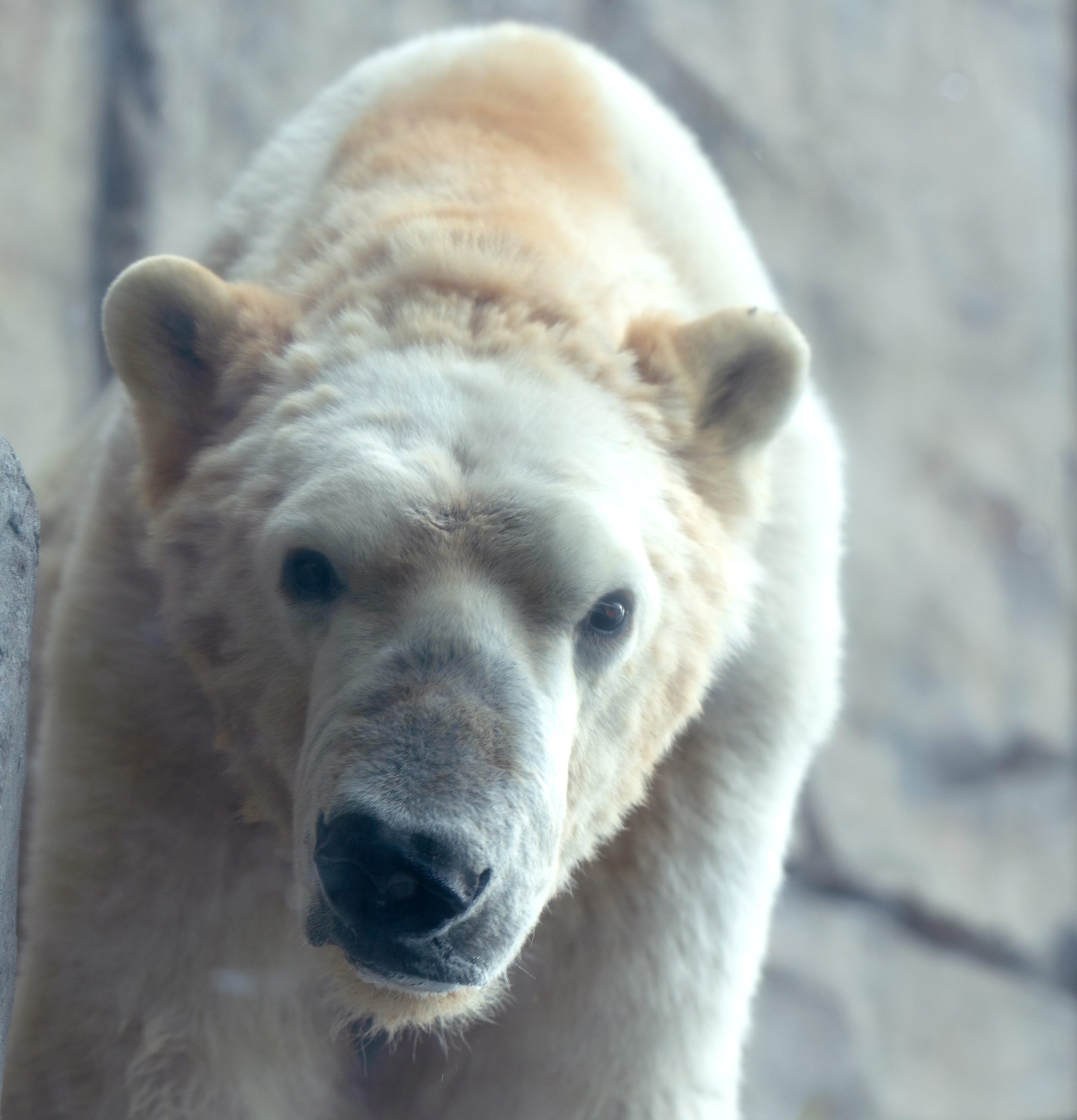
Fortunately, after a few weeks, Neil pulled through and has been very particular about his diet, showing a strong preference for his favorite comfort food of canned salmon and canned tuna. As Neil has regained strength and been reintroduced to his companions, keepers have changed the polar bears’ feeding schedule to cut Neil’s risk of further complications. “Instead of getting a big breakfast in the morning, we now feed him three to four times a day,” Yarrington says.
To allow his incision to heal, Neil had to stay out of the water and away from his favorite companion, Nan, a feisty 28-year-old female. Brought to Como Zoo three years ago in order to be a non-breeding partner to Neil following the death of Buzz, his twin brother, the pairing between the two elder bears has worked out beautifully.
“Neil just wants to be wherever Nan is,” says Yarrington. “It was hard for him at first, but once it healed up he was able to get to the pool and was able to clean himself up. Guests may not really notice his incision site, which is already covered up by fur.”
Your Give to the Max Day contributions to Como Friends help to provide cutting-edge veterinary care to animals like Neil, ensuring both great veterinary care and the creature comforts that keep animals healthy and curious. “While he’s been recovering, he’s also been into his other favorite foods, Cool Whip and sherbet—in moderation,” Yarrington says. “When you live to be the oldest male polar bear in North America, you definitely deserve a couple of spoonfuls of sherbet.”
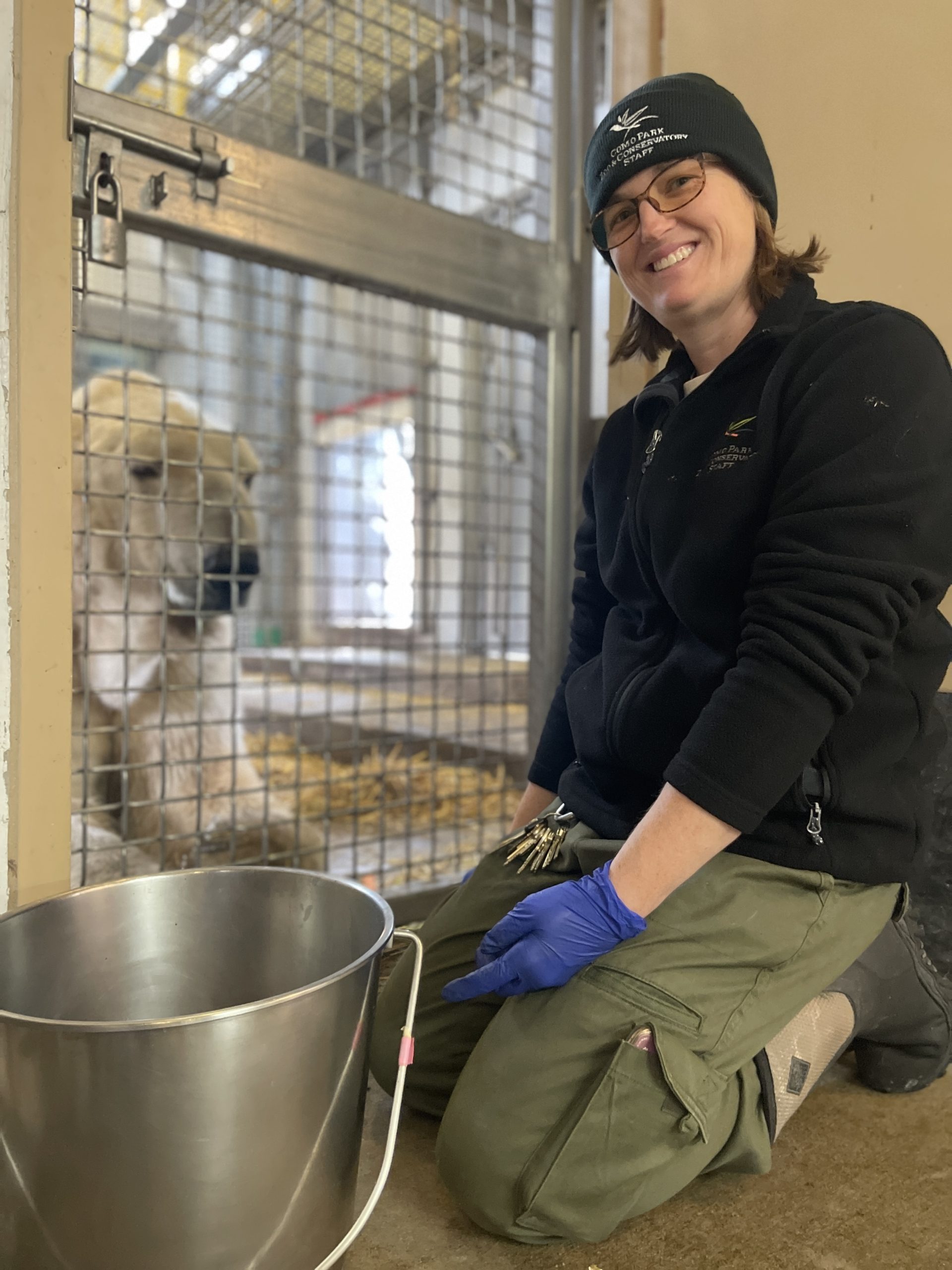
Make your Give to the Max Day gift here. Thank you!
A trip to the Polar Bear Capital of the World helped teach Como Zoo keeper Kristin Riske new ways to talk about climate change
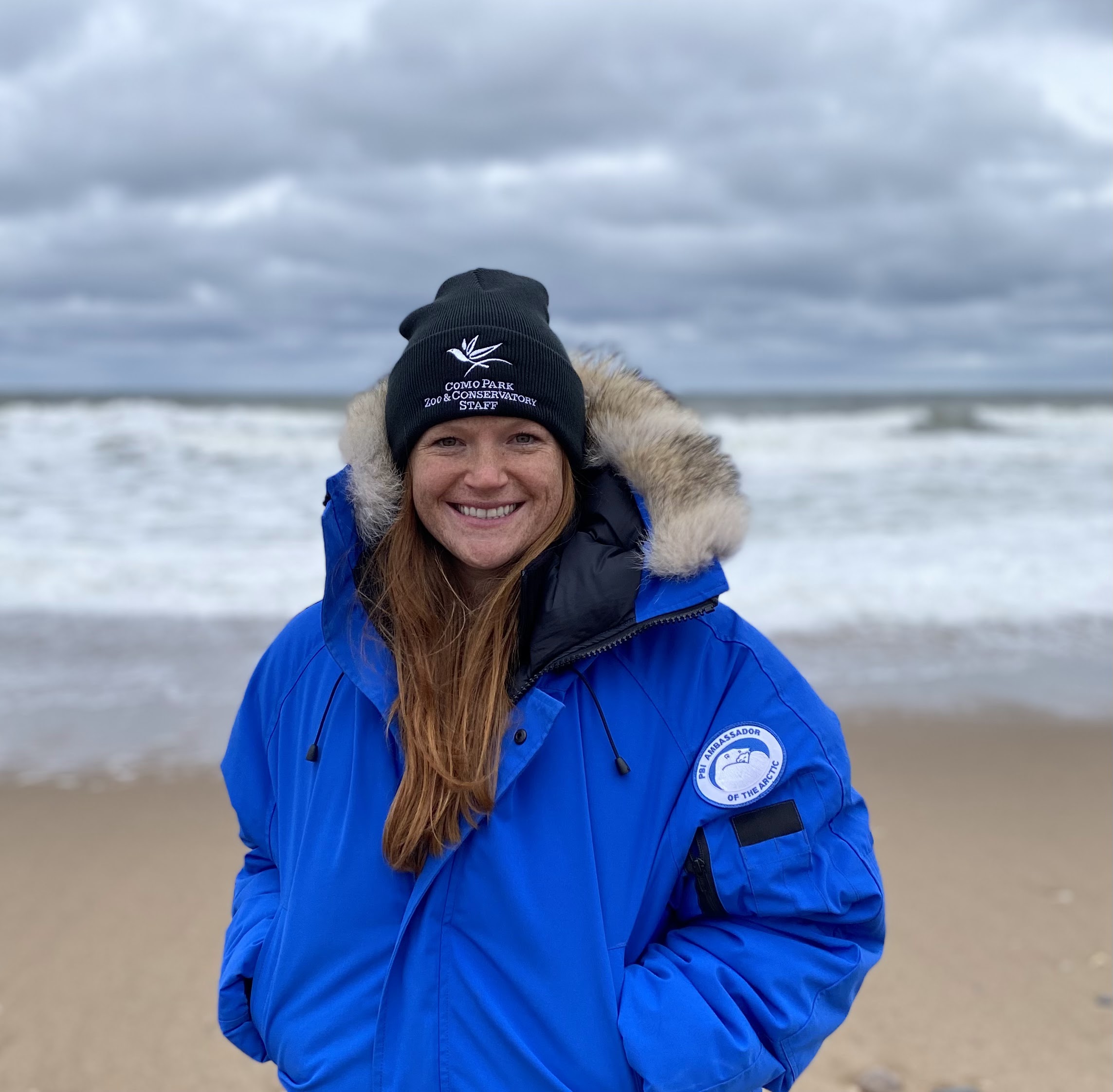
Back in 2008 when the polar bear became the first animal listed under the Endangered Species Act to be threatened primarily by climate change, we all learned how individual choices here at home can help improve conditions in the Arctic. From turning off unneeded lights, to driving less, to choosing products with less packaging, many zoo visitors at Arctic Ambassador Centers like Como Zoo are now well-versed in all the individual choices that can contribute to a more sustainable future.
But could there be a better way to talk about what’s happening to polar bears?
That’s the question Como Zoo aquatics keeper Kristin Riske has been exploring as a Conservation Champion, the Como Friends program that funds professional development experiences and on-site field work for several zookeepers and horticulturists each year. With support from the program, Riske joined a cohort of other keepers and educators in the Climate Alliance Program, a unique Polar Bears International partnership program aimed at empowering conservation professionals—many, like Riske, who care for polar bears every day—to effectively communicate about climate change and inspire real-world solutions.
“Como has been part of the Arctic Ambassador Network for years, and this program is designed especially for institutions like ours,” Riske says. “As zookeepers, we’re in a great position to get the message out to the public.”

The program started early in 2023, as Riske and other zookeepers and educators took part in an eight-month online learning course, created in partnership with National Network for Ocean and Climate Change Interpretation. Through the training, Riske learned about the latest best practice communication strategies around climate change, and how building awareness and support for climate solutions has evolved over time.
“Having this training through Climate Alliance really changed my view on how to get the message across,” says Riske, who got her start as a Como Zoo intern back in 2014. “Back when I started, it was all about how we should turn off our lights and recycle, but through this program, I’ve learned it’s more about the collective action that we need to take—voting for the climate, creating community gardens, shifting to renewable energy, advocating for community-wide or city-based sustainability programs.”
Last month, the Climate Alliance Program culminated in a week-long trip to Churchill, Manitoba, the polar bear capital of the world. “It was really early in the season, still in the 40s and 50s, so we only saw one bear—a female sleeping near the coast,” Riske says. “But being out in the Tundra Buggy exceeded my expectations in every way. We got to see ptarmigan and caribou, and got the chance to meet and talk with the indigenous people of Churchill who told us more about the land around us.”
Now back at Como Zoo where she cares for polar bears Neil, Nan, and Kulu, Riske says her Conservation Champions experience continues to inspire her. “There really are no words to encapsulate what I experienced,” she says. “I went into this Climate Alliance program to learn more about polar bears, climate change, and what we can do to help. What I didn’t know was the bond I would form with all of these amazing people from different facilities that want to do the same thing. I am still processing my experience up in Churchill, but one thing I do know is I have become more empowered, and a spark has grown in me that wants to advocate for climate change. I can’t thank Polar Bears International, Frontiers North Adventures, Como Park Zoo and Conservatory, and Como Friends enough for this once-in-a-lifetime experience.”

Your support for Como Friends helps to make the Conservation Champions program possible, supporting Como’s talented staff’s participation in conservation partnerships and in their continued professional development. Thank you!
The dazzling colors of Día de los Muertos are the inspiration for the second half of the Sunken Garden’s fall flower show now on display.
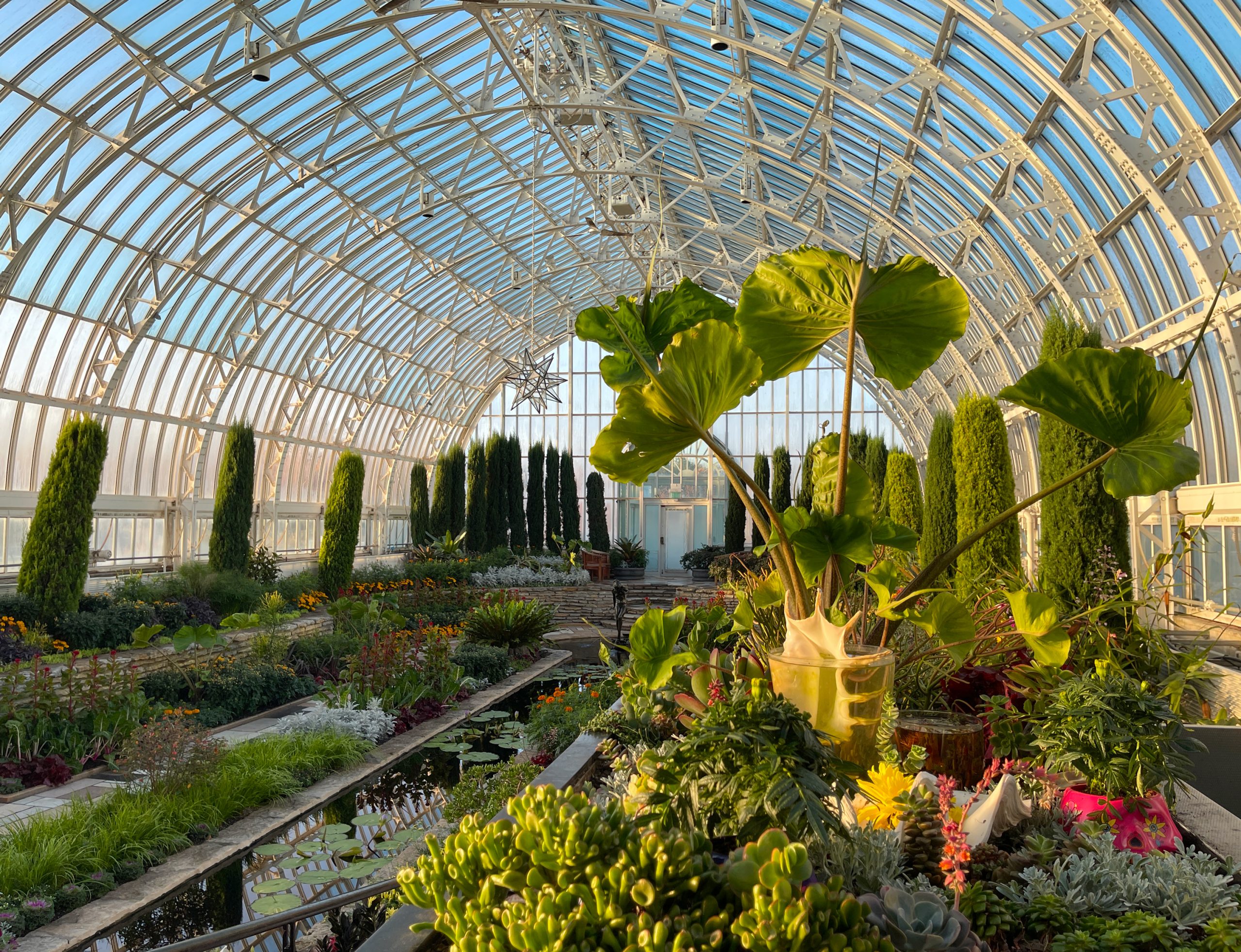
“As gardeners, we’re always interested in trying new things in traditional spaces,” says Lisa Philander, the Marjorie McNeely Conservatory’s horticulture curator. “The goal was to create a feeling of undulating waves of color, rather than making each side of the room a mirror of the other.”
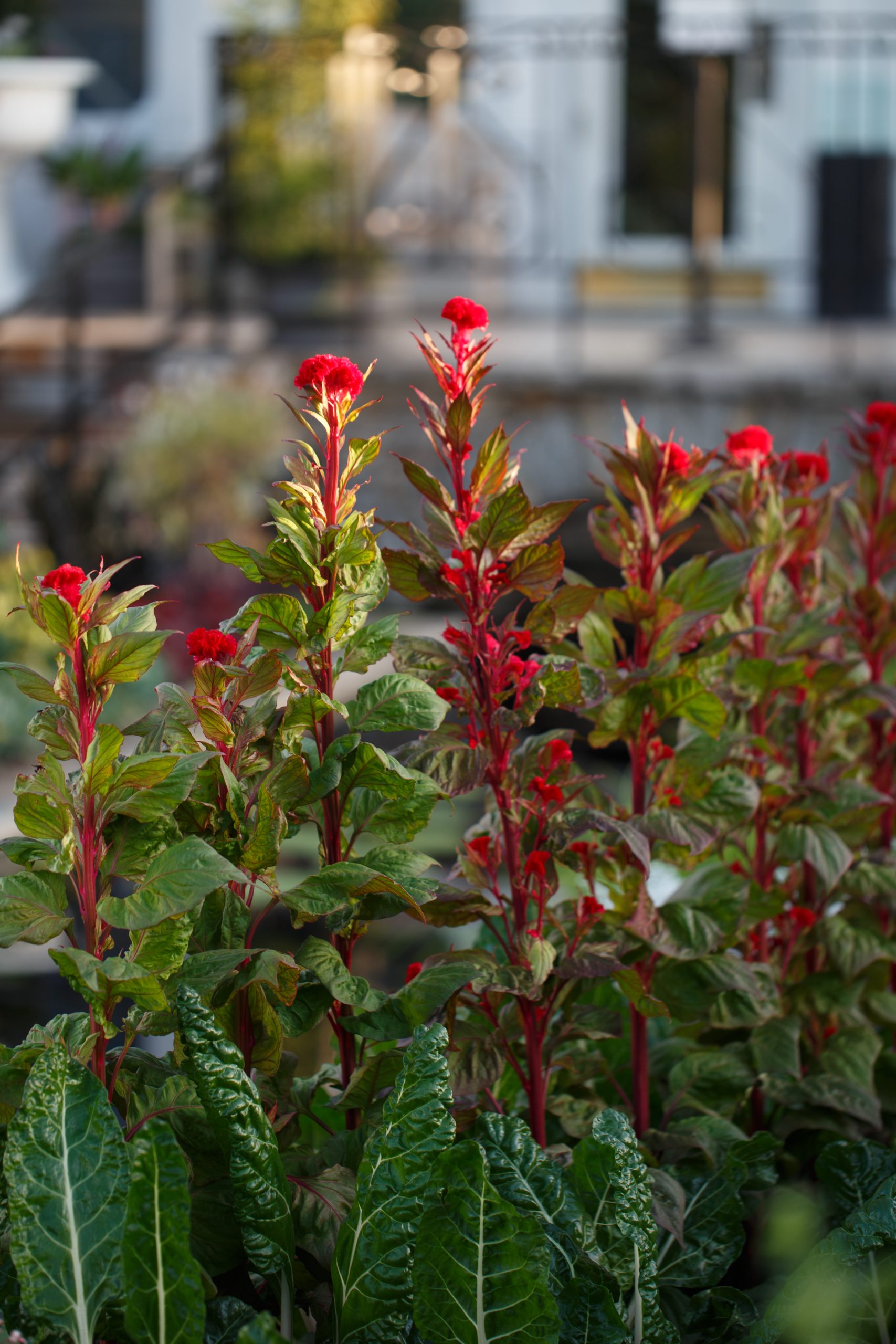
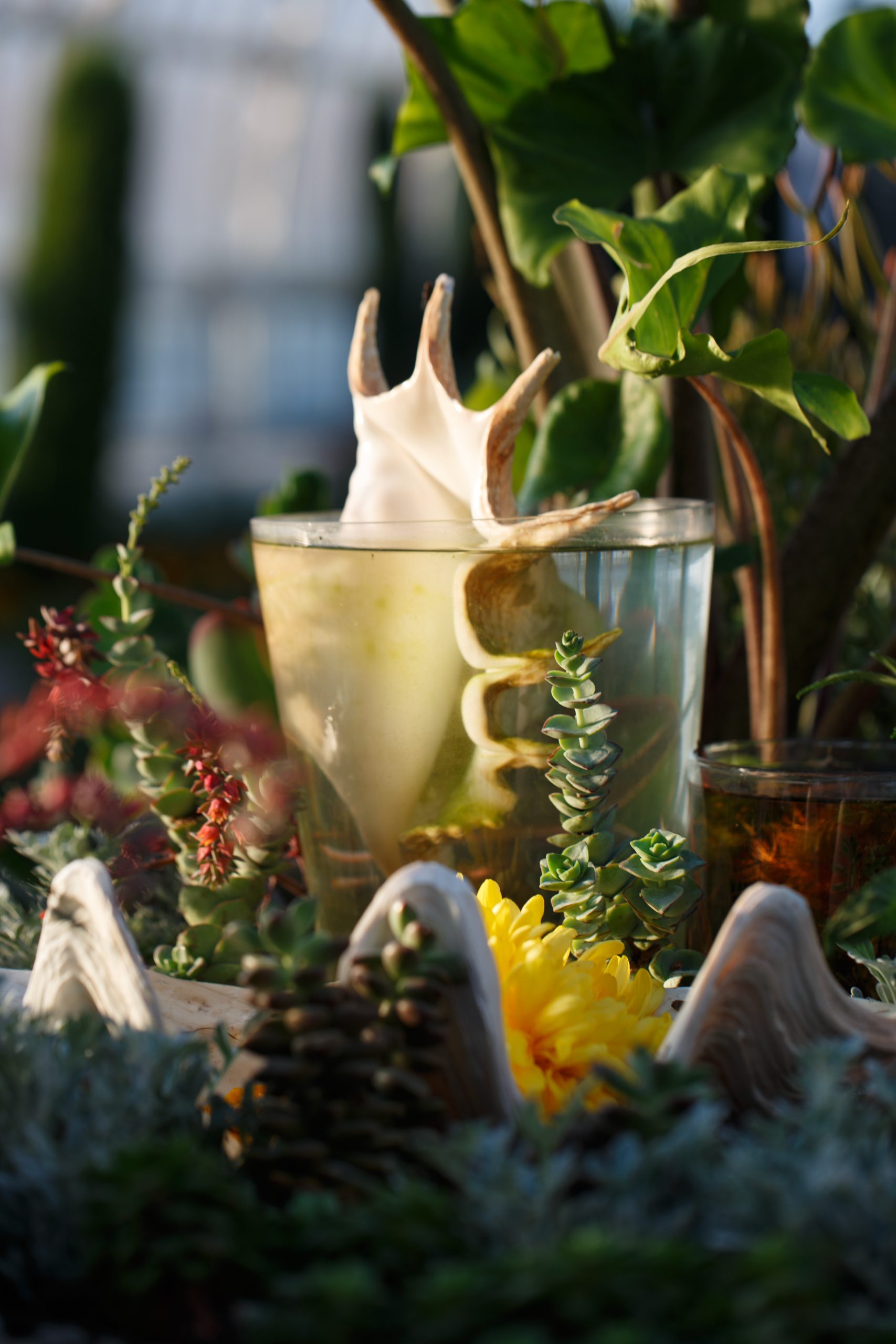
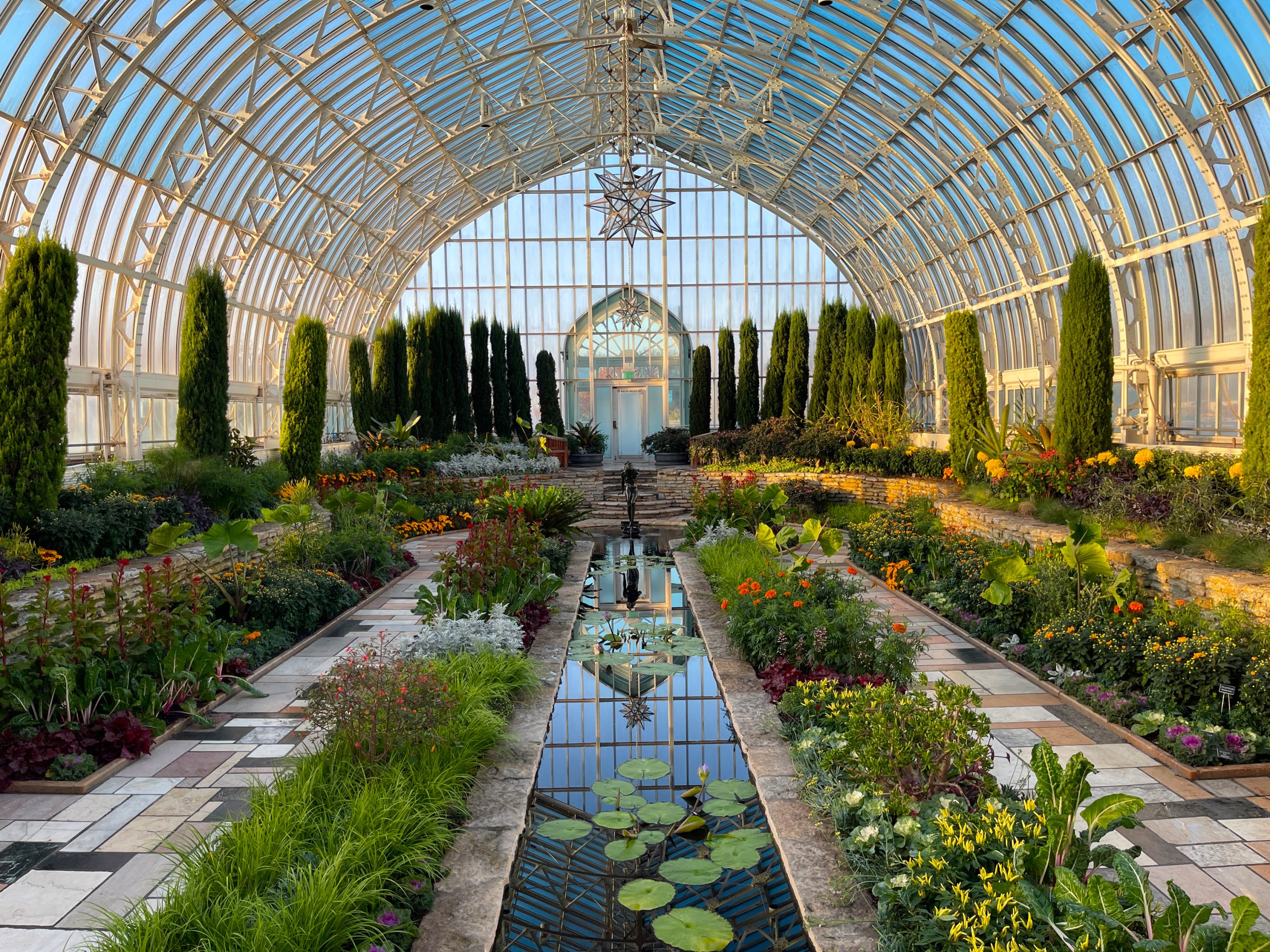
The dazzling colors of Día de los Muertos are the inspiration for the second half of the Sunken Garden’s fall flower show now on display. With orange and yellow mums, accented by bright magenta celosia, this season’s flower show is a fiesta for the senses.
One featured flower is the orange marigold, a Mexican native plant known by the Aztec name cempasúchil. A flower that’s strongly associated with the holiday, the color and fragrance of marigolds are said to show departed souls the path to their family homes. Gardening sources report that demand for marigolds has also risen considerably since the 2017 Disney Pixar film Coco, which introduced a worldwide audience to the customs of Día de los Muertos.
Visitors to the Sunken Garden may also notice that the design of this season’s Fall Flower Show is asymmetrical, breaking up the bilateral design pattern that’s commonly been used in the room. “As gardeners, we’re always interested in trying new things in traditional spaces,” says Lisa Philander, the Marjorie McNeely Conservatory’s horticulture curator. “The goal was to create a feeling of undulating waves of color, rather than making each side of the room a mirror of the other.”
Always free to visitors thanks to your contributions to Como Friends, the Sunken Garden Fall Flower Show is now on display through November 26.
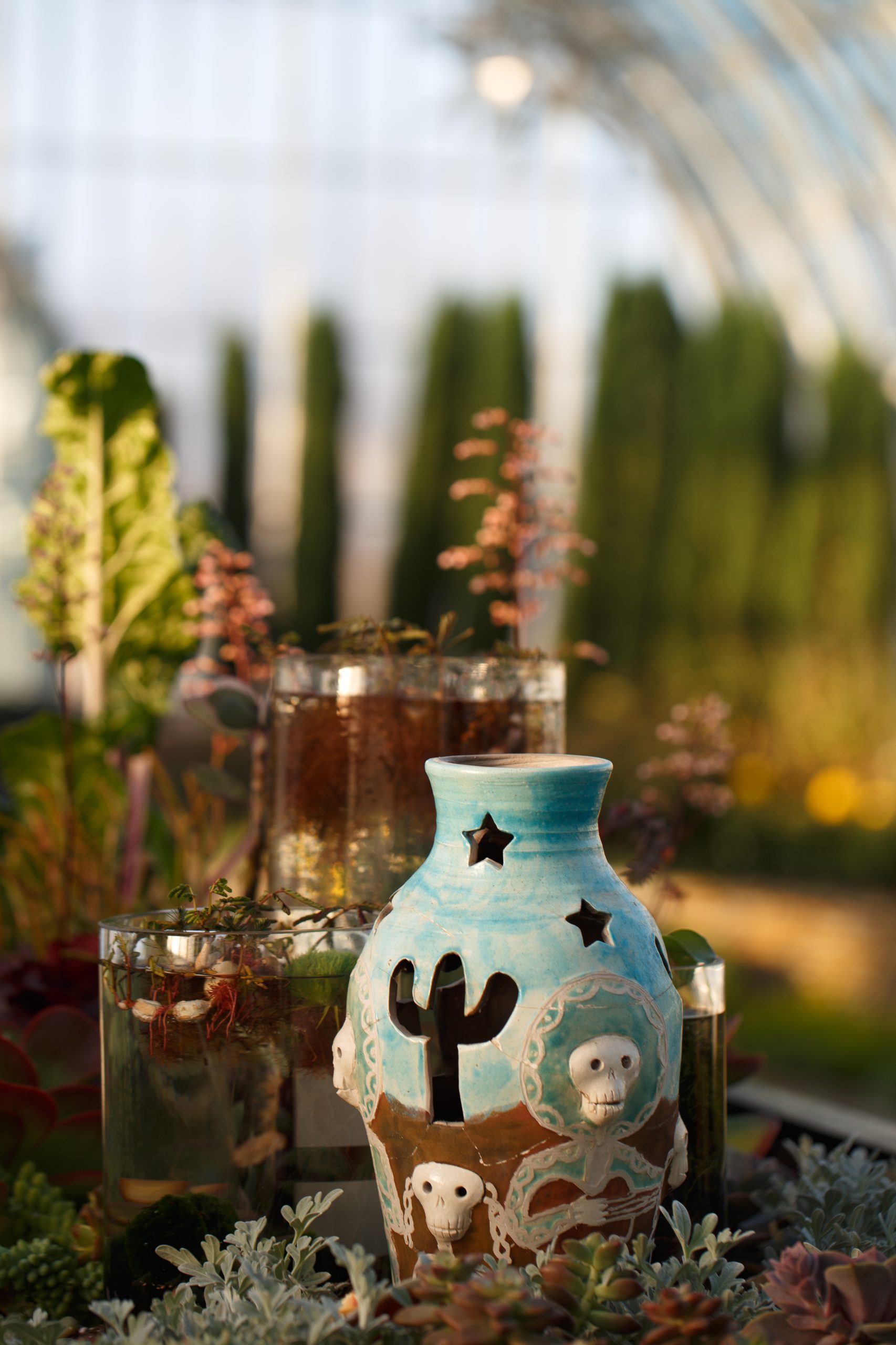
With chrysanthemums playing the starring role in this season’s Fall Flower Show, it’s a guarantee that thrips will also be part of the cast.
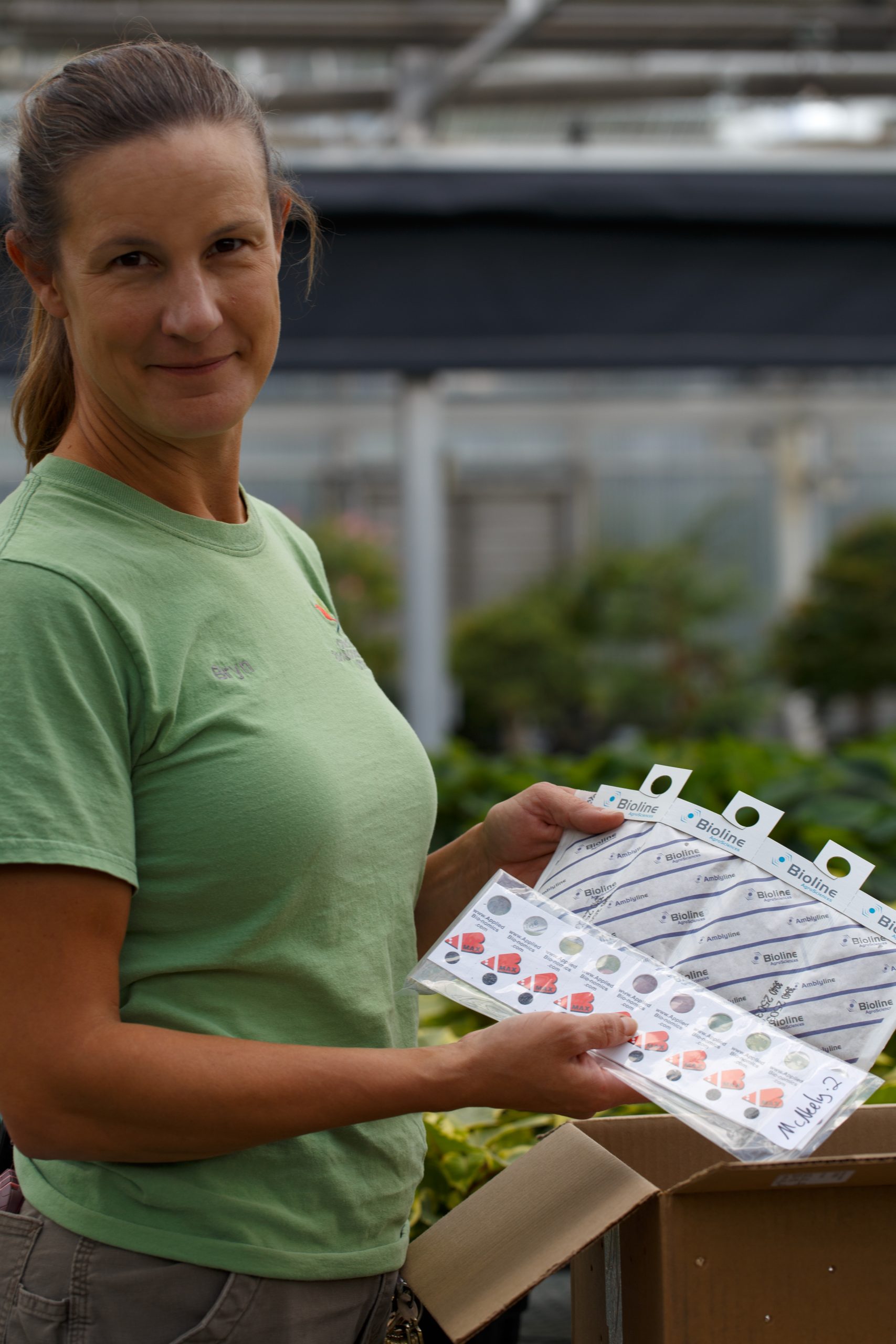
Also known to gardeners as thysanoptera or thunderflies, these needle-thin sucking insects love to feed on mums, causing damage to plants, or worse, transmitting viruses from one plant to the next.
Fortunately, Como’s horticulturists have a tiny but mighty weapon to keep thrips from ruining the show. Known as the cucumeris mite, this half-millimeter predator insect has just been deployed throughout the mum crop destined for the second half of the Fall Flower Show. With an appearance like that of a transparent wood tick, and the ability to prey on thrips and survive on plant pollen, these super small super predators play an important role in the Marjorie McNeely Conservatory’s Integrated Pest Management plan.
“People sometimes think that spraying pesticides is the only way to control pests, but integrated pest management is an approach that combines anything you might do to make a plant healthier, from the condition of the soil it’s growing in, to your nutritional program, to how you’re pruning the plant,” explains Como horticultural supervisor Bryn Fleming. While Como has been a low-pesticide growing facility for decades, Fleming says, “our reliance on beneficial insects has increased more recently,” as the gardening industry embraces more sustainable ways to manage greenhouses and gardens.
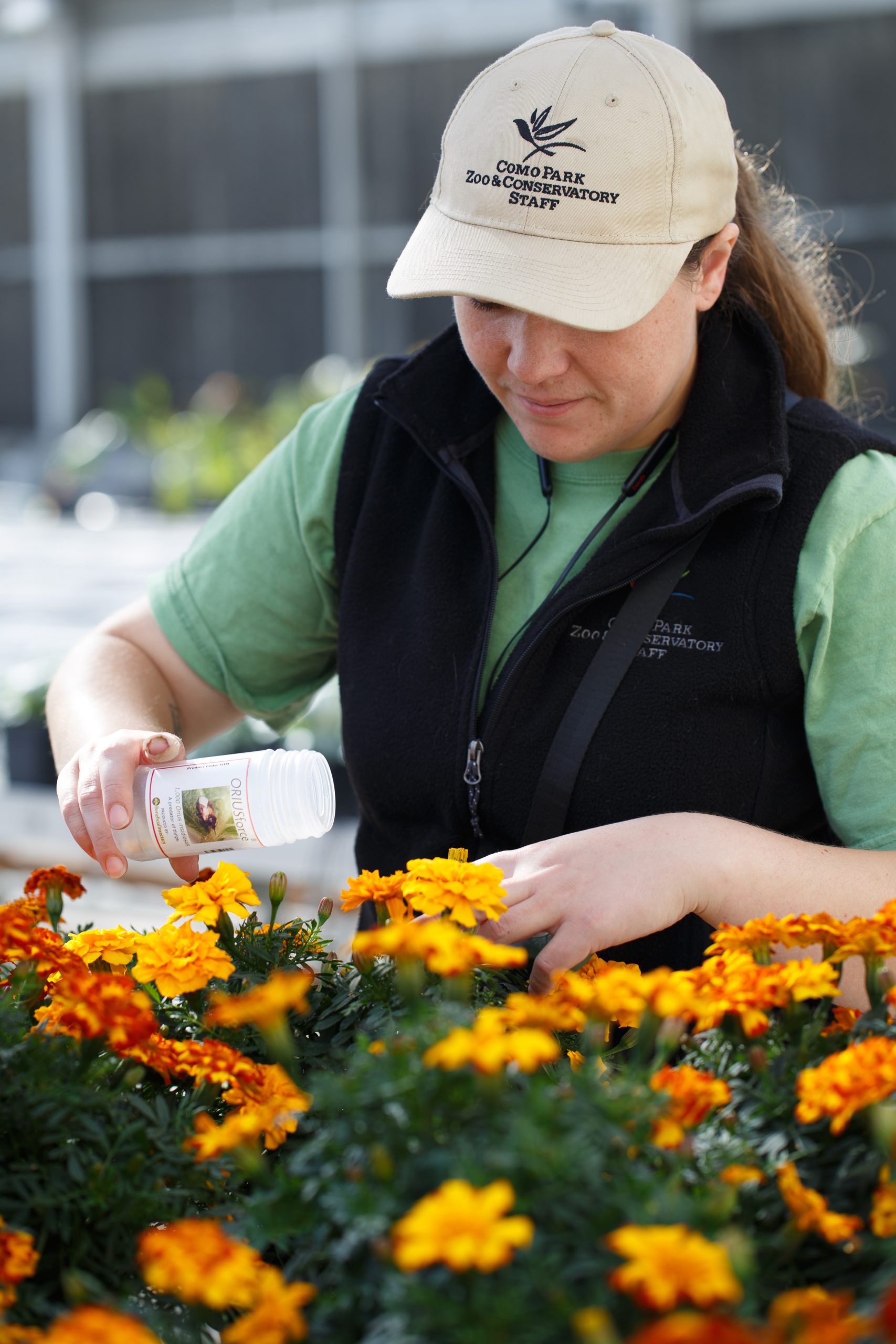
While beneficial bugs show great promise in cutting the use of pesticides, monitoring how well predator insects perform can be time consuming and complex. What’s the right dosage of beneficial insects for a particular plant or crop? How do shifts in such inputs as light, water or temperature affect the efficacy of beneficial bugs? Are some pest predators better than others?
To help answer those questions, the Marjorie McNeely Conservatory is now equipped with a new integrated pest management scouting system called IPM Scoutek. Made possible by your support for Como Friends, this new digital technology tracked on a tablet allows horticulturists to collect data from greenhouses and gardens to make even more informed decisions about how to care for crops and manage pests.
“This technology is used by large-scale growers who are producing bigger agricultural crops, but is also used for nursery or floriculture production.” says Horticulturist Jen Love, who recently shared news about Como’s software scouting system during an American Public Gardens Association symposium at the Franklin Park Conservatory and Botanical Gardens in Columbus, Ohio. “As far as we know, as a public garden the Marjorie McNeely Conservatory is an early adopter trying this approach, and there’s a lot of interest from other institutions in seeing how this process works. If it’s successful, it’s a model we can share with other botanical gardens.”
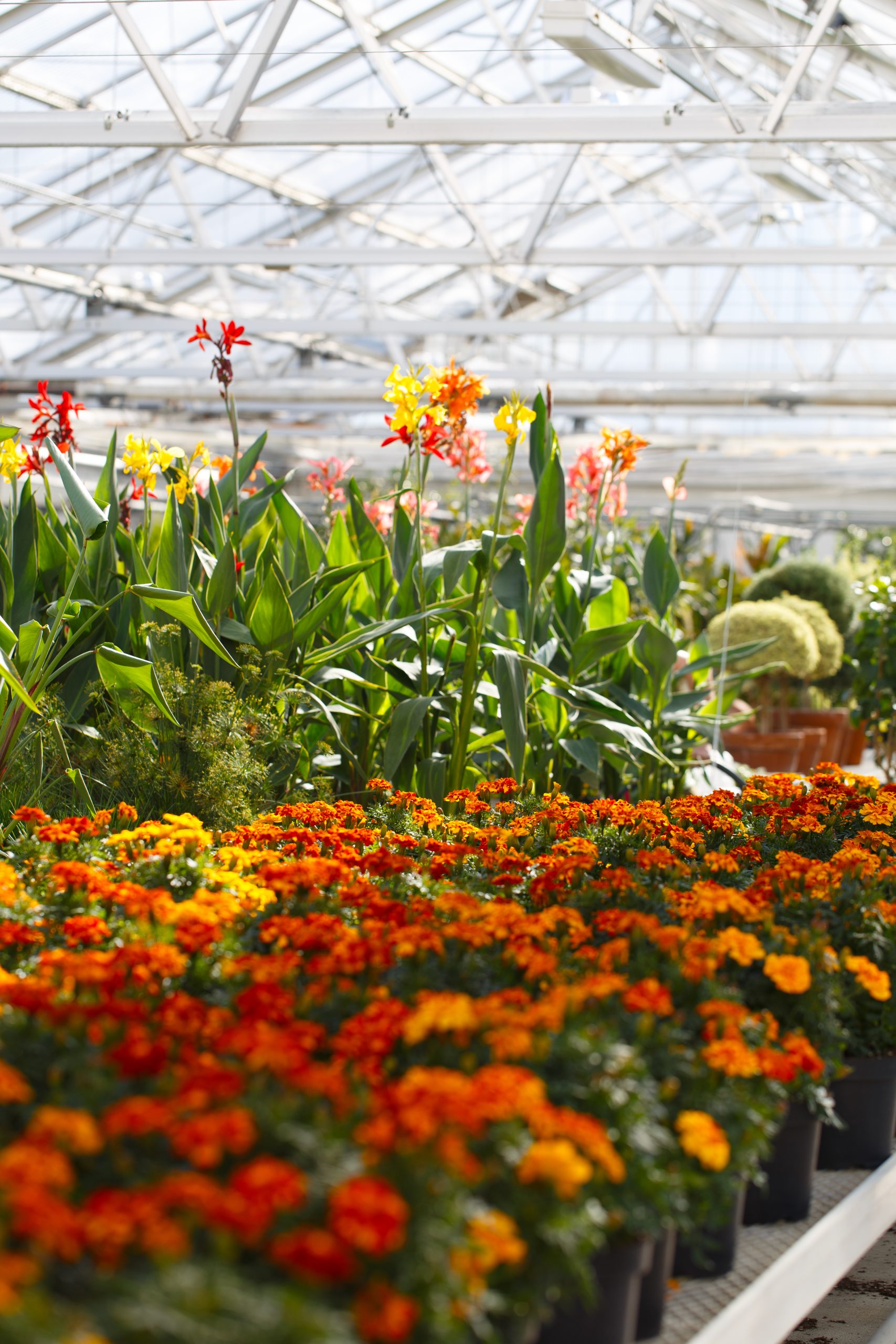
As Como’s horticulturists discover what digital technology can do for pest management, Fleming says the Conservatory’s early adopters are already impressed by what they’ve seen. “I think this software is going to help us to keep track of things at a much closer level, so when problems come up we can respond to them even sooner,” she says. “To care for a living collection requires constant adaptation, and this technology will help us be a little more proactive than reactive.”
Conservation Champion Jill Erzar traveled to Tanzania to help Wild Nature Institute track giraffe across the Serengeti
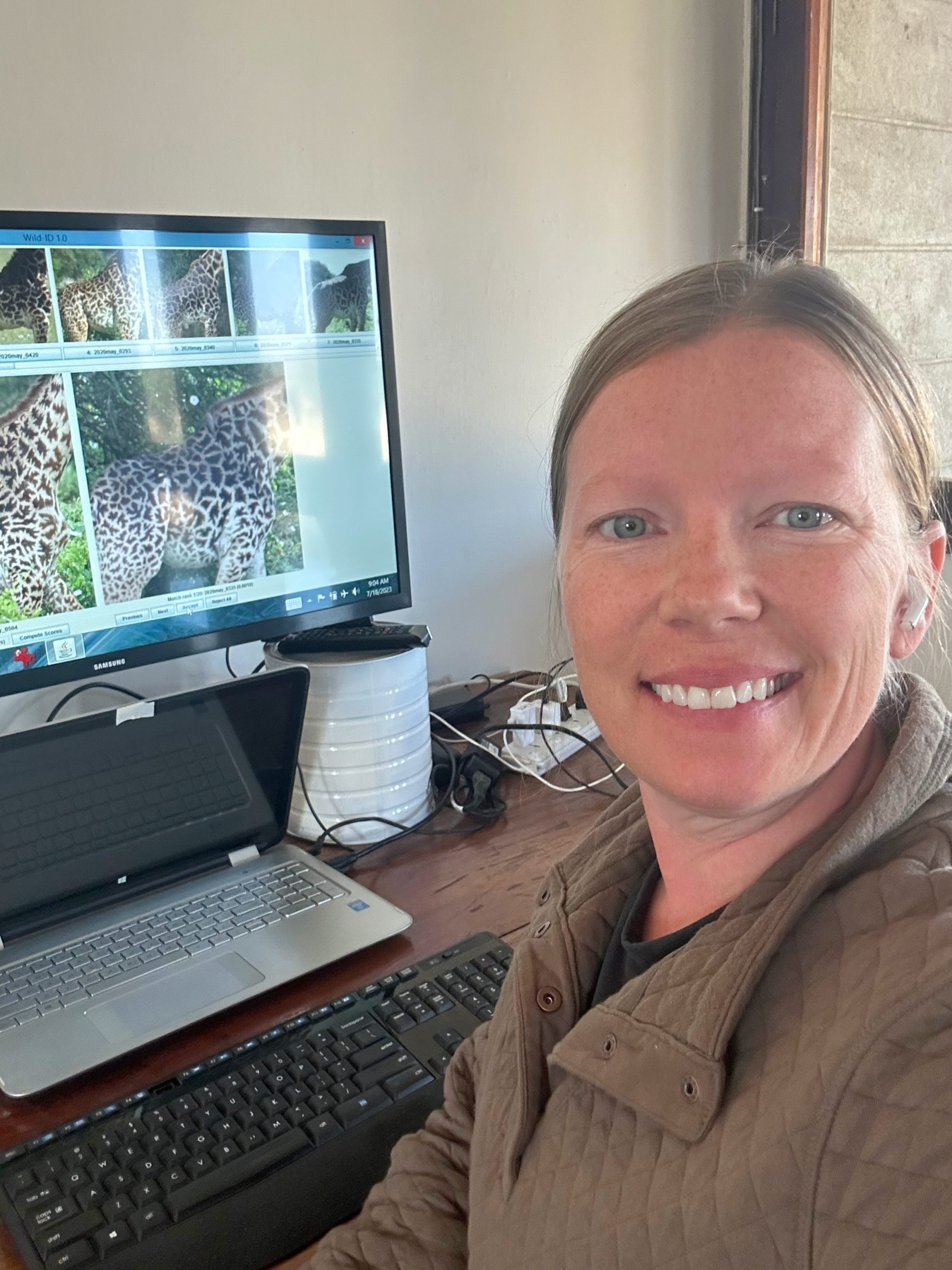
“Giraffes have been very underestimated, and under-researched for a long time,” says Como Zoo keeper Jill Erzar. “But over the last decade or so, that’s begun to change, and we’re beginning to understand that giraffes are, in fact, highly intelligent, with social hierarchies and relationships that are as complex as elephants and chimpanzees.”
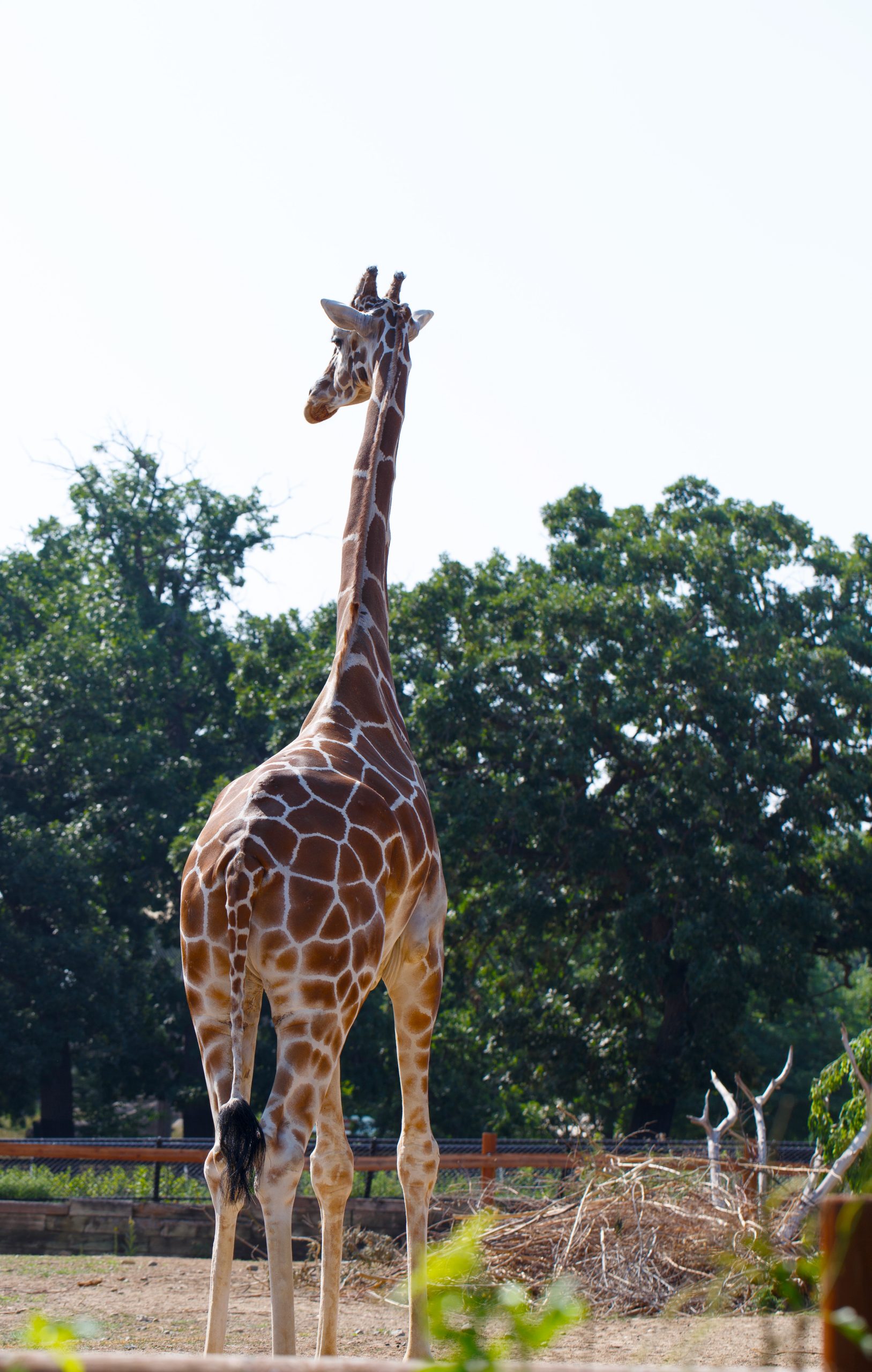
Reaching heights of 18 feet and beyond, giraffes are the tallest mammal on earth.
But with brains that are relatively small compared to their body size, scientists haven’t always been sure if their elevators go all the way to the top.
“Giraffes have been very underestimated, and under-researched for a long time,” says Como Zoo keeper Jill Erzar. “But over the last decade or so, that’s begun to change, and we’re beginning to understand that giraffes are, in fact, highly intelligent, with social hierarchies and relationships that are as complex as elephants and chimpanzees.”
Thanks to a recent grant from Como Friends’ Conservation Champions program, Erzar herself has been contributing to that body of research as a volunteer for the Wild Nature Institute. The conservation group behind the largest demographic survey of giraffes in the world, Wild Nature Institute takes a non-invasive approach to giraffe research, relying entirely on photographic identification to track the births, deaths, movement and social bonds of about 4,100 individual giraffes across 25,000 square miles of the Tarangire and Serengeti ecosystems in Tanzania.
As a seasoned giraffe keeper who can spot the subtle difference in every giraffe’s unique markings, Erzar’s well-trained eye and expertise were a welcome skill set on the Serengeti this summer, as the conservation group worked to compare and analyze more than a decade’s worth of data about wild giraffe. “I was able to make more than 9,000 matches during the 10 days I spent in country,” says Erzar, who also got the chance to meet and learn from giraffe experts in the field. “For me the biggest take-away from this trip is that giraffes need protected areas because poaching is still their number one risk. Even with projected climate change impacts in that area, nothing threatens their survival as much as illegal hunting and poaching.”
Though it will take time for Wild Nature Institute’s findings to be published and shared more widely with other conservation researchers, new discoveries about giraffes are coming to light all the time. For instance, scientists who once considered giraffes to be aloof and anti-social have discovered that in fact, giraffes live in complex social systems and super communities, and even prefer to eat with favored companions. A 2023 study found that giraffes are capable of statistical reasoning, while a 2021 study found that giraffes prefer a fair fight, and will only spar with individuals of the same size. Another growing topic of interest within the giraffe field is the so-called “grandmother hypothesis,” a theory that suggests that menopausal female giraffes may have an important role to play in raising young.
“It’s really cool to see that giraffes are finally having their moment, and I absolutely love being on the forefront of a group that believes that non-invasive [data gathering] is the best way to study them,” Erzar says.

Como Friends’ Conservation Champions program, funded with donations from our generous supporters, has made it possible for Jill to travel to Africa three times in recent years, supporting conservation partners in the field, while bringing home new experiences and insights that can help enhance the care she gives to animals at Como Zoo every day. “Making the trip to work with Wild Nature Institute helps me to tell the story of our own giraffes better,” she says. “I can tell visitors that our giraffes really do look and behave just like the giraffes in Tanzania. And the more we learn about giraffes, the more we can do to improve their welfare in the wild and here at Como.”
Blind at birth, Como Zoo’s newest snow leopard is using her other four senses to explore her new world
One of the most anticipated new arrivals at Como Zoo, the seven-pound female snow leopard born on May 6 is taking her time getting acquainted with her new world. Like all snow leopard cubs, spending quality time with her mother is crucial to getting a good start in life.
“With snow leopards, the father is involved in the breeding process, and then he is actively pushed out of the environment in the wild,’’ explains Como Zoo keeper Hans Jorgensen. That’s why Como visitors may notice that father Moutig is almost always outside in the snow leopards’ public habitat, while mother Alya has been behind the scenes, nursing and bonding with her newest cub. “Alya’s an excellent mother, and with this cub, she’s 100 percent invested.”
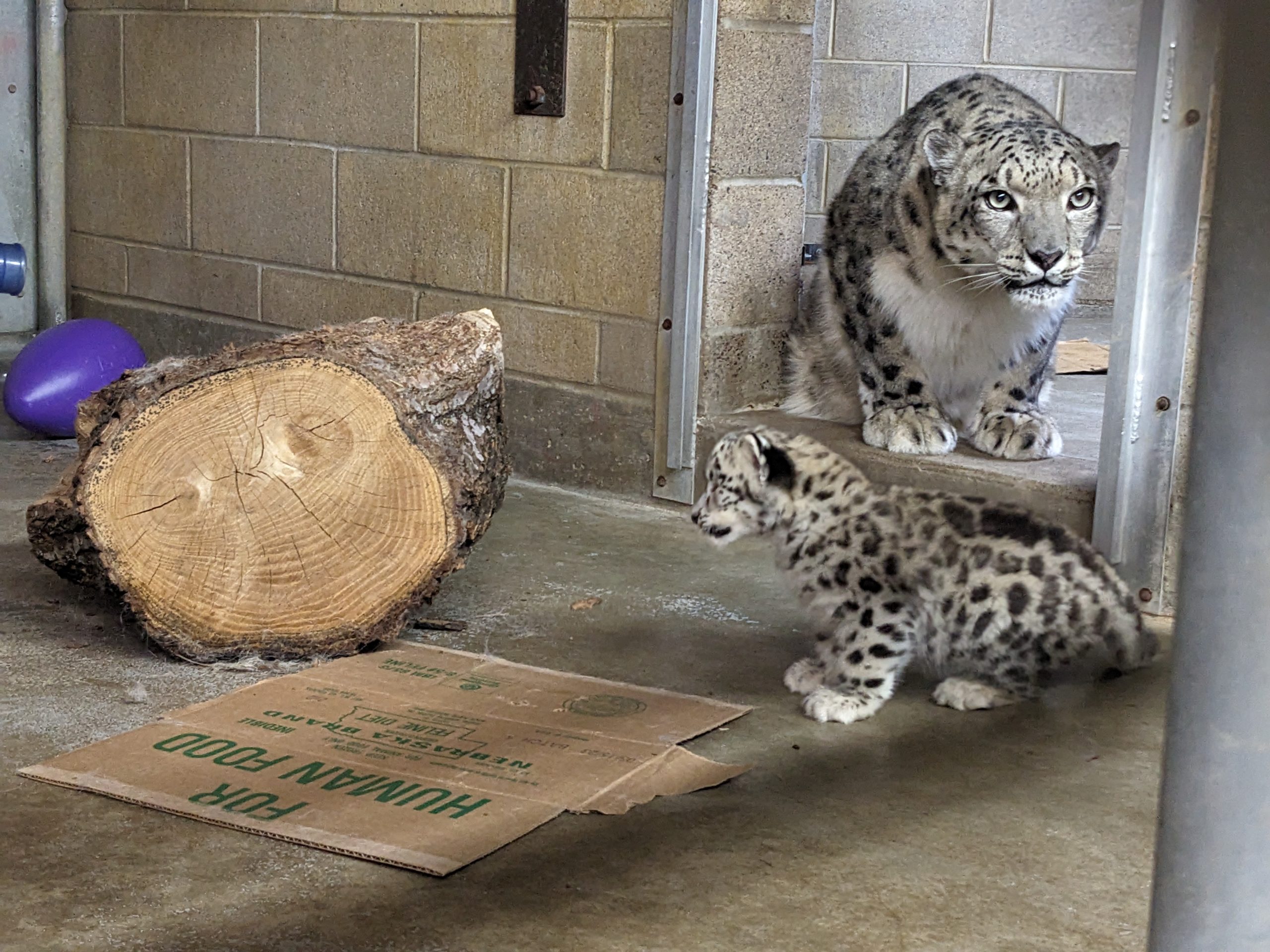

Alya’s fierce pride and strong maternal instinct are also providing keepers a hopeful sign of the long-term health prospects for the new cub, who was born with a set of eyelid abnormalities that keepers noted at her birth. Veterinary ophthalmologist Dr. Melissa Lively recently confirmed the diagnosis as Multiple Ocular Colobomas—a lack of retinal and other eye tissue—a permanent condition that can’t be reversed or repaired. “She will be blind the rest of her life,” Lively explains. “But because she’s never had vision, she’s never known anything different, and she’ll be able to do everything a normal snow leopard cub could do. We know that cats are fantastic at using their touch, their hearing, and their sense of smell to explore their habitat and run zoomies just like a visual cub would do. In the wild, this cub would not survive moving through vast environments without being able to see where prey is coming from, but in this zoo setting blind cats can thrive. Especially with all of the great care they get at Como Zoo.”
While the young cub may need surgery in the near future to prevent infection and other complications, lack of vision is unlikely to impair the longevity or welfare of the young snow leopard, now about eight weeks old and about as many pounds.
Moutig
Alya
“Baby and mom are doing great, and I don’t even know if Alya can tell that her cub has no vision,” says Jorgensen. “Six weeks is the point where snow leopard cubs start to get super active, and though she’s blind, she’s very mobile and seems to love exploring.”
An eager eater, the young cub is also busting her way through the baby growth charts. “She’s a milk-drinking machine,” Jorgensen says proudly.
While she’s hitting all of her developmental milestones, her keepers are also being mindful about ways to make her as comfortable and curious as possible as she grows into her new home. “Milestones for her agility might be pushed back a little later as she figures out the geography of her habitat,” he says. “There might be some accommodations we’ll make for her, things we’ll need to be aware of in terms of keeping her environment very consistent.’’
As part of Como Friends’ Sunset Affair fundraising gala this month, the winning bidder in the event’s silent auction will have the chance to select a name for the new cub that captures her native curiosity and fighting spirit.
“She’s getting fluffier by the day and her claws and paws are gigantic at this point,” says Jorgensen, who’s gotten accustomed to being scratched, clawed and peed on every time he scoops the new cub up for vet care and occasional weigh-ins. “It’s all in a day’s work, but it’s also a big deal to have a new snow leopard cub. Once we could see mother and baby were doing well together, there was a big sigh of relief, and now we’re just enjoying how unbelievably cute they are together.”
